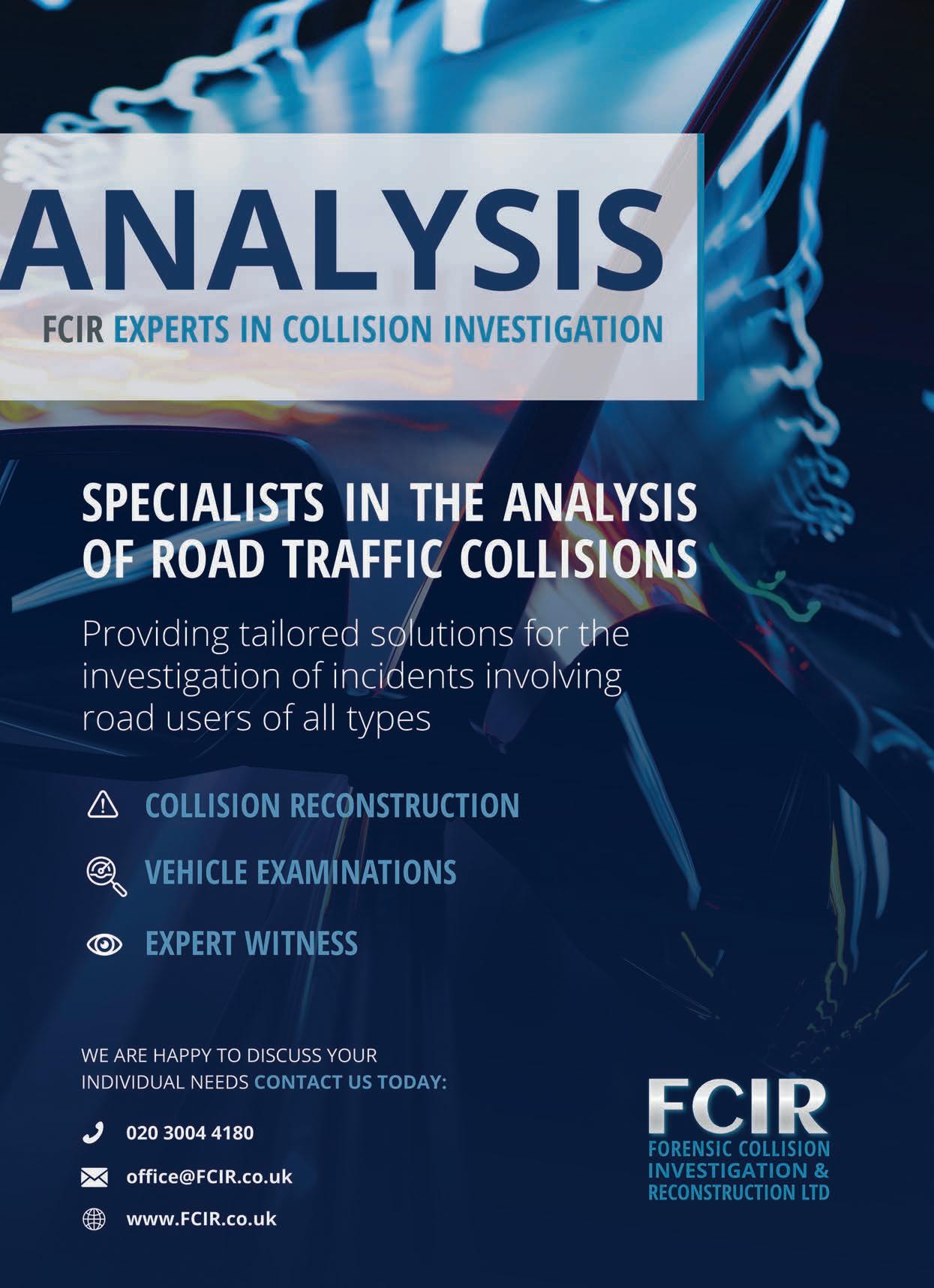













Probate fraud: investigation implicates organised crime groups 10 Legal aid moves welcome but not enough, says Law Society 11 Children still waiting too long for justice, report finds
13 Are lawyers numerate? FORENSIC
15 Regulator seeks to simplify insurance rules 15 £17.5m recovered in NCA frozen funds investigation
17 Accountants’ body fears tax adviser proposals cast too wide a net
17 FRC publish feedback from digital reporting paper
18 Guidance sets out how self-reporting can help firms avoid prosecution
FORENSIC LIPREADING
19 Lip reading: TV drama reflects the work of a select few
TECHNOLOGY
21 Set AI to catch AI: tackling the deepfake dilemma
22 What does the future hold for technology experts?
ROAD TRAFFIC ACCIDENTS
23 Driving innovation in expert witness services: the ‘Laird Approach’
23 Law firms line up to offer advice to road accident victims
PROPERTY, CONSTRUCTION & ENGINEERING
25 Planning Bill now includes easing of infrastructure planning rules
25 CIOB backs committee report on retrofitting
27 Experts help pin the blame on rogue landlords
27 Ruling confirms liability for remediation even after properties have been sold
FIRE INVESTIGATION
28 Lithium-ion safety research published
29 Expert evidence led to collapse of Crewe fire prosecution
MARITIME DISPUTES
31 The complexities of maritime law may require Supreme Court interpretation
31 Baltic helps owners meet new green regs
ENVIRONMENTAL ISSUES
32 Legislation means ‘greenwashing’ no longer cuts the mustard
33 Fiduciary duty, ESG and climate change
JAPANESE KNOTWEED
35 Japanese knotweed: what is it and what can you do about it?
36 RICS guidance debunks ‘bogey plant’ myths
TREE CARE
37 Why I apply the ‘why?’ to tree-related cases
ERGONOMICS
38 The ergonomist’s role in manual handling injury claims
A to Z guide to the websites of some of the country’s leading expert witnesses.
section for experts wishing to offer their expertise to the vast range



NEWS
49 GMC welcomes proposals for reform of healthcare regulation
49 Two bodies renew co-operation on care of deceased and tissue retention
51 New AI model brings some Foresight to predicting healthcare issues
51 Healthcare professionals’ regulator consults on FTP process
53 Police investigate Notts baby deaths
53 NI PI lawyers call for ‘duty of candour ’ law
55 Changes to SEND expert reports explained
55 Consultant referred to GMC by Coroner
57 GP registrants to be quizzed for transfusions after blood scandal
59 Intensive care faculty publishes training quality report
59 Staff fatigue poses harm to patients, research finds
61 Rehabilitation is key following traumatic injury
61 New A&E plan gets two cheers from emergency doctors
OPHTHALMOLOGY & OPTOMETRY
63 Royal college pitches into privatised cataract care scandal
65 Optical regulator launches five-year plan
65 Optometrists back call for tighter vision checks for drivers
DENTISTRY & MAXILLOFACIAL SURGERY
67 What issues surround consent in dentoalveolar surgery?
71 Dentists’ fitness to practise report paints a mixed picture
71 BDA calls on govt to ‘Make sugar the new tobacco!’
HERNIA REPAIR
73 What are the possible complications of inguinal hernia repair?
73 £60,000 awarded following hernia repair negligence
PODIATRY
74 Diabetic patient who lost toe calls for better podiatric care
RESPIRATORY ISSUES
75 Prosecutions underline respiratory risk of inhaling dust
ORTHOPAEDICS
77 Updated guidance reiterates spinal injury best practice
77 Parliamentarians investigate spinal injury effects
79 Orthopaedics body welcomes robotics assessment
PLASTIC, RECONSTRUCTIVE & HAND SURGERY
81 Audit reveals increase in cosmetic procedures in women, but a fall among men
HEARING LOSS
82 Tinnitus claim dismissed over ‘fundamental dishonesty’
TRICHOLOGY AND HAIR LOSS
83 Sometimes hair claims can arise despite taking precautions
PSYCHIATRIC & PSYCHOLOGICAL ISSUES
84 The assessment of PTSD for medico-legal purposes: what solicitors should know
85 Family Court guidance clarifies who is a psychologist
87 The psychological effects of clinical negligence: first look at the records
89 Jurors’ mental health should be considered, psychologists urge
89 Psychiatrists seek to debunk myths around cannabis
90 How expert was your expert? The importance of feedback
91 Neurodiversity wake-up call
91 Psychologists’ input to FND treatment crucial
NEUROSURGERY & NEUROLOGY
93 Diagnosing brain tumours is quicker, thanks to new procedure
93 Novel endoscopic surgery allows quicker relief from spinal pain
OBSTETRICS & GYNAECOLOGY
95 Police chiefs are latest target of RCOG abortion reform anger
97 National roll-out planned for brain injury avoidance programme
VASCULAR SURGERY
98 What are the neurological complications of vascular surgery?
CARDIOLOGY
101 Police investigate cardiology treatment at East Yorks hospital
103 Baby’s death from heart condition prompts coroner’s censure
103 Cardiac waiting lists still rising, bucking the trend
PAIN MEDICINE
104 Post-operative opioid prescribing: new guidelines issued
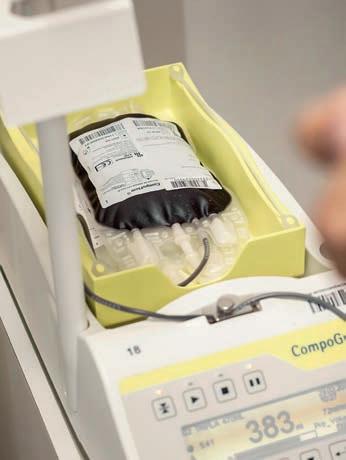



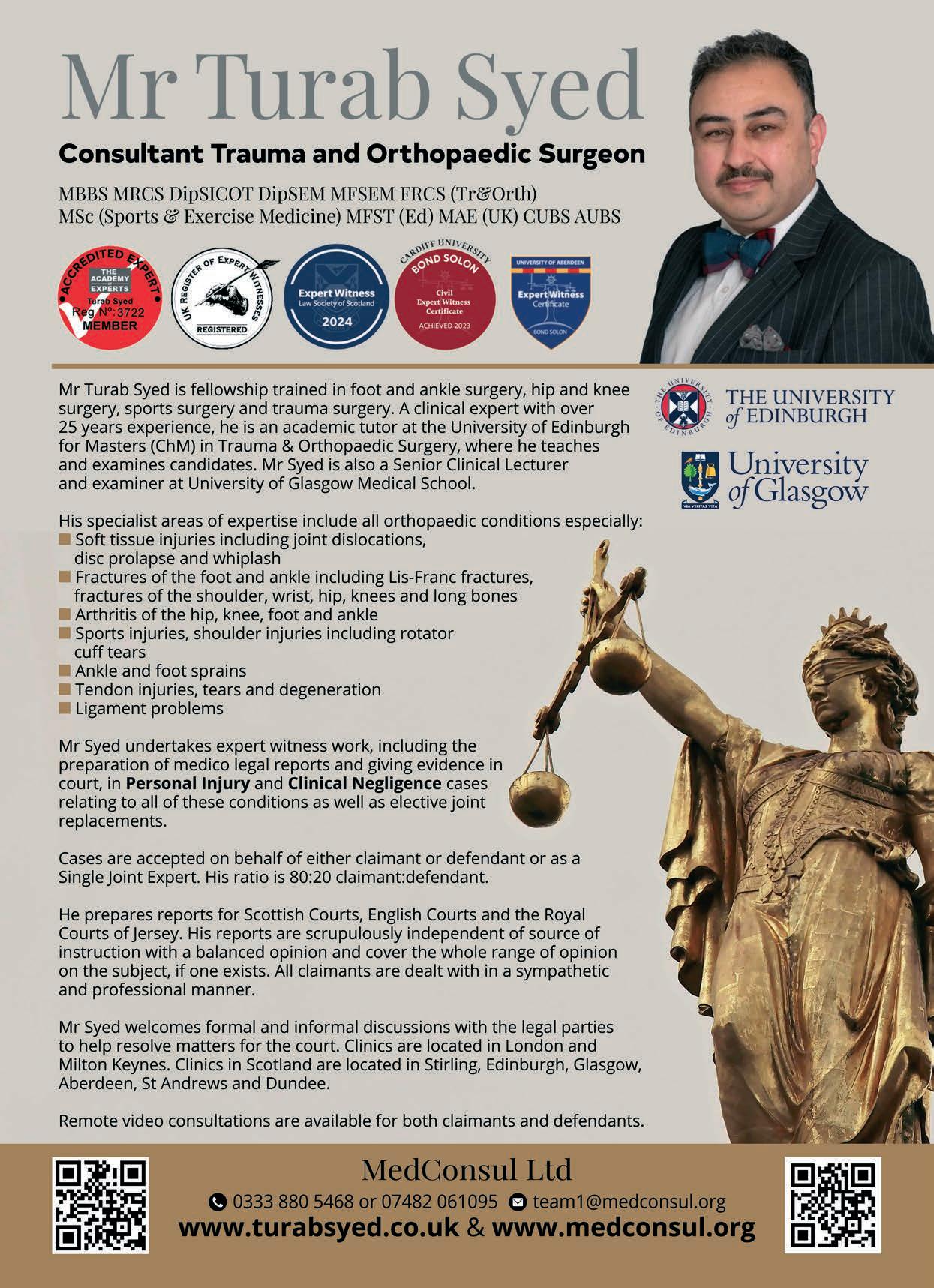
[ THE OPENING STORY in this issue of Your Expert Witness raises an issue most of us find despicable – thieving from the dead. Short of actual grave robbing, helping oneself to the inheritance of someone’s loved one is pretty low, but also surprisingly easy. Law firm Fraser and Fraser have uncovered the astonishing amount of probate fraud going on under the noses of the authorities, much of it being perpetrated by organised gangs in foreign parts.
The typical target for probate theft is property, often but not always a property left vacant with no known beneficiary. The forged wills are often full of errors and the ‘witnesses’ either non-existent or untraceable.
Yet, despite the ease with which the dubious nature of these wills can be spotted, there seems to be no appetite on the part of the authorities to do anything about them.
• Fraud is, it seems, endemic in our lives. The latest move to combat fraud in the business world is the duty to self-report. If there is fraud detected in an organisation, then that organisation is required to self-report the issue to the Serious Fraud Office. Co-operation in that way can result in the organisation escaping prosecution. The SFO has issued guidance on how to go about it, including describing instances it views as insincere.
• Wrongdoing by tax advisers is also coming under scrutiny: this time by the government itself. The proposals to tighten up on the rules for tax advisers has, not surprisingly, come under fire from the ICAEW. The institute argues that honest and legitimate advisers could be caught in the net if the mesh is set too fine. They recommend using their own standard as the benchmark instead.
• It couldn’t be long, while discussing fraud, before the subject of artificial intelligence came up. One of the many uses of AI by the criminal fraternity is the production of so-called deepfake images and media. The depth of the fake indicates the extent to which the image has been falsified, down to the finest detail. Add to that the influence of social media in today’s world and the opportunity for so-called ‘sextortion’ and identity theft blossoms. Detecting and prosecuting such frauds is a real technical accomplishment.
• Many people would take the view that making false claims for a product constitutes a kind of fraud. When those claims involve manipulating figures to claim an environmental quality for the product we call it ‘greenwashing’. Now, under new legislation, the Competition and Markets Authority has been given the green light to clean up on the greenwashing, so to speak.
• Our natural environment can hide some unwelcome surprises. One of them – and one that sends a shiver down the spine of developers and home-sellers alike – is Japanese knotweed. An invasive species brought to the UK as an ornamental plant, it has established itself in gardens, on waste ground and on riverbanks around the country. Not all is lost, however; it can be got rid of – but carefully.
• There are many people who would consider themselves living in Paradise if the worst problem in their home was Japanese knotweed. Particularly in the rented sector, damp and mould are still a plague, despite the efforts of government and the criticisms of the judiciary. In addition, drives to improve heating and make homes more sustainable are falling behind target.
• When there are structural problems with new homes and the developer has carried out remediation they are now entitled to recoup the cost of those repairs from the structural engineers who caused them, even after they have sold the properties. That was the essence of a ruling in the Supreme Court in May. q
Ian Wild, Director of Business Development Your Expert Witness

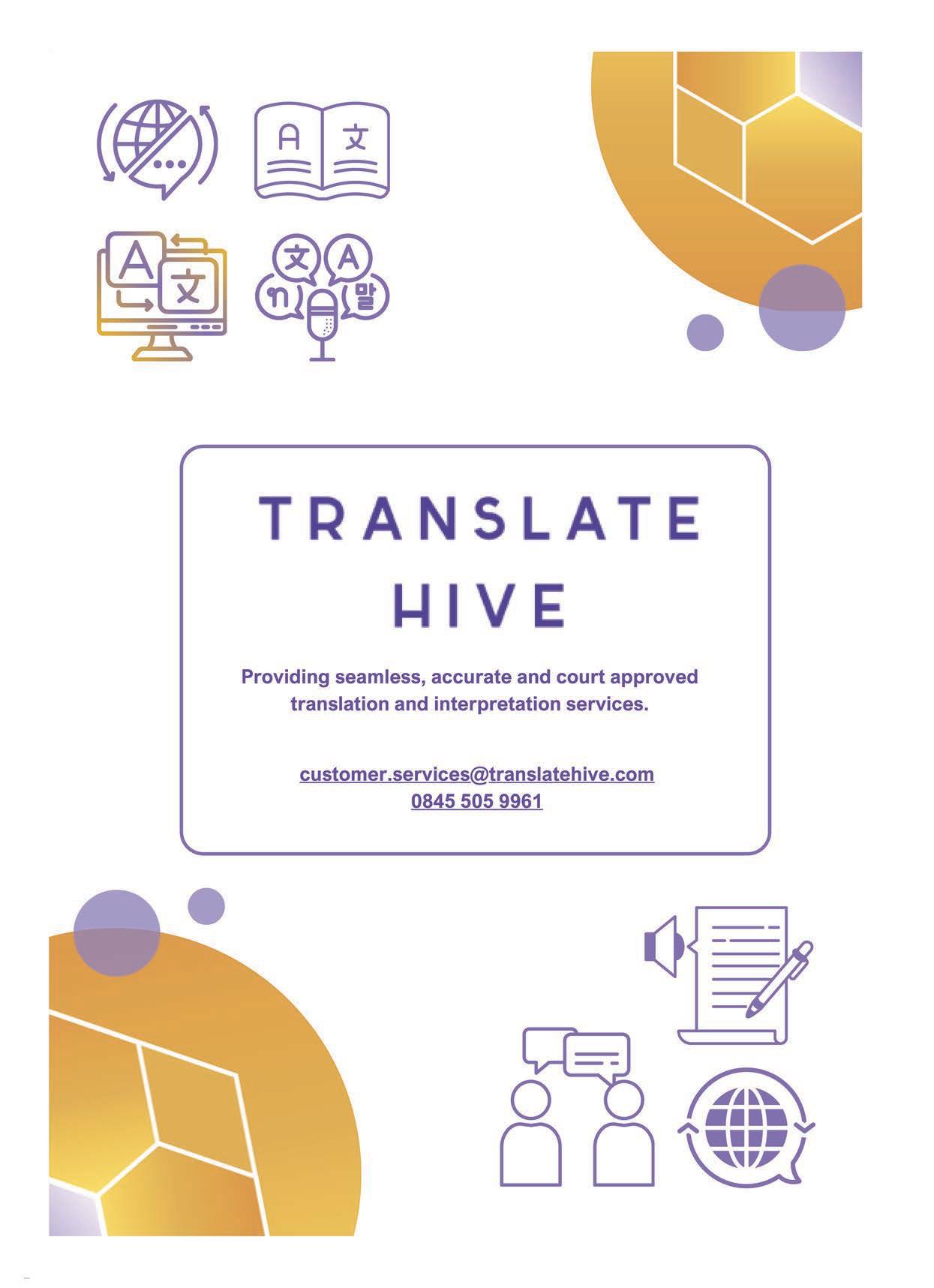
[FRASER AND FRASER, a leading firm in probate research, have raised the alarm over a concerning rise in fraudulent wills – an emerging threat that is systematically depriving rightful heirs of their inheritances. While will forgery is not new, the frequency and sophistication of these new cases are reaching alarming levels, compromising the integrity of the English and Welsh probate systems and leaving families devastated.
A disturbing pattern has emerged, the firm reports, with evidence suggesting a consistent modus operandi, showcasing a co-ordinated effort involving Eastern European individuals.
In nearly a dozen cases the fraudulent wills share a series of suspicious characteristics:
• The wills are strikingly simplistic, often just one or two pages long, lacking
• the usual legal phrasing and safeguards.
• Entire estates are left to one or two individuals – invariably young
• Hungarians with no prior connection to the deceased and often
• geographically removed from the deceased’s home.
• A notable focus on property with addresses prominently featured
• suggests a deliberate effort to exploit the property rather than a broad
• distribution of assets.
• Witness signatures are highly dubious – the e-witnesses are
• untraceable, either non-existent, having never resided at the addresses
• given, or confirmed to have died between the will’s creation and probate
• application.
• The wills are dated one or two years before the deceased’s death.
• No solicitors or legitimate legal professionals are involved in the drafting
• or probate application process.
• Applications for probate are strategically filed just under the Inheritance
• Tax threshold, despite the true value of the properties often being
• significantly higher.
• Properties in the wills are sold rapidly – sometimes within weeks of
• probate being granted.
This consistent modus operandi strongly suggests these are not isolated incidents but part of a well-orchestrated scheme to defraud the probate system. Fraser and Fraser have uncovered multiple cases where wills have surfaced for estates previously considered Bona Vacantia (ownerless property), resulting in the misappropriation of assets amounting to over £1m.
It’s not only the Bona Vacantia that is being targeted in these fraud cases: there are numerous instances where legitimate family members are identified only to find that probate has already been granted, and assets have been stolen. The actual estimated value of these frauds ranges from £2m-£10m.
Despite presenting detailed evidence of these fraudulent activities, Fraser and Fraser, along with other firms, have encountered a worrying lack of response from authorities.

Neil Fraser, partner at Fraser and Fraser, warned: “We are witnessing a systemic failure to protect estates. These wills not only rob individuals of their rightful inheritance, but also erode trust in the legal processes designed to safeguard them. The scale of this problem is far greater than many realise, and the lack of response from authorities is deeply concerning.”
As probate researchers, Fraser and Fraser specialise in locating missing heirs and ensuring rightful inheritances are distributed accordingly. However, the increasing prevalence of fraudulent wills directly undermines those efforts, leaving beneficiaries empty-handed and eroding confidence in the probate system. The success of the fraudulent schemes is largely due to a lack of preventative measures and the difficulty in detecting the scams before substantial damage has been done.
Fraser and Fraser are determined to bring the issue to the forefront and are calling on the relevant authorities to take immediate action. They urge:
• A thorough investigation into these fraudulent activities.
• The implementation of stronger safeguards to prevent similar frauds
• in the future.
• Greater co-operation between law enforcement and probate
• professionals to identify and dismantle organised crime involvement
• in the probate system.
• Increased public awareness to ensure beneficiaries and executors
• remain vigilant.
Additionally, Fraser and Fraser are seeking information from anyone who has encountered similar suspicious wills, in an effort to compile further evidence and press authorities into action. q
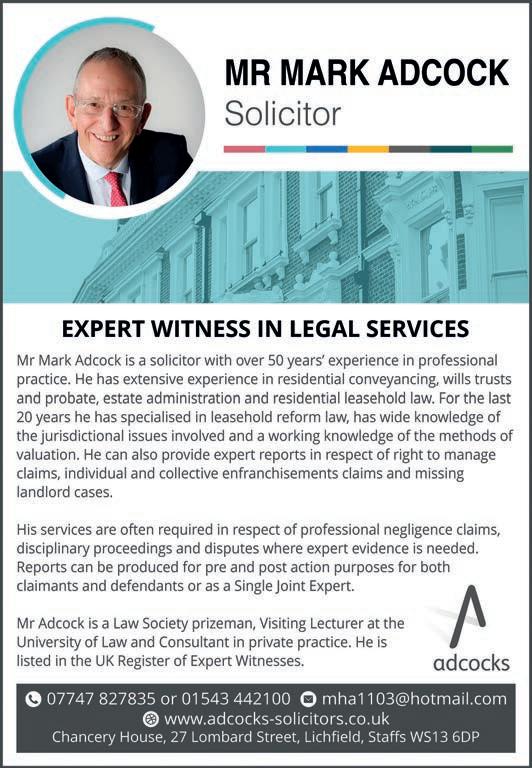

[THE Law Society of England and Wales is urging the government to invest more money to help restore civil legal aid and ensure everyone has access to this vital public service.
Launching its civil legal aid campaign on 9 June, the Law Society recognised that the government has taken positive steps to increase civil legal aid fees for housing and immigration. However, further investment is needed across all areas.
Research by the Law Society, Legal Services Board and YouGov reveals that people experiencing domestic abuse are less likely to understand their legal rights, know where to obtain legal advice or have confidence in achieving a good outcome. More than half (55%) of adults with a domestic abuse issue received no legal support and of those, 54% tried but were unsuccessful.
The Law Society’s new legal aid desert map shows more than 42 million people in England and Wales – nearly 70% of the population – are denied access to a community care legal aid provider in their area.
Law Society president Richard Atkinson said: “Civil legal aid is a crucial service that protects people and communities and reduces the strain on other public services. By throwing a legal lifeline to everyone who needs it we strengthen families, protect children and provide better care for people in our communities.
“Access to legal advice is of the utmost importance, particularly in cases involving domestic abuse, community care and mental health treatment disputes. Unfortunately, many people in these situations often struggle to obtain legal support and vital legal aid services are closing down.
“The government must properly fund all areas of civil legal aid – a vital public service – to help level the playing field and ensure a fairer society for all.” q
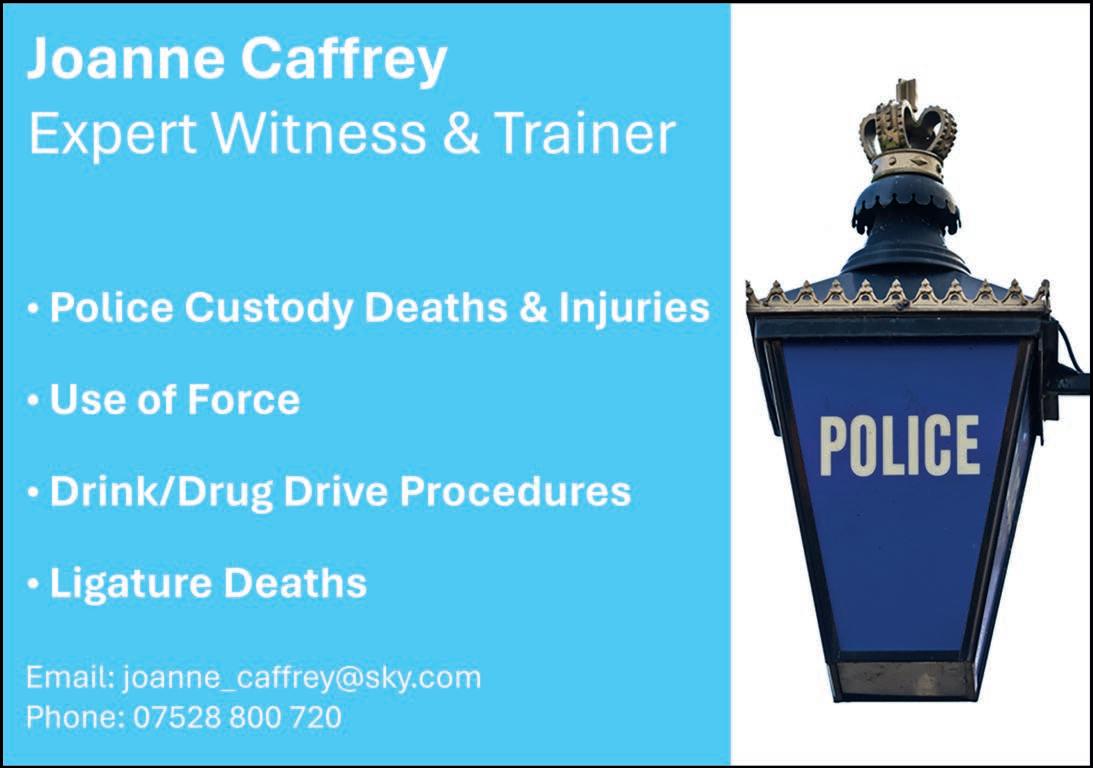

[
CHILDREN AND FAMILIES are still waiting too long to have their cases resolved, the National Audit Office (NAO) has found, because complex accountability arrangements and limited information on the biggest causes of delays make it difficult to target improvements to where they will have best effect.
Those delays can mean children wait longer for permanent care and living or contact arrangements: increasing the risk of harm, anxiety, instability and disrupted friendships or education.
The latest report from the NAO reviews the government’s approach to improving family court services for children in England and Wales.
It found that family courts have recovered much better than crown courts following the COVID-19 pandemic: as of December 2024 there were 47,662 outstanding family court cases brought by local authorities (10,121) and families (37,541) related to the living and contact arrangements for children. The number of outstanding cases has reduced by over a quarter since August 2021, although many cases still take too long to complete. Government has a range of initiatives underway to reduce delays and to improve the experiences of vulnerable court users.
However, as of December 2024, there were over 4,000 children in proceedings that had been on-going for nearly two years or more.
Government introduced a statutory time limit to resolve most cases started by local authorities within 26 weeks, but that legal deadline has never been met since it was introduced in 2014. There is no equivalent time limit for cases brought by parents.
Responsibilities for family justice are dispersed across several government bodies. They include the Ministry of Justice (MoJ), Department for Education (DfE), His Majesty’s Courts and Tribunals Service (HMCTS) and the Children and Family Court Advisory and Support Service (Cafcass) in England, all of whom were audited for the report. There is no single body accountable for overall performance, nor is there a shared understanding of what good quality support looks like from the perspective of a child. Due to a lack of joined-up data, at present it is not yet possible to follow a child through the family justice process from beginning to end, the NAO said.
The government does not yet have the data it needs on family justice to understand what the biggest causes of delays across the whole system are, or what the impacts are on different groups. The NAO analysed the findings of performance reviews undertaken by government bodies to identify reasons for delay and inefficiencies in family justice cases. The reviews identified more than 25 different issues, which vary across local areas and between different types of cases.
The NAO has made several recommendations for MoJ, DfE, HMCTS and Cafcass in England to improve the efficiency of family justice and outcomes for children.
Gareth Davies, head of the NAO, said: “The government has a range of initiatives to improve family justice services for families and the number of children waiting for court decisions is reducing. But many cases still take too long to complete and further action is needed to remove the barriers to a more efficient system, including poor quality data and fragmented decision-making.” q


By CHRIS MAKIN chartered accountant, accredited civil mediator and accredited expert determiner
[WELL, ARE THEY? And do they understand business accounts? Some are, and some do – in fact, some are quite brilliant mathematicians –but there are many who don’t, and I will share with you a few examples.
First, we have lawyers who have confidence in the accounts filed at Companies House and when a valuation is needed, in divorce for example. They take a printout of the micro accounts from Companies House, send them to me, and expect me to be able to value the company.
This happened so frequently that I felt obliged to write a blog about it, Companies House Searches Are USELESS. The blog can be viewed at chrismakin.co.uk/companies-house-searches-are-useless/ and I append a note: “This blog is retained on page one for its enduring relevance.”
So the next time a junior lawyer in the family department sends me such accounts, I have my explanations ready.
Then I turn to Kemp & Kemp The Quantum of Damages – the ‘Bible’ for personal injury practitioners. This was a lifetime work for David Kemp QC who, touchingly, included the second Kemp in the title. This was his wife, a very promising young barrister who died tragically young. I wrote a chapter for David on how to quantify loss of earnings for the self-employed and family company director and he was really pleased with it. It was in print for many years, but then David died and the publishers Sweet & Maxwell appointed a new editorial board who re-wrote all of Volume 1 so that my work was lost. I wrote to them and said how important it was for users of the work to understand business accounts, for example a barrister who was cross-examining an accountant expert witness.
The reply I got was that accountants understand accounts, and if interpretation was needed they could always instruct an accountant. I found that unconvincing. And my chapter is still available to you if you drop me a line. It’s in very simple language, but there is lots to learn.
Next, I turn to crime, and particularly to drug dealing. As readers will know, those convicted of drug dealing – and some other serious offences – are at risk of having their assets seized by the Crown under the Proceeds of Crime Act. It is said that doing jail time is just the price one has to pay for profiting from drugs, but that losing their wealth is what really hurts these people.
Perhaps so, but the court has to decide on a fair figure, both for the benefit from the crime and the amount available for confiscation.
I have just finished a case where the convict pleaded guilty to drug dealing in a minor way and is now serving time – but his main activity was running a motor repair business and MOT testing station. The prosecution’s expert went through his bank accounts, totalled up some £353,000 going through them and concluded both that this was all from drug dealing – it wasn’t; there was even ample evidence of vehicles bought and sold – and that this same sum was the amount available for seizure.
That was even more unrealistic; how could money which had come into the business and gone out again still be sitting in a bank waiting for the authorities to collect it? Naïve!
My expert report showed that there was £6,336.36 sitting in bank accounts, so that was the available amount. A few days before trial, the prosecution agreed that the available amount was £6,336 – and thirty-six pennies. What a waste of time.
If you are still reading, that’s good because we now come to the most interesting bit. Some months ago, I was the expert in a criminal trial at Swansea Crown Court. Andrew Ling had been accused of stealing some £165,000 from his own company. After 11 years in the army doing bomb disposal, Andy had set up a business producing a very advanced form of battery; he had even sold 3,000 units to Sainsbury’s for their home delivery vehicles.
He fell in with some business angels, who borrowed £700,000 from the Welsh Development Bank and regularised the management of the company. Andy admits that his record keeping was poor. The other directors – the angels – accused him of fiddling his expenses and taking
money from the company without authority. He was investigated and sacked for gross misconduct.
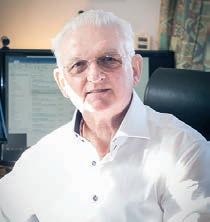
After he left, the others didn’t have his technical knowledge and the business failed. Andy was charged with theft and spent five years on remand.
As the trial came up, the prosecution’s expert was an AAT (Association of Accounting Technicians) – a very low-scale qualification for those working in the back room of accountants’ offices. She added up all the amounts withdrawn but ignored all those paid in: introduced from private funds, expenses not claimed and so on. All of that was recorded in the directors’ loan account.
At the end of the fourth day of the trial in Swansea, I gave evidence and had to explain how a directors’ loan account works. And I gained the distinct impression that no-one else in that courtroom – judge, both counsel and the jury – had any idea. I was the last witness. The jury retired and emerged a few minutes later with a verdict of ‘Not Guilty’. Andy’s five years of purgatory was over.
There was a long article about this recently in The Times Business Section. I am mentioned only once, as follows:
“ ”
An expert witness commissioned by the defence helped convince the jury of his innocence, Ling believes. Chris Makin, a forensic accountant, supported Ling’s claims that he had only withdrawn money owed to him. On one calculation, far from stealing from the business, he was in fact still owed £20,000. “Chris was the first person in five years who believed me,” Ling says.
This is what makes my job so rewarding – but what a pity the lawyers working on the case didn’t know about directors’ loan accounts years ago! q
[ CHRIS MAKIN was one of the first 30 or so chartered accountants to become an Accredited Forensic Accountant and Expert Witness –see www.icaew.com/about-icaew/find-a-chartered-accountant/find-anaccredited-forensic-expert
He is also an accredited civil and commercial mediator and an accredited expert determiner. Over the last 30 years he has given expert evidence at least 100 times and worked on a vast range of cases. For CV, war stories and much more go to the website at www.chrismakin.co.uk – now with videos! q

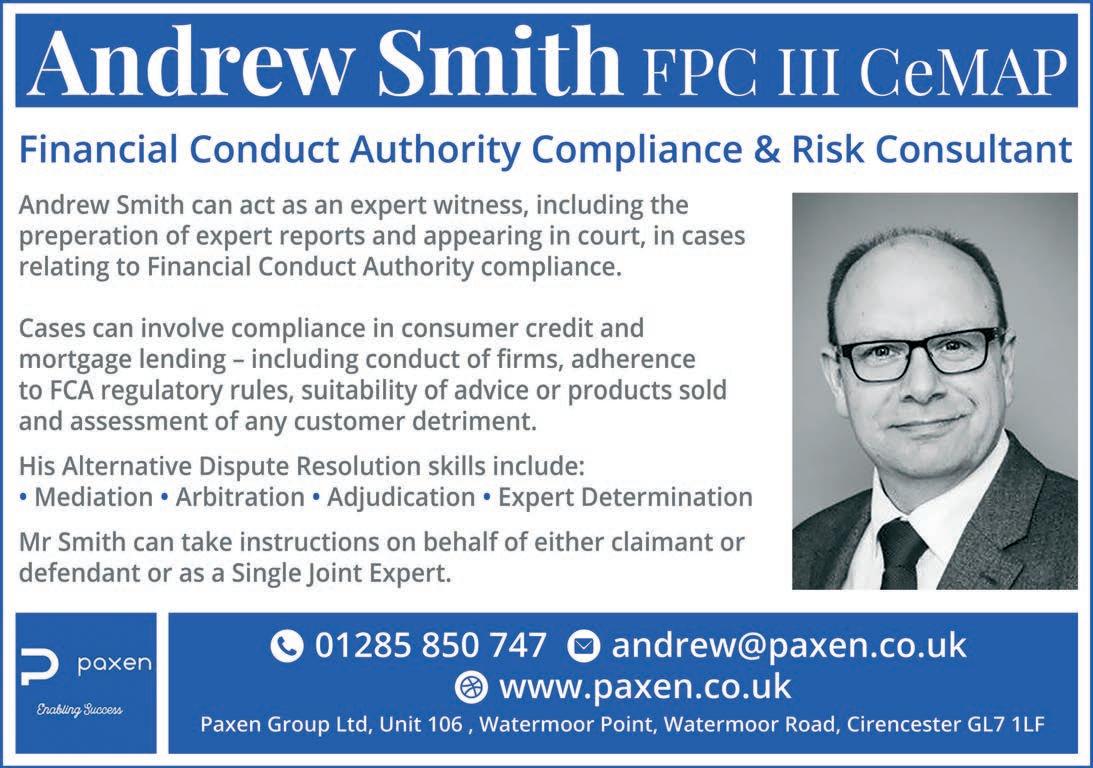
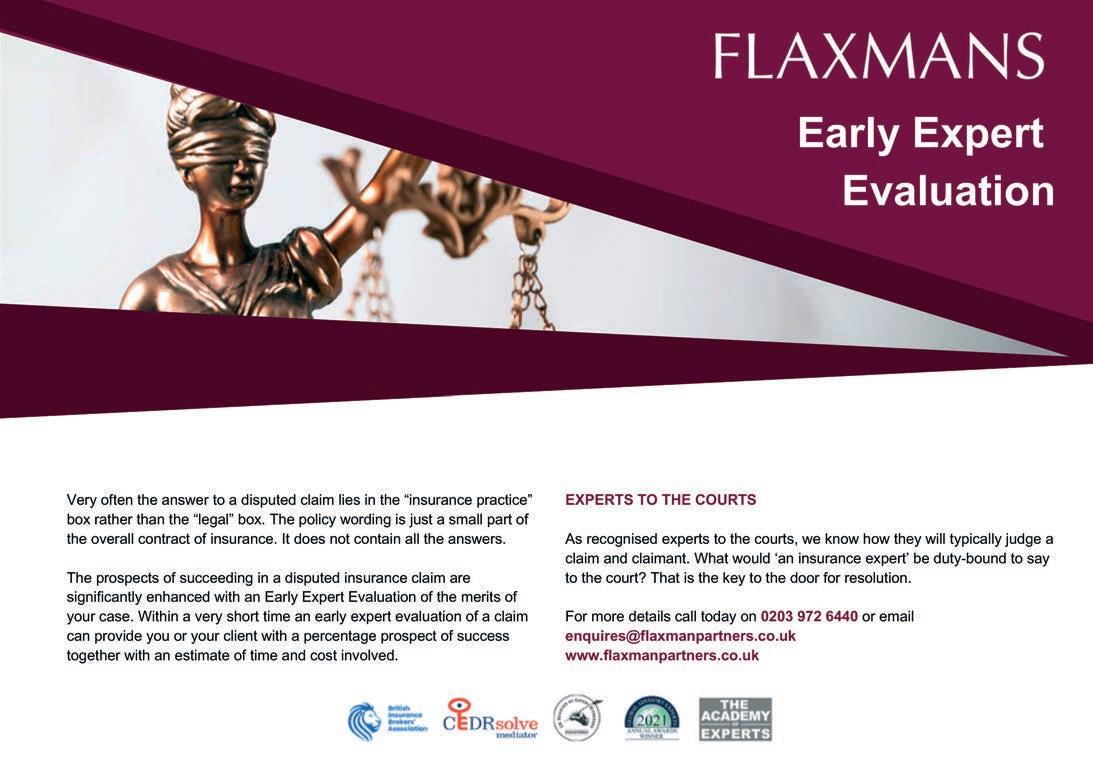
[ THE UK’S world leading insurance market could benefit from simpler, more straightforward rules, under proposals published by the Financial Conduct Authority (FCA) in May. The regulator plans to strip outdated or duplicated requirements from its insurance rulebook, having asked what improvements it could make.
The changes could support lower costs and wider access for the businesses and consumers who rely on insurance to manage risk, while maintaining appropriate levels of protection.
The regulator is proposing to create a new definition to identify large commercial insurance customers who should not be captured by its conduct rules. That would ease the burden on firms insuring larger businesses that can manage risks independently, while protecting smaller commercial customers.
The regulator is also proposing further measures that could benefit the insurance market more widely, including:
• No longer requiring firms to review the value of their product at least
• every 12 months. Instead, firms would use the risks and
• characteristics of each product to decide how often they review them.
• Giving firms flexibility to appoint one lead insurer to comply
• with its rules in instances where more than one party is involved
• in designing the insurance product.
[ A UAE-REGISTERED COMPANY, Glory Line Goods Wholesalers Co LLC, has agreed to forfeit £17.5m following a civil recovery investigation by the National Crime Agency (NCA). The company, owned by Indian national Sankar Velu, had received over CNH 200,000,000 (£20.5m) from a Hong Kong-registered customer, which it argued was for a significant consignment of plastic.
The agency suspects that this sum represents the proceeds of tradebased money laundering. In September 2023 concerns were raised about the amount of money moving through the company account – and a later review revealed that two auditors’ reports, provided to a UK-based Authorised Payment Institution, were fraudulent. The NCA obtained an Account Freezing Order in November 2023.
Substantial material, including invoices and payment details, were provided by Glory Line to justify the transactions on the account –but many contained significant inaccuracies and inconsistencies.
The company also failed to provide a number of crucial documents, including a full copy of the company’s bank statements, quotations for products or negotiations over price and information relating to Velu’s original purchase of the firm.
Sankar Velu has denied engaging in criminal activity, and Westminster Magistrates’ Court has made no finding in that regard.
The Consent Order does not represent a criminal finding of, or an admission of, guilt.
Rob Burgess, head of asset denial at the NCA, said: “The agency deploys all powers available to identify, pursue and recover the proceeds of crime, even if the criminality in question took place overseas. In this case, NCA officers worked tirelessly to comb through complex documents, securing a significant settlement and demonstrating our commitment to carefully scrutinising money that flows into or through the UK, including via UK-regulated companies.” q
• Broadening the scope of bespoke contract exclusions and
• making them easier for all insurers and brokers to use. Bespoke
• contracts are built to suit one customer upon that customer’s
• request, which means they automatically have the protections
• product governance rules provide.
• Getting rid of duplicative annual reporting and employer’s
• liability notification requirements.
• Removing the specified minimum hours of training and
• development required for insurance and funeral plan
• employees.
Matt Brewis, director of insurance at the FCA, explained: “We are stripping back our insurance rulebook by removing ineffective, outdated or duplicated regulation – as part of our drive to become a smarter regulator and support growth.
“We have listened to industry and we are taking action. In doing so we will reduce regulatory costs and increase the competitiveness of the already world-leading UK insurance sector, while maintaining vital protections for smaller customers.”
The regulator is also inviting views on whether it should limit the scope of some rules to UK customers. The consultation comes following its commitment to withdraw over 100 pages of outdated guidance in a bid to streamline its rules, reduce burdens on businesses and improve outcomes for consumers after the introduction of the Consumer Duty.
The FCA is asking for comments on those proposals by 2 July. q

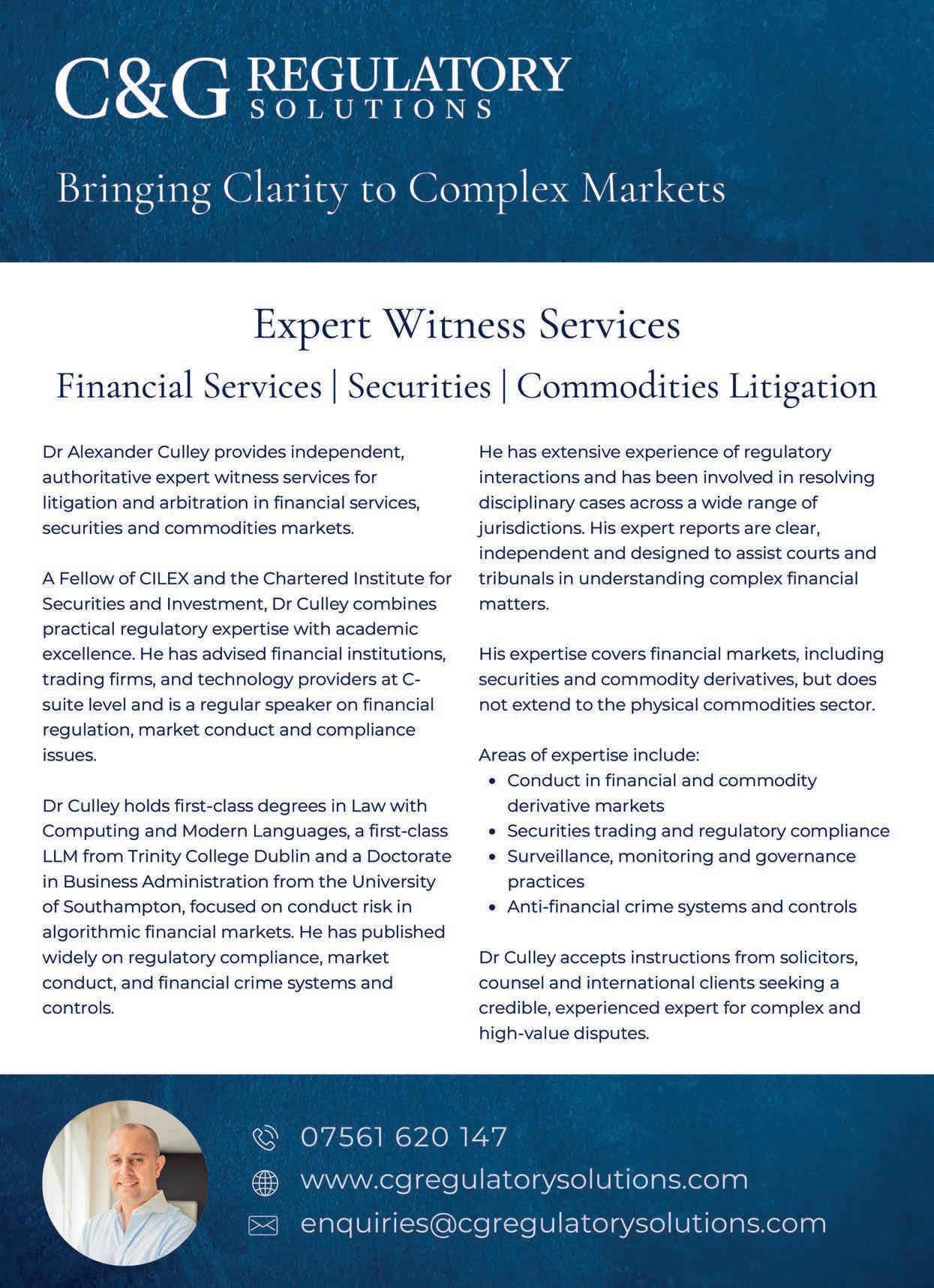
[THE OPERATION of the tax advice and compliance market in the UK could be adversely affected if government goes ahead with its plans to tackle the small number of tax advisers who facilitate noncompliance, by introducing measures that could potentially catch all reputable tax advisers. That’s according to the Institute of Chartered Accountants in England and Wales (ICAEW).
In its response to the government’s consultation on enhancing HMRC’s ability to tackle tax advisers facilitating non-compliance, the institute warned that the government’s plans could increase costs for taxpayers, have an adverse impact on taxpayer compliance and act as a barrier to growth.
ICAEW said that the bar must be set at an appropriate level that does not impact on the good work undertaken by reputable tax agents who help taxpayers and support compliance.
Given HMRC’s endorsement of the Professional Conduct in Relation to Taxation standard and the alignment of HMRC’s own standard for agents with it, ICAEW has asked HMRC to agree that a tax adviser or agent who complies with those standards should never be subject to the new powers.
Iain Wright, ICAEW’s chief policy and communications officer, said: “If these proposals go ahead and are not properly targeted, they could lead to significantly increased costs for taxpayers seeking advice, which may have an adverse impact on taxpayer compliance. We are also concerned the proposals may reduce the amount of quality professional advice given to taxpayers, thereby reducing overall quality and slowing down transactions and decision-making across the economy –potentially hindering growth.
“Such implications are disproportionate outcomes compared with HMRC's stated aim of only tackling the behaviours of a small minority of agents who actively facilitate non-compliance and would be contrary to the public interest.”
ICAEW said it welcomed the measures to broaden the disclosure of HMRC’s concerns about tax advisers to professional bodies. That would support its role as an improvement regulator to provide targeted support and deliver appropriate interventions to its members, which would be in the public interest. It added it was concerned that the proposed measures did not match the intended target outlined by government.
The measures take the dishonest conduct rules for tax advisers as the starting point, but those rules were created for a different reason and changing them would result in draconian provisions applying to behaviours that fall well short of dishonest conduct. Any legislation should contain appropriate safeguards, guardrails and sanctions that are proportionate and easy to apply, the institute said.
Additionally, the consultation offered little to value and support the role of most tax agents who are doing a good job – whether professionally qualified or otherwise – by making it clear that they are not the intended target of the provisions.
The institute said the consultation provided no compelling evidence that the bar for the dishonest conduct provisions, framed in 2012, was set too high. Instead, it said that amending the processes and increasing the sanctions for dishonest conduct should be explored further.
If these proposals go ahead, the institute said, the bar would be set too low, with the result that a quasi-regulatory environment, with HMRC acting as the de facto regulator, would be in place, but with none of the safeguards needed to protect most ordinary compliant tax agents seeking to ensure that their clients pay the right amount of tax. q
[THE Financial Reporting Council (FRC) unveiled insights from its discussion paper on Opportunities for Future UK Digital Reporting, revealing stakeholder support for digital reporting and the collaborative approach needed to address the challenges in the next phase of digital reporting in the UK.
The discussion paper reflects responses received during a feedback period which gathered perspectives from preparers, regulators, software vendors and other stakeholders on how to shape the future of digital reporting in a EU-exit environment, and in light of new legislation such as the Economic Crime and Corporate Transparency Act 2023.
Key findings include strong support for on-going collaboration between regulators and preparers to reduce complexity, calls for improved guidance and support materials and a recognition of the balance needed between UK-specific reporting requirements and international comparability.
Mark Babington, executive director of regulatory standards at the FRC, said: "We are grateful to all stakeholders who contributed valuable insights to this discussion paper. The feedback clearly demonstrates that the digital reporting landscape in the UK is evolving, with stakeholders recognising both the benefits and challenges. As we enter a new phase of digital reporting in 2025, the FRC remains committed to enabling efficient, accessible digital reporting that serves the public interest while supporting UK economic growth."
The insights published in the discussion paper will inform on-going development and technical approaches to digital reporting across UK regulatory bodies, the FRC says.
The feedback statement is available to download at www.frc.org.uk q
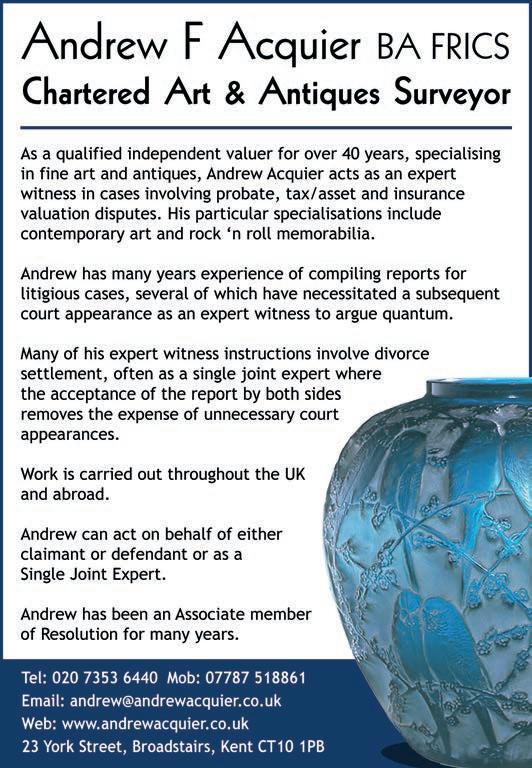
[ THE SERIOUS FRAUD OFFICE (SFO) has launched new guidance, stating for the first time that, if a corporate self-reports suspected wrongdoing and co-operates fully with investigators, it can expect to be invited to negotiate a Deferred Prosecution Agreement (DPA) rather than face prosecution, unless exceptional circumstances apply.
At a legal conference in London on 24 April, SFO director Nick Ephgrave (pictured) introduced new corporate co-operation guidance that will make it simpler for corporates to report suspected wrongdoing by a direct route to the SFO’s Intelligence Division, via a secure reporting portal.
The guidance also provides greater clarity on what the SFO views as ‘genuine co-operation’, including preservation of digital and hard copy material, presenting the facts on suspected criminal conduct and early engagement with the SFO on any internal investigation. The guidance also gives examples of what the SFO

views as unco-operative conduct, including attempts to ‘forum shop’ by unreasonably reporting offending to another jurisdiction for strategic reasons and attempts to minimise or obfuscate the involvement of individuals.
In return, a self-reporting company can expect the SFO to:
• Contact it within 48 business hours of a
• self-report or other initial contact.
• Provide a decision whether to open an
• investigation within six months of a
• self-report.
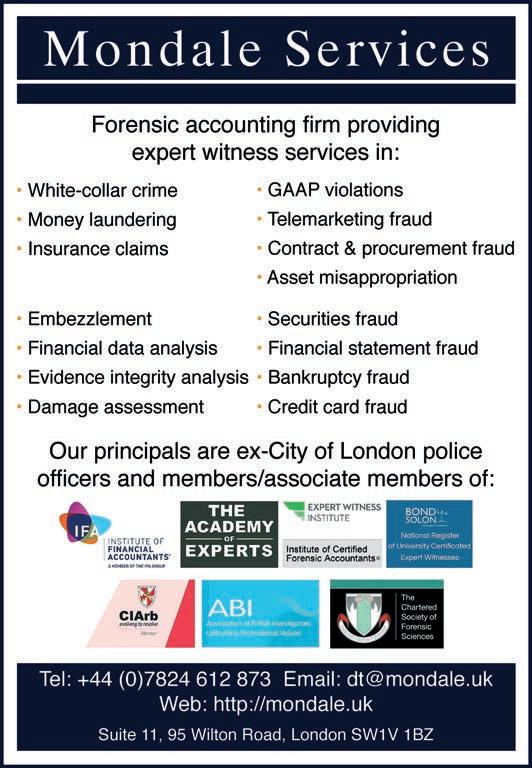
• Conclude its investigation within a
• prompt time frame.
• Conclude DPA negotiations within six
• months of sending an invitation.
Nick Ephgrave QPM, director of the Serious Fraud Office, said: “We are determined to lead the fight against serious and complex fraud, bribery and corruption at home and side-by-side with international partners. Our new guidance sets out how corporates can report suspected criminality to us and what we expect from co-operating corporates.
“If you have knowledge of wrongdoing, the gamble of keeping this to yourself has never been riskier.”
The new guidance comes amidst a push by the SFO to optimise its operating environment to tackle top-tier criminality, including by advancing plans to incentivise whistleblowers, supporting reform of outdated disclosure practice, trialling new technology and setting up a taskforce to tackle international bribery and corruption with key partners. q


[THE AIRING of the ITVX drama series Code of Silence brought into focus the skill of lip reading. Starring Rose Ayling-Ellis, who has herself been deaf from birth, it has been hailed as ‘a triumph’ in helping to bring the deaf world to a hearing audience.
The plot of the drama involves a police team recruiting a lip-reading canteen worker to help in the surveillance of a gang of robbers. The reality is that there is an existing body of lip reading experts who can translate observed and recorded speech. They are to be found in courtrooms and studios across the country, rather than in ‘stake-outs’.
One of the most prominent among them is Tina Lannin. Tina was also born deaf and struggled to thrive in a hearing environment. She founded 121 Captions, which has become one of the leading lip reading agencies in the country. Alongside providing instant translation into many languages of speeches – both in th UK and abroad – she has provided forensic lip reading services to government and police services in order to aid the courts in understanding evidence from silent videos and videos where the sound is cluttered.
She explains what forensic lip reading is and how can it help.
“Lip reading is a rare and special talent. It takes years of hard work and dedication to lip read with any sort of authority, but even with that, there is a branch of lip reading which takes this art to a more serious level: forensic lip reading.
“Forensic lip reading is a form of lip reading which is used to collect information or evidence. Agencies such as the police, private detective agencies or insurance companies can use forensic lip reading to interpret what has been said in video footage in order to ascertain the particular facts of a case.”
Although it’s not 100% accurate, evidence from a forensic lip reader is still admissible in the UK courts. That was due to a landmark case in 2004 (R. v Luttrell et al., 2004), which established the admissibility of forensic lip reading evidence.
Tina points to one famous case: the Arlene Fraser murder. The 33-year-old mother of two disappeared in 1998 and, even though her body was never found, her husband was convicted of her murder.
Says Tina: “This conviction was due in part to a conversation he had in prison which was recorded by the prosecution. Although there was no sound to the recording, a forensic lip reader was able to create a transcript of what was being said.”
The most obvious factor is the quality of the video to be deciphered. Blurry, shaky and jumping footage is going to prove more of a challenge than a clear, steady shot.
Tina says: “Also, CCTV footage comes in all different shapes and sizes, with modern, high-definition cameras offering a more accessible viewing; but no matter how clear the footage is, it won’t make a difference if we can’t see the lips!
“In a perfect world, the speaker would be facing the camera, standing still and speaking normally. Unfortunately, this is rarely the case. Many times the speaker is far away from the camera, at an angle and often
walking or even running. I’ve been sent videos of people running in a dark garden with the police after them, of people with their backs to the camera, of people across the street with cars driving past between the camera and speaker, of people sitting in a pub so gloomy you can’t make out their faces.
“Lots of people mumble; everyone has some type of accent and many of us have lisps or a slight stutter. Add to that someone wearing sunglasses or a baseball cap, and suddenly there are no expressions to work with either, which is a big part of lip reading. These considerations are why no two videos are the same.”
For Tina, lip reading engagements are not always about catching criminals. She has been employed by TV sports teams to read the lips of footballers and coaches to interpret the tactics being discussed and even by news teams to report on what members of the Royal Family are saying to each other at public events. q


By Ryan Shields, senior associate in digital forensics at S-RM
[ IN TODAY’S DIGITAL AGE, deepfakes represent a significant challenge for digital forensics experts. By leveraging sophisticated artificial intelligence (AI), these manipulations create highly-convincing yet false content across visual and audio media. S-RM’s digital forensics team are researching and developing forensic methods to enable detection of such fabrications.
Early deepfakes exhibited indicators such as mismatched lip-syncing or irregular facial features which made them easier to detect. However, modern deepfakes successfully eliminate those issues and therefore require more advanced detection methods. Current challenges include:
• Realism and detail: Modern deepfakes utilise complex algorithms
• to craft content that is designed to evade traditional detection,
• whereby advances in machine learning allow deepfakes to achieve
• high levels of realism. As a result they can closely mimic natural
• human expressions, micro-expressions and subtle speech nuances,
• making them difficult to detect with the naked eye or through simple
• automated methods.
• Diverse formats: Deepfakes can be video, audio, image or even
• text-based, each requiring distinct detection approaches. Ensuring
• detection algorithms can handle that diversity without being overly
• specialised is complex.
• Data loss: Compression algorithms can obscure or distort the
• visual artefacts and alter audio signals that might otherwise indicate
• manipulation.
Each of these challenges requires a concerted effort involving technology development, continuous research and the refinement of detection methodologies to effectively combat the risks associated with deepfakes, with the objective of improving detection rates. At S-RM we are developing a dual approach utilising AI-driven detection tools in combination with the application of traditional digital forensic analysis.
AI-driven detection tools
AI-driven detection tools are designed to identify subtle irregularities within media content. AI models are trained on extensive datasets comprising both authentic and fabricated media. That training helps the models learn to recognise patterns and anomalies that distinguish deepfakes from real content. The tools identify distinct features typical of deepfakes, such as pixel-level artefacts, inconsistencies in lighting or shadow and unnatural facial or body movements.

Ultimately, AI-driven detection tools are essential in the battle against deepfakes: using AI to combat AI. However, their effectiveness hinges on constant vigilance, continuous learning and adaptation to an evolving landscape of digital media manipulation. Regular updates, informed by research and real-world data, are essential to improving the effectiveness of those tools.
While AI-based detection methods focus on content analysis, there are other forensic artefacts embedded within a media file which serve as corroborative evidence supporting a file’s legitimacy or suggesting fabrication. Those forensic artefacts often contain information about when and where a media file was created, as well as the device or software used. That data can help verify the authenticity of content by confirming whether it aligns with expected creation details, such as time and location.
Identification of anomalies can signal that a file was edited or processed through unconventional means. The presence of certain metadata or patterns – for example, software editing signatures –can be indicators of known editing tools frequently used to create deepfakes, helping to identify evidence of fabrication. While such analysis offers potential in identifying manipulated content, several complexities make this approach challenging.
The wide array of tools available for creating deepfakes means the extent of residual forensic artefacts can vary significantly. Different software and platforms may not leave consistent or identifiable patterns, complicating the task of establishing a reliable signature for detection.
Moreover, not all forensic artefacts provide clear evidence of manipulation. Sophisticated AI tools can obscure their digital fingerprints, leaving behind minimal traceable evidence.
Plus, when media is uploaded to social media platforms, it often undergoes compression, leading to the loss or alteration of original data. That compression can erase valuable forensic evidence, which is crucial for identifying deepfakes.
In conclusion, deepfakes pose complex challenges to the field of digital forensics, necessitating an adaptive approach that blends advanced AI-driven solutions with traditional digital forensic techniques. q
• If you require support in forensically investigating deepfake content, contact S-RM by emailing dfsupport@s-rminform.com

Roger Emmott, chartered engineer and expert witness in mining and steel, examines some trends and expectations in technical industries over the coming 12 months
[ THE ROLE of the expert witness continues to evolve rapidly, particularly in technically specialised industries such as mining and steel, where my experience lies. Over the next 12 months several key trends are likely to shape how expert evidence is commissioned, prepared and delivered in arbitration and litigation.
AI-enhanced analysis of complex data
Artificial Intelligence is no longer just a buzzword – it is becoming an increasingly practical tool in expert witness work, so long as it is used with care and understanding. In recent assignments I have used AI tools to expedite document review, data validation and analysis: always to supplement, not replace, my own expertise and judgment. The technologies help manage vast disclosure volumes, enabling clearer, evidence-backed conclusions while maintaining the traditional standards of rigour, objectivity and independence that tribunals expect. Learning how to use AI effectively is key.
Continued growth of remote testimony
Remote hearings, once seen as a temporary necessity, are now a routine feature of dispute resolution. That shift is particularly valuable for sector specialists like myself, whose work spans continents. In-person tribunals are often still preferred, but are logistically complex and expensive. The rise of virtual proceedings has made it far easier for instructing solicitors to access expertise from niche sectors, regardless of geography.
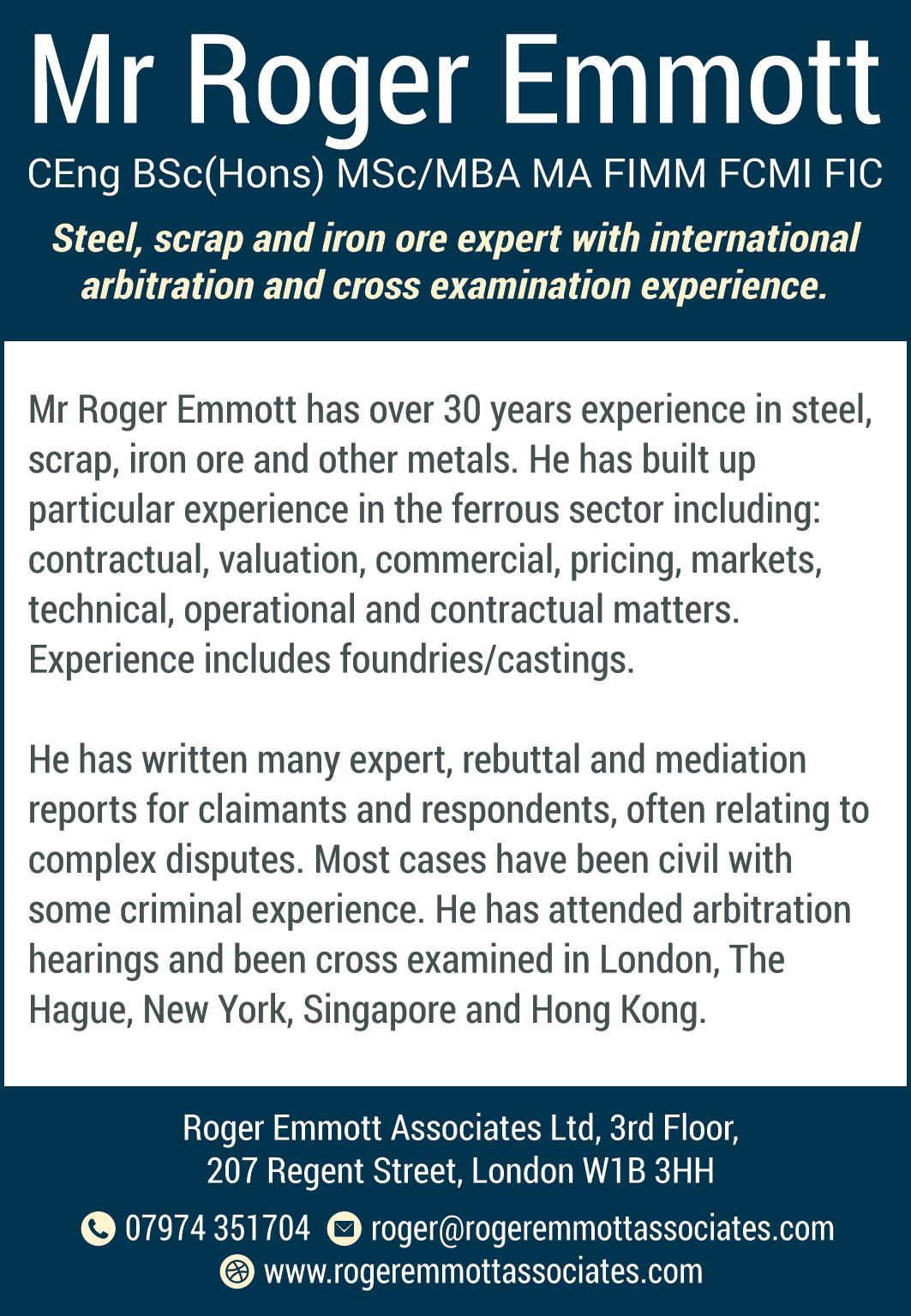

As disputes become more complex and cross-disciplinary, the need for precise, domain-specific knowledge is growing. In areas such as gas-based DRI steelmaking, pellet logistics in the Middle East or iron ore supply chains, generalist knowledge cannot be a substitute for decades of operational and market experience.
The stakes in those disputes are often high, with technical misunderstandings capable of significantly distorting the facts. My 30-plus years of experience with firms like Hatch, WS Atkins, Platts and my own consultancy enables me to bring not only deep sector insight, but also an understanding of global market dynamics to the expert role.
Environmental, social and governance (ESG) considerations – alongside supply chain disruptions and market volatility – are increasingly central issues in commercial disputes. Those factors are no longer peripheral: they are often at the heart of claims relating to project delays, cost overruns or contractual failures.
As regulatory scrutiny and stakeholder expectations rise, so too does the demand for expert input that can explain technical realities within those broader contexts. In my chosen discipline, seasoned engineering and metallurgical insight are becoming ever more valuable as such disputes grow in scale and complexity.
Tribunals and instructing counsel are rightly applying greater scrutiny to experts’ qualifications, methodologies and impartiality. For expert witnesses, that calls for impeccable transparency and independence. My track record includes appointments by both claimants and respondents; governments as well as corporates, with tribunal feedback explicitly recognising my objectivity and balanced approach. Maintaining that credibility requires not only technical depth, but also clear, well-reasoned reporting that withstands rigorous challenge.
Law firms are increasingly adopting legal technology platforms for case preparation, disclosure management and collaborative working. For expert witnesses, fluency with those tools is essential. Whether engaging in virtual document reviews or contributing to interactive timelines, I ensure my work integrates seamlessly with legal teams’ workflows. Increasingly, I believe that combining AI-assisted analysis – where appropriate – with structured, clearly written reports can enhance both efficiency and clarity.
Beyond formal testimony, experts are often engaged at an earlier stage for case evaluation, pre-action reviews, risk assessments or input to legal teams more generally. My advisory work draws on experience across the iron and steel and mining sectors, providing clients with realistic appraisals of technical feasibility, commercial exposure and dispute risk – long before proceedings reach arbitration or court.
The coming year will place greater emphasis on clarity, crossborder accessibility and evidence-based insight. For instructing lawyers navigating complex disputes, engaging an expert with both technical depth and proven arbitration experience will be increasingly essential. q
by Nik Ellis, managing director of Laird Assessors
[AT LAIRD we pride ourselves on blending technical expertise with innovation to redefine the standard of expert witness services in the UK motor industry. While our roots are in forensic vehicle inspection and engineering assessments, our forward-thinking ethos continues to drive us into new, exciting territory.
One area we’ve recently explored in greater depth is the integration of AI-powered analysis into expert reporting. Our engineering team has been developing ways to combine traditional engineering knowledge with digital tools that support quicker, more consistent and highlydetailed inspections.
For example, we’ve introduced a hybrid workflow, where an assessor’s mechanical insight is enhanced by machine learning algorithms that can detect damage patterns, compare them to known benchmarks and flag anomalies within seconds. This dual-layered approach not only improves the accuracy of our reports, but also helps reduce the turnaround time –a key consideration for legal professionals working to tight deadlines. Beyond technology, we've also focused on increasing transparency and clarity in our expert reports. Whether we're acting for claimants, defendants or as a single joint expert, the legal process demands
impartiality, clarity and robustness. That’s why we’ve invested in continuous training for our team; not just in technical knowledge, but also in courtroom confidence and report writing that stands up to scrutiny. We know that an expertly-worded, well-structured report can make all the difference when cases reach litigation.
A recent blog post that sparked interest across our network tackled the evolving expectations of courts around digital evidence – specifically telematics data. As vehicles become increasingly connected, the data they produce offers powerful insights into crash dynamics, driver behaviour and usage patterns. At Laird we're equipping our experts with the tools and knowledge to interpret that data meaningfully, ensuring it supports – not overwhelms – the legal argument.
Ultimately, our goal remains simple: to support solicitors, barristers and courts with expert evidence that is not only technically sound but also clearly articulated and forward-thinking. As the demands on expert witnesses evolve, Laird Assessors continues to lead with integrity, innovation and a commitment to excellence. q
• For further information visit www.laird-assessors.com
[THE ROAD SAFETY CHARITY Brake has announced both new and renewed funding partners for road victim support, in the form of seven personal injury law firms.
Brake’s National Road Victim Service provides specialist emotional and practical support for families who have been bereaved or seriously injured in a road crash. In 2024, the charity supported more than 2,000 families, helping them cope with their grief and navigate the complex, unfamiliar procedures that often follow a road crash, including help with legal and financial issues.

Long-standing Brake supporters Slater and Gordon, Alderstone Solicitors, Horwich Cohen Coghlan Solicitors, Hodge Jones & Allen, Irwin Mitchell and Hugh James have all renewed their support and funding for the charity’s legal panel. In 2025, they are joined for the first time by JMW Solicitors.
As well as providing a vital, sustainable source of funding for Brake’s National Road Victim Service, the law firms that comprise the panel can also give expert legal help after a road death or serious injury across areas such as inquests, wills and probate, as well as claims for compensation.
All of the supporting firms specialise in fatal injury cases. They have all also signed up to a Brake code of conduct for supporting road crash victims, meaning they will be able to help in ways that are expert, empathetic and confidential.
Alderstone Solicitors and JMW Solicitors can also provide specialist legal support to people bereaved or seriously injured in a military case, and in the case of Hugh James, Irwin Mitchell and Slater and Gordon, if a crash happened abroad.
Additional, independent legal panels are available to support road victims in Scotland and Northern Ireland.
Ross Moorlock, CEO of Brake, said: “We are immensely thankful for the funding support from our new legal panel in England and Wales, which brings us further stability, expands our team and enables us to support even more families during their darkest and most difficult times.
“Support from our law firm partners also demonstrates the high level of confidence they have in the work we do. We are proud to deliver the very highest standard of support to every family who seeks help from us.”
Clare Stevens, partner at new panel members JMW Solicitors, commented: “After decades of securing justice for those seriously injured on our roads, we are proud to announce our new partnership with Brake as an integral part of our commitment at JMW. It allows us to not only help clients navigate the legal process, but also connect them with vital support systems to address their wider needs during incredibly difficult times.
“At JMW, we adopt a holistic approach, acknowledging the profound impact a road crash has on the entire family, and we are proud to be affiliated with Brake, a charity dedicated both to supporting victims and their families and to campaigning to improve road safety.” q



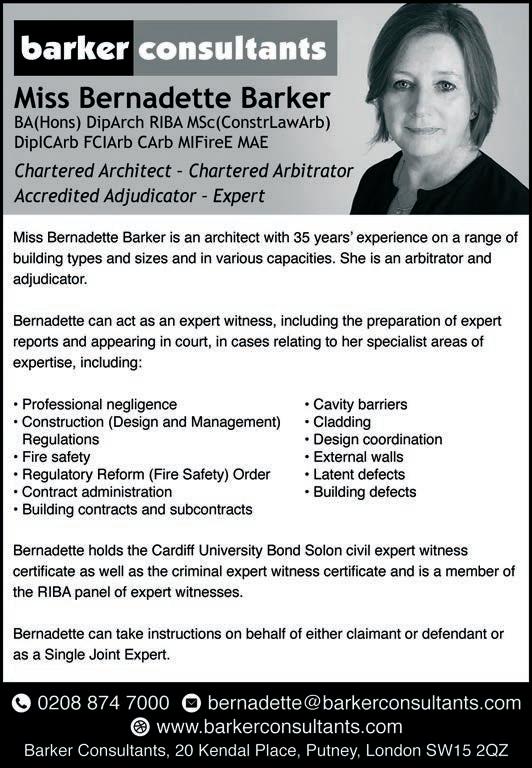

[BURDENSOME statutory consultation requirements unique to major infrastructure projects will be scrapped as a result of amendments to the Planning and Infrastructure Bill announced by the government, cutting down the average two-year statutory pre-consultation period by half and paving the way for new roads, railways and windfarms that will bolster the country’s connectivity and energy security.
Developers currently spend significant time and money on long, technical documents resulting in communities feeling fatigued and confused, which is a direct result of overly-complex planning rules that are leaving working people deprived of the things their areas need to thrive. It also disincentivises developers from making improvements to projects for fear of having to re-consult.
Recognising that community voices remain vital, the government will bring the process in line with planning applications for major housing schemes and set out new statutory guidance to promote meaningful local engagement without repeating the flaws. That will allow changes to be made dynamically based on community feedback, reducing delays and potentially saving over £1bn for industry and taxpayers this Parliament.
The planning reforms will also boost the government’s efforts to build 1.5 million homes by making it easier to deliver the roads, reservoirs and energy generation needed.
Deputy Prime Minister and Housing Secretary Angela Rayner said: “Critical national infrastructure is key to Britain’s future and security – so we can’t afford to have projects held up by tiresome requirements and uncertainty, caused by a system that is not working for communities or developers and holding back our true potential.
“We are strengthening the Planning and Infrastructure Bill to make sure we can lead the world again with new roads, railways and energy infrastructure as part of the Plan for Change, whilst ensuring local people still have a say in our journey to get Britain building.”
Alongside statutory guidance for developers on applications, the Planning Inspectorate will maintain high standards for accepting projects – informed by community engagement. Local authorities will also be made aware of proposed applications so that they can continue to play an important role in informing and advising on developments, as well as advocating for local interests.
As a result, local people can still object and share their views, but in a more effective way, with developers given the flexibility to adapt their schemes as needed without restarting the process: reducing delays and costs for projects, including datacentres, reservoirs and solar farms, while ensuring local people’s voices are heard. q
[THE UK’S Energy Security and Net Zero Committee says poorly-designed retrofit schemes, a ‘skills crisis’ and costly assurance failures have significantly set back efforts to decarbonise home heating and bring down energy bills, and has pushed the UK’s clean, secure energy targets farther off track.
Responding to the report, Amanda Williams, head of environmental sustainability at the Chartered Institute of Building (CIOB), said: “We are pleased to see the Energy Security and Net Zero Committee highlight the on-going issues preventing the retrofitting of UK homes at the scale and pace needed. Households continue to suffer the impacts of high energy costs and drafty homes, which can be detrimental to finances, health, and standards of living, as well as severely hampering the drive to net zero.
"CIOB has previously highlighted what the
report refers to as ‘stop-start government support schemes’, which undermines their effectiveness.
The Green Homes Grant is one such example, where assumptions were made about the capacity within the industry to deliver the energy efficiency improvements on offer.
“Our sector has well-documented skills and worker shortages, so instead of short-term, ever-changing schemes, long-term policies that provide a steady pipeline of demand for retrofitting must be the way forward.
“This would provide the industry with the assurance to invest in training and upskilling the workforce, which in turn gives households confidence that retrofit works will be delivered by suitably qualified people. This is essential to address the current low levels of consumer confidence, which both CIOB and the Committee have highlighted.

“Gaining trust in the industry to deliver highquality retrofit measures is key to improving the take up of support schemes. We would also urge government to carefully consider the funding of and access to these schemes, as even partpayment towards retrofit work is unaffordable for many when due in one lump sum. CIOB has previously made the case for an interest-free loan scheme to increase uptake, alongside welladvertised and trusted grants, made available over the long-term.
“The scale and complexity of the retrofit challenge is daunting, but to overcome it, it’s vital there is a clear strategy addressing consumer confidence, the provision of advice and access to and the promotion of schemes and funding. It must also cover ways to raise quality and standards through increasing provision for skills, training and accreditation.” q

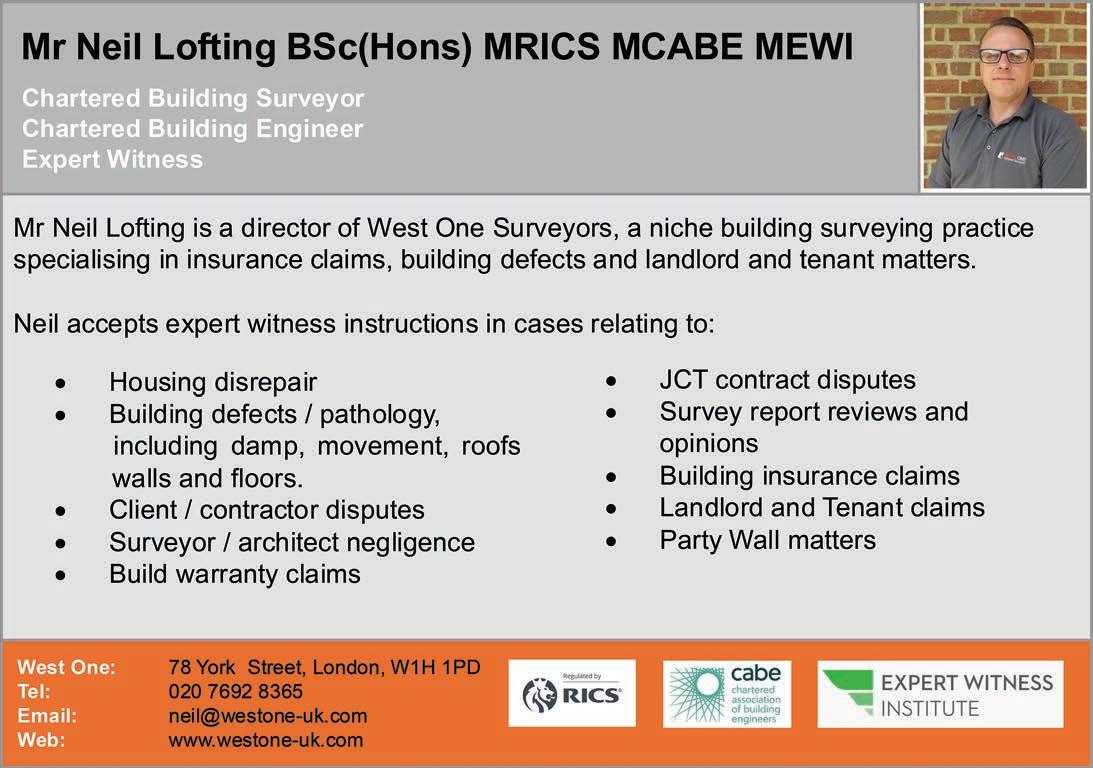
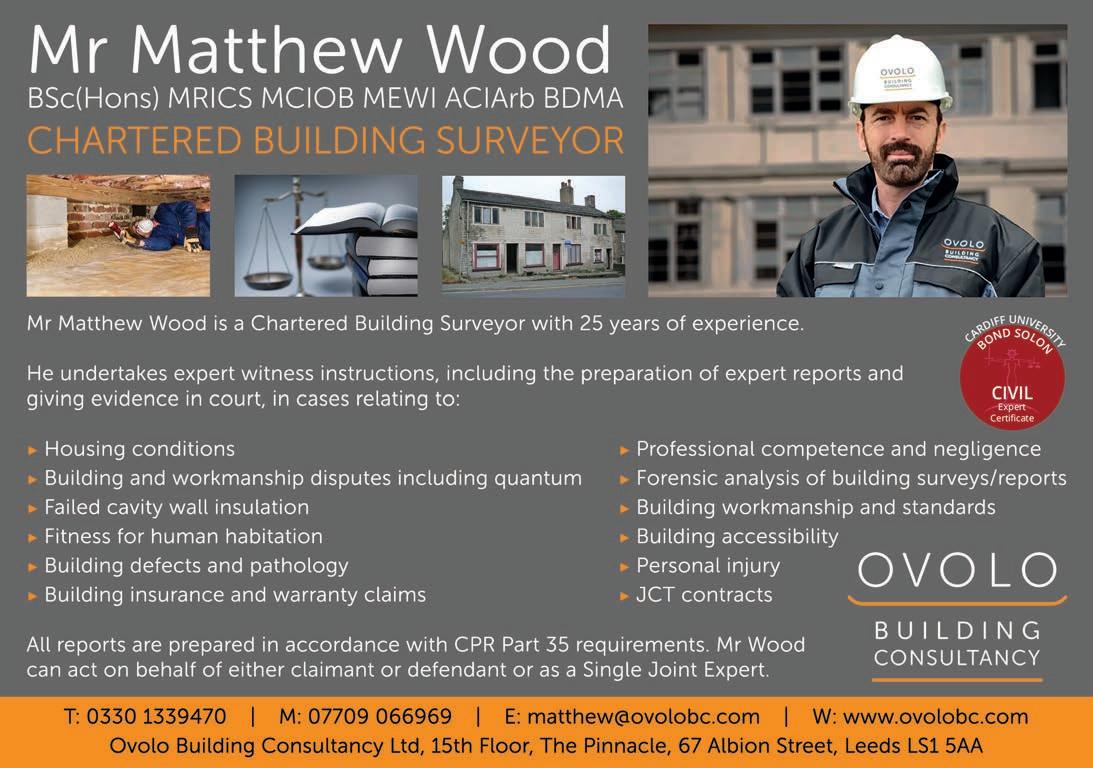
[THE ISSUE OF DISREPAIR and particularly mould in the rented housing sector is continuing to attract the attention of the media. The tragic death of little Awaab Ishak in Rochdale particularly thrust the social housing sector into the spotlight and prompted a swift and drastic response from the then-government.
In a letter to social housing providers
Housing Minister Michael Gove said: “The Coroner’s report into Awaab’s death described a catalogue of failures and a housing provider that abdicated its responsibilities to the family and failed to take appropriate steps to remedy the situation. This was completely unacceptable. This guidance sets out to landlords the existing

[ON 21 MAY the Supreme Court upheld a ruling that developers can recover costs from structural engineers for remediation works it carries out, even when the developments in question have been sold and the developer no longer owns the properties.
According to the court’s report: “The respondent is a property developer who had engaged the appellant as a structural design consultant in connection with multiple high-rise residential developments. In March 2020, the respondent brought a claim in negligence against the appellant in relation to structural design defects it had discovered in the developments. The respondent had discovered the defects after having sold the developments to third parties. It nonetheless performed remedial works to rectify the defects, the cost of which forms the basis of the losses the respondent claims against the appellant.”
The developer was BDW Trading, trading under the names Barratt Homes and David Wilson Homes and the structural engineer was URS Corporation Ltd, now part of Aecom.
The court’s summary continued: “It was common ground that URS assumed responsibility to BDW under its contracts for professional services and breached the resulting duty of care by providing defective designs.
“In principle, therefore, BDW had a claim in the tort of negligence for its loss (ie the cost of the repairs). However, URS argued that BDW was not entitled to any compensation because BDW carried out the repairs voluntarily, in circumstances where: (i) it had no proprietary interest in the developments; and/or (ii) it had no legal obligation to do so (because all claims against it were time-barred). URS argued that English law recognised a principle of voluntariness which rendered BDW’s loss outside the scope of URS’s duty and/or too remote.”
The Supreme Court rejected the appeal by URS on four grounds, in particular ruling that there was no ‘voluntariness’ because of the risk of injury or death to the homeowners.
A spokesperson for BDW’s parent company Barratt Redrow said: “We are pleased that, in this landmark case, the Supreme Court has dismissed the appeal on all grounds and clarified the responsibility of wider companies for remediating defects in developments they were involved in building.
“Whether remediation is required because of defects in design, supply of inappropriate products or workmanship issues, it is vital that the companies who played a part step up and put things right, as we have done with the developments in this case.” q
laws around damp and mould and the penalties for not complying with them.”
In the private rented sector the role of housing disrepair experts has become increasingly prominent. Instructing solicitors handling claims involving damp, mould, structural defects, poor insulation and other unfit living conditions rely heavily on independent expert evidence to assess breaches of statutory obligations and support claims for damages.
Under the Homes (Fitness for Human Habitation) Act 2018, the Landlord and Tenant Act 1985 and the Housing Health and Safety Rating System, landlords are legally required to maintain properties to a safe and habitable standard. Despite that, many rented homes fall short. As a result, solicitors acting for tenants need clear, impartial assessments to determine whether a landlord has failed in their duties and whether that failure has had a harmful impact on the tenant.
Experts in housing disrepair – typically chartered surveyors, building consultants or environmental health professionals – inspect properties and produce detailed reports. Experts are able to distinguish between issues arising from structural or maintenance failures and those due to tenant behaviour or other factors.
Expert assessments are also invaluable in claims involving third parties, such as managing agents, housing associations or insurers. By identifying the root cause of a defect – be it a structural fault, water ingress or inadequate ventilation – experts help solicitors identify the responsible party and shape legal strategy accordingly. This early clarity minimises the risk of misdirected or speculative claims and helps ensure efficient case progression. q
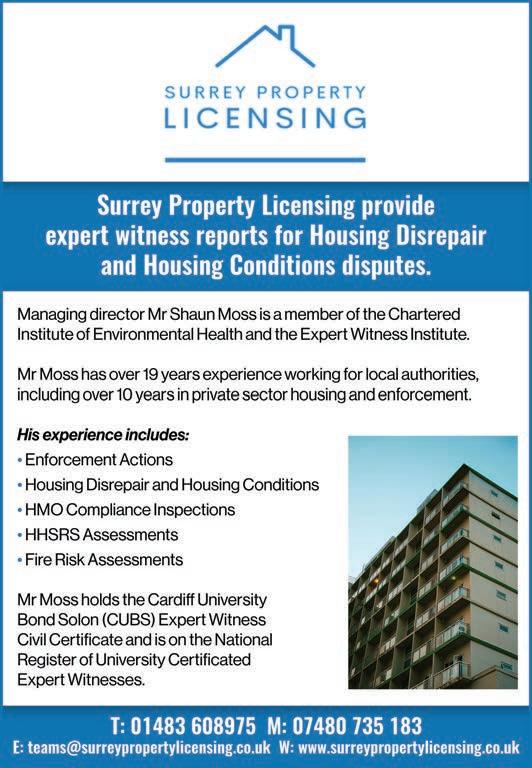
[IN 2023 the Office for Product Safety and Standards (OPSS) commissioned Warwick Manufacturing Group to conduct independent research into product safety risks associated with lithium-ion batteries, chargers and conversion kits when used with e-bikes and e-scooters.
OPSS has now published the resulting research which provides a significant step forward in understanding the complex issues relating to those products and strengthens the evidence base. The research explored:
• How battery failures occur during real world
• use and environments, including scenarios of
• foreseeable misuse or modification
• The types of processes and materials used in
• product manufacture that achieve safer
• design and safer use of lithium-ion batteries
• Potential shortcomings in technical
• requirements in product standards that have
• not kept pace with technological innovation
Tackling the rise in fires related to e-bikes and e-scooters is a priority for government. OPSS is continually assessing the most effective regulatory interventions to implement in order to tackle the problem.
OPSS is also carefully assessing the evidence to inform its future activity and is working to support wider government and interested stakeholders on future actions that could be taken to improve the safety of those products.

In December 2024 the government published new statutory guidelines for businesses producing and distributing lithium-ion batteries for e-bikes. The guidelines set out that such batteries must contain mechanisms capable of preventing thermal runaway in order to be considered safe products.
OPSS is also assessing products and conducting checks on businesses selling e-bikes, e-scooters and kits used to convert standard bikes to e-bikes, both online and on
the high street. Since 2022 there have been 21 product recalls and 29 Product Safety Reports published for unsafe or non-compliant e-bikes or e-scooters subject to corrective action.
The activity follows the launch of the government’s Buy Safe, Be Safe consumer information campaign, which was launched in October to raise awareness of the risks and provide safety advice for consumers purchasing e-bikes, e-scooters and lithium-ion batteries. q

[ THE COLLAPSE of the Cheshire Fire and Rescue Service (CFRS) prosecution of four companies in relation to the 2019 fire which gutted the Beechmere retirement complex in Crewe was due to questions over the ‘independence, impartiality and competence’ of the fire officers’ expert evidence.
In a statement, Crown Office Chambers – representing two of the defendants – said that, after arguing the evidence was inadmissible, “the prosecution conceded that they [the defendants] were right and offered no evidence on all counts on the indictment.”
The statement went on to explain that the judge in the case at Chester Crown Court, His Honour Judge Leeming, “stated that he would have ruled in the defendants’ favour in any event”.
That position was confirmed by Temple Garden Chambers, who also represented two defendants, and whose own statement said their argument had been that “the prosecution had failed to comply with the Criminal Procedure Rules applicable to expert evidence”.
Alex Waller, Chief Fire Officer at CFRS, said: “Following extensive legal submissions heard over the first two days of the trial, unfortunately it became clear this morning that there would be no realistic prospect of securing convictions. After carefully considering legal advice, regrettably we have taken the very difficult decision to withdraw our prosecution case against all four defendants.
“We understand that former residents of Beechmere and their families will be disappointed with this outcome, which is not the one we have been working hard to achieve.”
In its report on the case, the Fire Protection Association quoted one legal professional involved in the case, speaking anonymously to Inside Housing , as saying: “If the trial had run, verdicts would
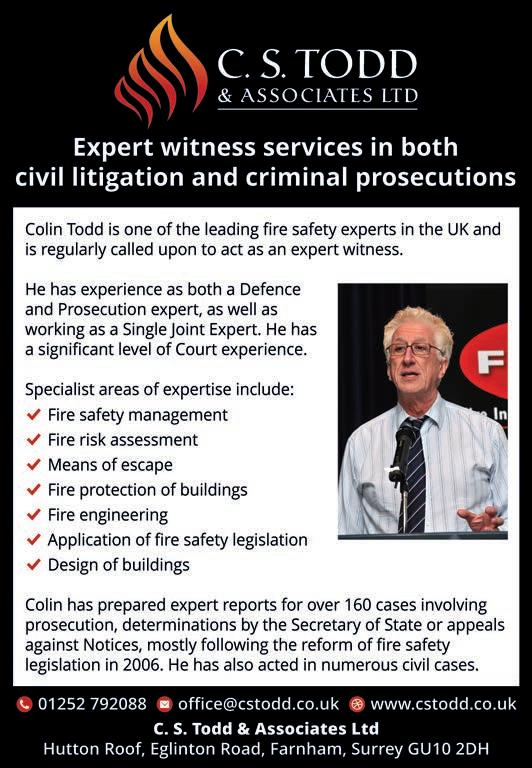
have been delivered almost six years after the fire, and four years after our client was informed it was under investigation.
“For those affected by the fire and their families, that’s an unbearable delay. For our client, a growing family business with a stellar reputation at stake, it brought enormous strain. A strain that the acquittal, welcome as it was, will do little to alleviate.
“All the more so when there will be no recovery of costs incurred or time spent reading papers and speaking with lawyers in preparation for a trial that never came.” q
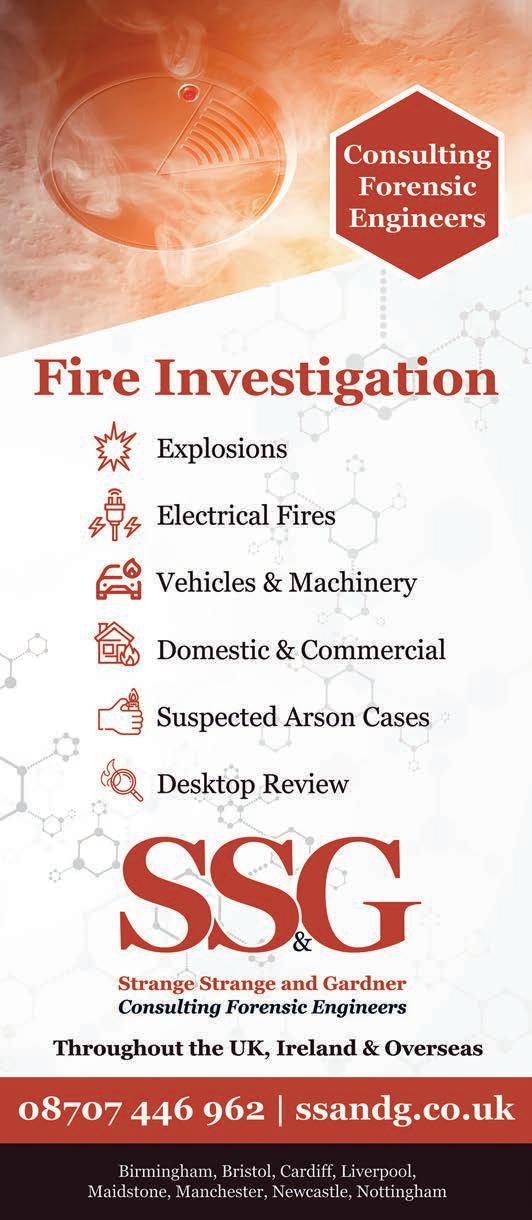
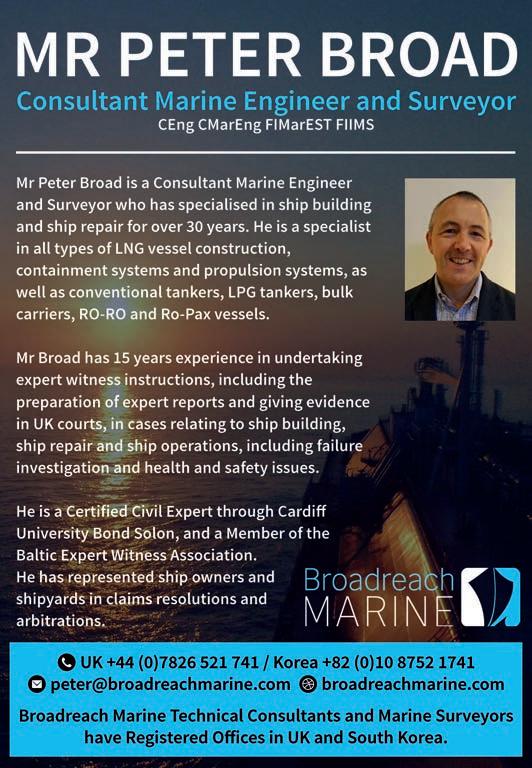



[MARITIME LAW can seem the most arcane of all legal specialisms. Dating back to when Britannia ruled, if not the waves themselves, most of what travelled on them, it is still often referred to as Admiralty Law. And most disputes are still decided in London. In the ensuing 300 years or so a framework of international conventions, contractual arrangements and domestic legislation has arisen.
It is inevitable that disputes arise and they may become protracted. For the resolution of those disputes – whether through the courts, via arbitration or mediation – there is often a requirement for informed, objective expertise to clarify technical or operational issues.
That is where the expert witness comes into play. They are usually
[WITH NEW environmental regulations due to be ratified by the International Maritime Organization in October, Martin CrawfordBrunt, emissions lead at Baltic Exchange, explained what it means for shipowners.
The regulations represent a clear shift from those seen in the past. Instead of setting fixed rules in response to specific incidents, the new measures focus on overall goals and outcomes. Crucially, there is no one-size-fits-all approach, so success for shipping players will rely on understanding what ‘good’ looks like in terms of commercial performance, operations and environmental impact.
That is where Baltic Exchange plays a vital role. Acknowledging the need for clarity and credible data, it has developed a suite of free-toaccess tools available on the Baltic homepage, under its ‘emissions’ tab, to help members navigate the evolving landscape. From decarbonisation calculators to benchmarking services, the resources are designed to assess the commercial implications of fuel choices and technological investments, allowing its members to move forward with confidence. Feedback on how the calculator is used or suggestions for improvement are very welcome and can be sent to emissions@balticexchange.com
The practical support is already proving valuable. Take liquefied natural gas, for example, which is often seen as a transitional option when it comes to decarbonising operations. How effective it is depends on a wide range of factors, including the type of engine used on board, the route the vessel takes and the equivalent energy factors compared to traditional heavy fuel oil.
Those are the kind of details that Baltic’s tools are helping to uncover. More generally, they let users test assumptions, work out payback periods for energy-saving devices and plan realistic strategies for staying compliant in a complex and changing landscape. q
experienced maritime professionals such as master mariners, marine engineers, naval architects or surveyors, who can provide independent insight into the complex issues involved.
One of the most protracted and complex disputes in recent times has been that concerning the MSC Flaminia, a container vessel owned by Conti 11 Container Schiffahrts-GMBH & Co and under charter to MSC Mediterranean Shipping Company SA.
The case goes back to 2012, when a fire broke out following an explosion on board the ship while en route from South Carolina to Antwerp, causing loss of life and extensive damage to the ship and its cargo.
The protracted dispute arose from the efforts of the charterer to limit their liability under the terms of the 1976 Convention on Limitation of Liability for Maritime Claims. That followed an arbitration award of around US$200m in 2021.
The case progressed from court to court over the following three years, leading to an agreed settlement of $290m last year. However, because of the perceived need for clarification of the terms of the 1976 agreement –particular the ‘insider/outsider’ element – the Supreme Court was asked to give a judgement. That judgement was given on 9 April this year.
The Supreme Court allowed the appeal on one issue but dismissed it on a second. The conclusion was that: “MSC is entitled to limit under article 2.1(e) of the 1976 Convention in respect of the claim for the costs of discharging sound and damaged cargo, and of decontaminating the cargo at Wilhelmshaven, but not otherwise.”
Following the judgment, Christopher Garley, a partner at HFW, solicitor for the respondent, wrote online: “The arguments in the Flaminia limitation action have covered a lot of ground, and it has been interesting to see the lower courts construe the language of the LLMC 1976 to reach the same conclusion (owners’ claims were not limitable) by very different routes.”
He added: “The certainty of the Supreme Court’s decision is welcomed. While claims for loss of or damage to the vessel (or consequential losses resulting therefrom) are not limitable under article 2.1(a), they may still be limited if they fit within the specific provisions of article 2.1.” q

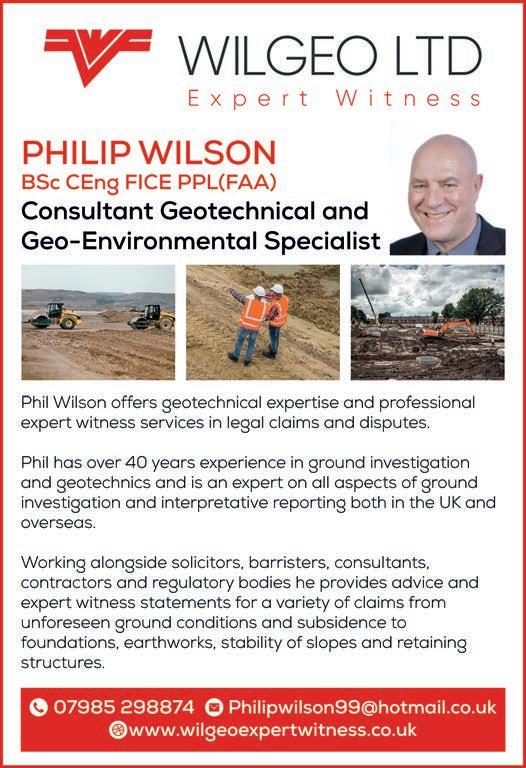
[FROM 6 APRIL the UK’s Competition and Markets Authority (CMA) has been granted significantly enhanced enforcement powers under the Digital Markets, Competition and Consumers (DMCC) Act.
The legislation equips the CMA with the ability to impose direct and severe penalties on businesses found to be in breach of consumer law, including those guilty of misleading environmental claims or ‘greenwashing’.
Sarah Mukherjee MBE, CEO of the Institute of Environmental Management and Assessment (IEMA), said: “From Sunday, the Competition and Markets Authority has new enforcement powers to fine companies up to 10% of their global annual turnover if they deliberately mislead consumers about green claims. This decision highlights the importance for organisations to have in-house sustainability professionals who can provide an evidence base against which marketing and product claims can be made.”
Simon Colvin, an IEMA Fellow and environmental law expert at Weightmans, says the new enforcement powers should not deter companies from making green claims, but should be seen as an opportunity to ensure rigorous governance around sustainability where advertising on this basis is concerned.
“The Net Zero agenda in the UK has been growing for some time, and it’s an important step bringing green claims into the CMA’s wheelhouse in terms of penalties. These new enforcement powers should help to level the playing field where green claims are concerned – we have seen this responsibility taken up previously by the Advertising Standards Authority, so it’s good to see the CMA being given a greater role in this space too.”
“Crucially, the new approach is not a court-based process, meaning the CMA has the power to impose direct penalties on businesses found to be in breach of consumer law by creating misleading environmental claims.” q

By Dr Mark Hinnells, director of Susenco Consulting Ltd, London and Hong Kong
Fiduciary duty is the obligation of a decision-maker to act in the best interests of their client. Trustees, fund managers, directors – even cabinet ministers – have a fiduciary duty. The whole financial system rests on discharging it appropriately. Should the discharge of fiduciary duty have regard to environment, social and governance (ESG) issues and climate change? And if so, how?
Which is more important: ESG or climate
Environment, social issues and governance issues are not created equally. The E should be for ‘existential’ risk: both climate and biodiversity risks. In the case of the S and G, it is harder to measure impacts, opportunities and costs objectively; and different practices in different countries mean standards are not universal.
Climate change impacts and risks can not only be measured, but there is a legal chain of obligation – from the Paris Agreement 2015 to agree for the world to halve emissions by 2030 and achieve net-zero emissions by mid-century; through to the Nationally Determined Contributions, or commitments each member state of the UN makes; through to national policy, which varies widely but is moving towards incentivising carbon emissions reduction in investments and assets.
At corporate level, some forty stock exchanges have implemented a common reporting framework for both ESG and for climate (under IFRS S1 and S2) and there is an emerging framework for pricing carbon – the World Bank estimates that around a quarter of the world’s carbon emissions are in a carbon market.
That makes it much easier to incorporate climate into financial reporting and risk management. Biodiversity is following. As Mark Carney put it when he was Governor of the Bank of England: “Unless we put a price on carbon, we end up with a misallocation of capital.”
There is an intimate and inevitable linkage between climate, risk and the future of capitalism:
• CO 2 emissions directly increase the amount of energy trapped
• in the Earth’s atmosphere.
• Extreme weather drives direct physical risks to all categories of
• assets.
• The insurance industry has historically managed those risks,
• but premiums in some places are starting to exceed what
• people or companies can pay, or insurers won’t carry the risk.
• That is a systemic risk: an asset that cannot be insured cannot
• be financed. That could become a climate-induced credit crunch.
• Some argue that the state would step in where insurers
• withdraw. But that assumes the state – ie the taxpayer – wants
• to, or can afford to.
• Many risks do not lend themselves to meaningful adaptation;
• for example, cities built at sea level are hard to relocate.
• At a certain level of warming, risk cannot be transferred (no
• insurance); risk cannot be absorbed (no public capacity); and
• risk cannot be adapted to (physical limits exceeded).
• Mortgages, insurance and investment products like pensions
• and life insurance would all be affected, with much greater
• financial instability. That is an existential threat to capitalism
• and an invitation for litigation.
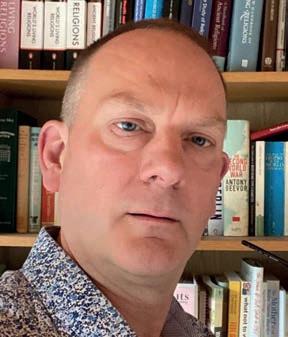
The societal costs of climate change have been studied extensively and estimates vary from 20% of global GDP by 2050 to 50% by 2080 or so – this latter by the Institute and Faculty of Actuaries. Those risks mean their consideration in long-term wealth management is a fundamental part of the duty of a fiduciary. How is that being translated into policy?
In the UK climate change is now a clear part of fiduciary duty. The Pensions Regulator requires a ‘Statement of Investment Principles’, which must consider ‘financially material considerations over the appropriate time horizon of investments [long enough to consider environment, including climate change]’. The Pensions Schemes Act 2021 (S124) puts Paris Agreement targets on the face of pensions legislation, and reinforces fiduciaries’ duties to act in the best interests of scheme members regarding climate change. Other jurisdictions are following with a patchwork of law, policy and guidance, redefining Fiduciary Duty.
For the time being the courts appear to be deferential to whatever approach fiduciaries choose to adopt to ESG and climate change. For example:
• In McGaughey v Universities Superannuation Scheme: A challenge on grounds of insufficient action on climate risk was rejected, though the court did not engage with the risk of future loss.
• In ClientEarth v Shell: The English High Court rejected a claim against Shell's directors for failing to address climate change. The court concluded that decisions on a company’s strategy are a matter for directors, not the court or claimants.
• In Butler-Sloss v Charity Commission: Paris Agreement-aligned investments by charitable trustees were seen as appropriate by the court, even when they didn't maximise financial returns, because Paris Agreement alignment was consistent with the purpose of the trust.
• In Wong v New York City Employees Retirement System: Plaintiffs claimed pension trusts did not maximise returns and instead impermissibly pursued a pro-ESG policy agenda. The case was summarily dismissed.
How long courts will allow fiduciaries freedom to ignore Paris Agreement targets and national policy remains to be seen.
In conclusion, ESG and climate carry both risk and opportunity. Fiduciaries may have a duty to report and a duty to manage risk, with implications for changed investment priorities and plans. Increasingly, investors and beneficiaries are taking an interest in decisions made by fiduciaries. Disagreements may need advice, arbitration or even a court decision. Susenco would be happy to help in those circumstances. q

[ THE ROYAL HORTICULTURAL SOCIETY
describes Japanese knotweed as a ‘persistent, clump-forming herbaceous perennial. It was introduced to the UK as an ornamental garden plant but has since become an invasive weed subject to legal control measures.’
It is designated as an invasive non-native plant according to Schedule 9 of the Wildlife and Countryside Act 1981.
Its pink buds form in the spring, followed by reddishpurple shoots emerging. From that time growth is rapid, the hollow, bamboo-like stems growing up to 30cm per day. It is also recognisable by its spade-shaped green leaves which grow to about 14cm in length.
The nuisance of the Japanese knotweed is to be found underground, where its roots and rhizomes extend down to one metre or more. Rhizomes are creeping swollen root-like structures that are actually adapted stems. In the case of Japanese knotweed they lie dormant in the winter and reactivate in the spring.

The hard rhizomes can cause damage to hard surfaces. It can exploit joints, cracks and weaknesses in surfaces such as paving, tarmac and asphalt, allowing shoots to emerge and create uneven surfaces. It can also alter and degrade the banks of watercourses. Japanese knotweed often colonises the banks of rivers, streams and ditches; this can contribute to erosion and increase the likelihood of flooding.
The RHS explains the legal situation: “It is not an offence to have Japanese knotweed growing in your garden, but it is an offence to plant or cause to grow in the wild and you should take steps to prevent it spreading. Additionally, a relevant environmental authority can order control measures if they deem such action necessary.
Due to Japanese knotweed’s invasiveness, its negative impacts on native species and the environment, and the implications it has on buying and selling properties, most people want to get rid of it.
The easiest and most effective way to remove Japanese knotweed is to hire a professional company that specialises in the removal of invasive weeds. They can provide information for mortgage purposes, including suggested treatment plans, and offer insurance-backed guarantees where required.”
The advice from the RHS extends to tips on action needed when buying or selling.
“Since 2013, a seller is required to state whether Japanese knotweed is present on their property through a TA6 form: the property information form used for conveyancing. Your conveyancer or solicitor will be able to provide full legal advice, but these are the key points:
“If you are selling, it is your responsibility to check the garden for Japanese knotweed (bearing in mind it dies back in winter). The TA6 form asks you to confirm whether your property is affected by Japanese knotweed, where it is, and to provide a management plan for its eradication.
“If you are buying, the presence of Japanese knotweed will be stated in the responses to the TA6 form. This often results in your mortgage lender requiring assurances that it will be eradicated before agreeing the funds. A management plan by a professional eradication company, backed by a transferable guarantee, is usually sufficient. It is most common for this plan to be provided by the seller before the purchase is completed.
“Whether buying or selling, it is worth being pro-active and checking
the property for Japanese knotweed. Disputes over the identity of a plant, the failure to disclose its presence, or the lack of a management plan can result in delays, increased costs later in the buying process, or even a possible misrepresentation claim after the sale, so this approach helps to avoid problems.” q

[IN 2022 the RICS published a new Guidance Note on the perennial problem of Japanese knotweed. The publication, Japanese Knotweed and Residential Property, was an update to a RICS Information Paper published in 2012.
With nearly one-and-a-half million homes estimated to be affected by Japanese knotweed in the UK, the perennial weed’s presence can devalue a property or cause sales to fall through entirely due to misinformation that’s been fuelled by fears around what it is capable of doing; but with appropriate remediation from expert professionals the worst needn’t happen.
The purpose of the updated document was to provide guidance based on market informed industry best practice and to ensure RICS members provide the best advice to users of valuation and condition reports.
The document contains a decision tree based on risk level to help valuers determine the appropriate management approach needed for Japanese knotweed. The new process delivers a straightforward and objective categorisation of Japanese knotweed infestations, because that provides the clarity that is essential for lenders and will continue to ensure confidence and trust among the wider stakeholders.
Philip Santo FRICS, the author behind the new guidance, said: “Creating confidence and awareness that knotweed isn’t a death sentence for home sales is a key principle behind this guidance – it’s certainly not the ‘bogey plant’ that some make it out to be.
“In most instances the weed can be remediated with effective treatment – so it’s critical that all those involved in the home buying and selling process have access to unbiased, factual information, that sets out when they need to obtain reputable remediation services.” q

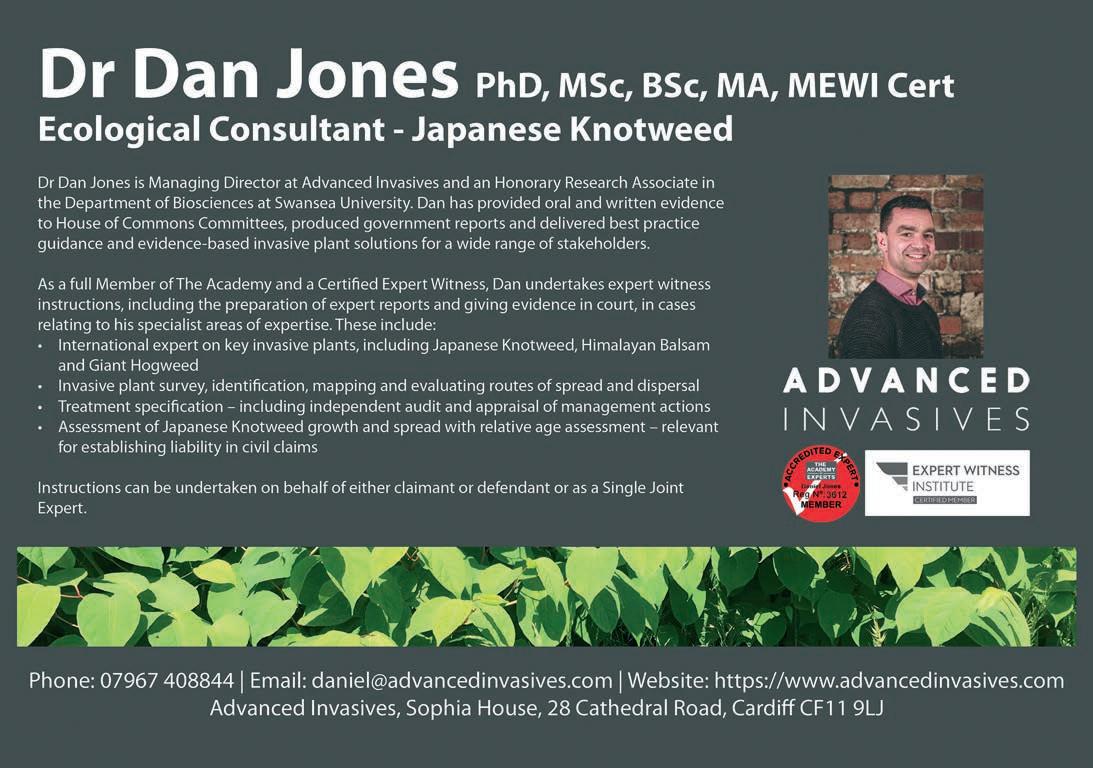
By Mark Chester, of Cedarwood
[
I HAVE BEEN PROVIDING my services as an expert witness for treerelated cases for more than 20 years. The question of ‘why?’, which I apply to every case I am asked to consider, remains as important now as ever. It is not always appreciated, but can ensure that the team instructing me is as informed as possible.
The ‘why?’ I am referring to is, in essence, one of feasibility. It is a question of: “Why am I involved in this case? Why does the claimant consider they have a case, or from the point of view of the defendant, that their opponent does not have a case?” With most cases I am instructed on there is the potential that I could be asked to attend a hearing in court. I need to be satisfied that the instructing party has a case to defend before I can commit. I often need to appraise the evidence in order to identify key issues. Conveying news to a party that either their claim is not sustainable, or that the enforcement claim against them has merit, is not easy or pleasant. However, for the former it can ensure that they do not commit resources to pursuing an unsustainable claim. For the latter it may persuade a change of plea and more favourable penalty.
The ‘why?’ of the law enables me to focus on the key issues. They may not be apparent at the start of my investigation, and I may need to undertake my own research to identify that element. Often, my instructions come directly from a claimant. They may not appreciate the protocol of my involvement, and the need to establish key issues. Part of my role is recognising that sometimes I am the key witness, and on other occasions I will only be called once the key issue has been established. That is often the situation with boundary disputes, where determining the position of a boundary may be preliminary.
In one case I was involved with a boundary hedge had been damaged by heavy pruning. My role was to identify both the cause of damage and the cost of replacement. Once the conveyancing experts had determined that the hedgerow was encroaching, my opinion was no longer needed: the damaged part of the hedge had evidently grown over the boundary and the court decided that the defendant had been entitled to cut back, even though that caused damage to the feature.
There can be occasions – including when a claimant has instructed their own expert – when, as I read through the report of that individual, it becomes apparent that they might not have appreciated the key issues. That can happen when the other expert writes their report focusing on the issues raised by their client. On several occasions I have been instructed to appraise the merits of claims for compensation following tree felling and/or pruning in connection with power line clearance works.
Claimants have sought funding for more substantial tree planting than was offered by the utility company. Sometimes there is not an option for planting any replacement trees: a point that both claimant and expert may either have overlooked or not appreciated.
Meeting with a client and asking them why they consider they have a claim is often beneficial, as it enables them to explain their rationale and to cite any evidence they may wish to refer to. There may be documents I have not been presented with, or observations that the client may have, including insights, which can easily be overlooked. That can include background information and scene setting.
In one case, the client was explaining to me why they did not consider themselves guilty of the enforcement claim being brought. The trees they had felled were unsafe and their contractor had not been willing to fell them with a chainsaw. The absence of any written account of that observation, by e-mail, text or letter, meant it was an observation that could not be presented to the court. I had to explain to the defendant that he was not a specialist in tree safety, and therefore his own observation that ‘it was obvious the tree was unsafe’ was not a sustainable position.
In another case, I had been provided, by the client defending a claim, with details of the notably inclement weather at the time that a tree was uprooted. I also found details of the weather on the Wikipedia website and included that in my report.
The barrister for the claimant observed that Wikipedia is not necessarily reliable, and suggested that that evidence was not sustainable. I now routinely ensure that, if weather is a factor in a claim, I have checked historic weather records for the period in question – and done it myself.

Often I am only presented with sufficient information to enable me to write my report, and the lack of full disclosure is not shared. That can be beneficial in ensuring I do not have excessive evidence, especially if that is not pertinent to my own investigation. The wider context can be illuminating.
In one case, I found the statement of one key party was not supported by other evidence supplied. That is unusual. I discussed the case with the instructing party, wondering whether a site visit would be needed.
The instructing party wryly observed that the individual had already changed their account several times as the conflicting evidence was explained. It was unlikely there would be a need for a site visit – such was the strength of the case.
One valuable aspect of the ‘why?’ is that it can enable me to allocate balance and be proportionate in reaching my conclusions. Sometimes the key aspects of a case can change, and whether that is at report-writing stage, briefing or in a hearing, the ability to re-appraise is important. In one case, where I was observing, I had noted from reading the report of one of the parties, an expert, that they had made a conclusion based on an assumption. I mused that, if the assumption proved to be incorrect, that individual would need to re-evaluate their conclusion, which seemed to be significant as a basis for the claim being brought.
During questioning clarity was brought, and the assumption did, indeed, prove to be incorrect. The expert was reluctant to accept that. Being calm under pressure is important for the expert witness; however, also being prepared to concede a point is important, otherwise there is a risk of being seen to be an advocate for one’s client, which is contrary to protocol. I am not sure that that expert was sufficiently nimble; I was only an observer, but the judge hearing the case was unusually well informed of the key issues and undertook some direct questioning. As the point was finally conceded, His Honour sighed: “At last we have agreement”. I would wish to avoid being the recipient of such an observation from the bench.
Identifying the ‘why’ is important in establishing key issues in a case. It enables the report to be written in an informed way that is succinct. It ensures that the merits of a case have been properly established. It may ensure that key evidence, otherwise overlooked, is properly considered. It may result in conclusions that the instructing party did not expect. It can help to ensure that cases without merit are not pursued. For me, it provides assurance that, if I am needed for a court hearing, my involvement is with merit. q

By Dr Ian Randle BSc MSc PhD MErgS C.ErgHF of Hu-Tech Experts
[ MANUAL HANDLING INJURIES remain one of the most common causes of work-related musculoskeletal disorders in the UK, with thousands of claims brought each year under personal injury law. At the heart of many of these cases lies a central question: was the task designed and managed in a way that made injury foreseeable and preventable?
Answering this requires more than an understanding of training, equipment or processes – it requires an understanding of how humans interact with their work environment. That is precisely where the ergonomist’s expertise comes into play.
An ergonomist, also known as a human factors specialist, brings a distinct, human-centred perspective to evaluating manual handling injury claims. While engineers may focus on the mechanical properties of lifting equipment or the structural integrity of storage systems, ergonomists are uniquely trained to assess the interface between the task and the human body. It includes evaluating posture, lifting technique, the physical demands of the task and the capacity of the individual worker. Unlike purely technical assessments, ergonomic analysis recognises that injury risk cannot be fully understood by examining load weights or equipment specifications alone. For example, a load may fall within basic weight guidelines, yet still exceed what is safe for a particular individual to lift repeatedly without undue strain. Conversely, an ergonomist’s analysis may also demonstrate that a task superficially
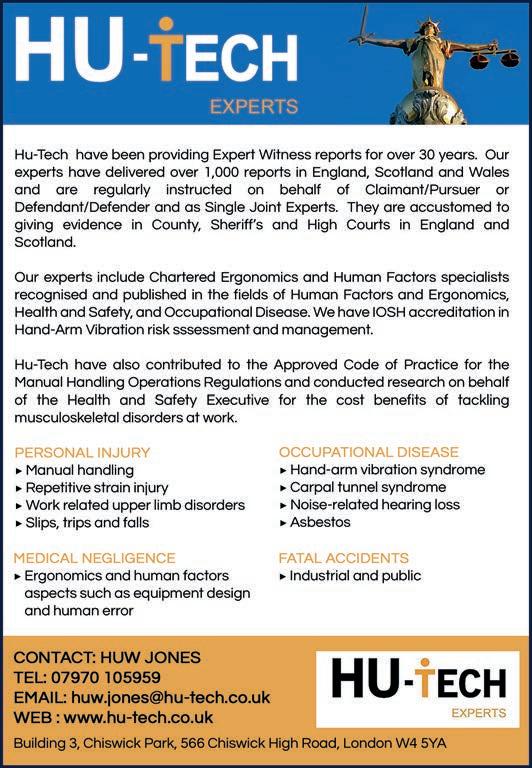
perceived as hazardous is, in fact, reasonably safe when human factors and task design are considered.
This holistic approach makes ergonomists well placed to provide expert evidence on whether the risk of injury was foreseeable from a human biomechanics perspective.
In investigating manual handling injuries, ergonomists employ a range of evidence-based techniques to provide objective analysis. These may include:
• Task analysis: structured observation and documentation of the task,
• identifying factors such as awkward postures, repetitive movements,
• twisting or reaching
• Biomechanical assessment: calculating the forces exerted on joints and
• the spine during lifting or carrying, using validated models to assess
• whether physical demands exceed safe guidelines
• Environmental evaluation: examining factors such as space
• constraints, floor surfaces, lighting and temperature – all of which can
• influence injury risk
• Worker capability assessment: considering individual
• differences in strength, stature and health that may affect safe
• performance of the task as well as their state of training
Through these methods, ergonomists provide detailed, scientifically grounded opinions on whether a task was designed and managed with due regard for the worker’s capabilities and limitations. The analysis goes beyond what an engineer or safety professional might offer, focusing not only on systems and equipment but on the human as an integral part of the work system.
For lawyers involved in manual handling claims, ergonomist evidence is instrumental in addressing key legal issues. Ergonomists can assist in answering questions such as:
• Was the manual handling task reasonably safe for the exposed
• workforce?
• Were appropriate control measures implemented to reduce
• foreseeable risk?
• Was the employer’s approach consistent with statutory
• obligations and industry standards?
Their testimony can clarify complex technical matters for the Court by linking task demands directly to the mechanism of injury, grounding opinions in both scientific principles and practical workplace realities.
Crucially, ergonomists can provide objective evidence in both claimant and defendant cases – whether showing that injury risks were inadequately controlled or that the task was reasonably safe and managed in line with regulatory requirements. This human-focused insight complements, rather than duplicates, the expertise provided by engineers or occupational health specialists.
As workplaces continue to evolve – with growing use of automation, hybrid working and ageing workforces – the role of ergonomists in litigation is likely to become even more significant. Their ability to interpret work design through the lens of human capability will remain critical in ensuring that legal decisions are informed by a nuanced understanding of how people interact with their work environment. Whether instructed by claimant or defendant legal teams, engaging an ergonomist offers access to a specialist dimension of expertise – one that ensures the human element is not overlooked when evaluating injury claims. q

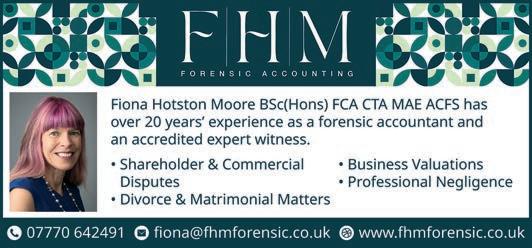

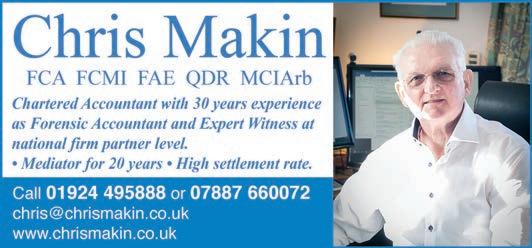
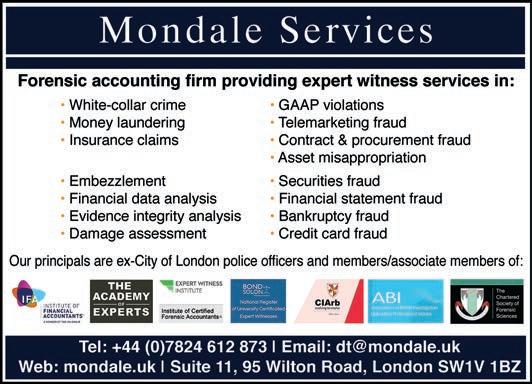


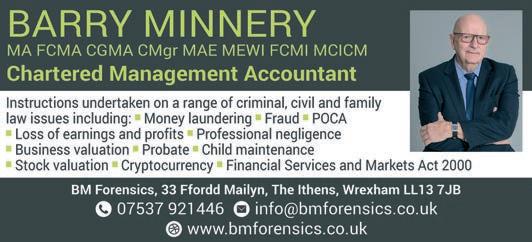



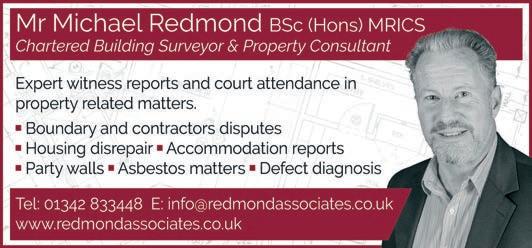





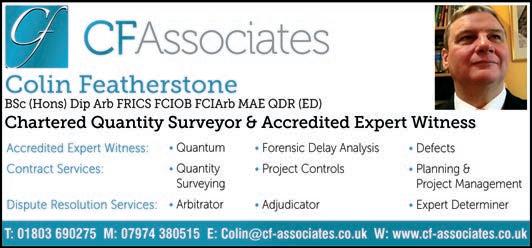
COLLISION INVESTIGATION & RECONSTRUCTION
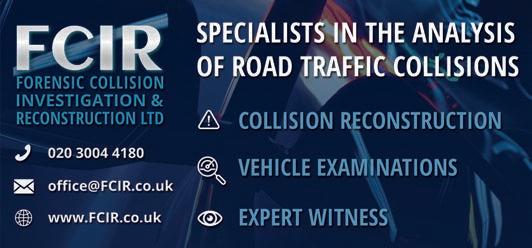


COMPUTER & MOBILE FORENSICS
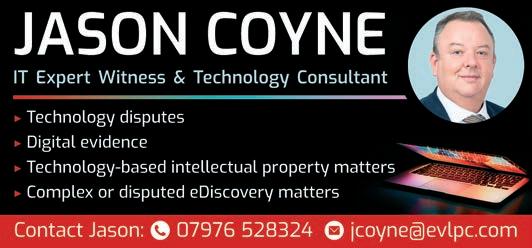
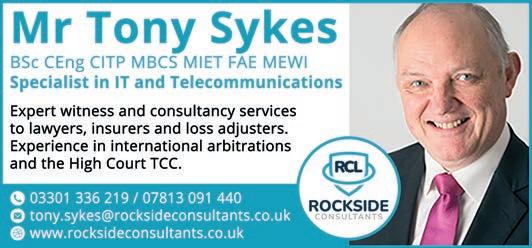

DIGITAL TECHNOLOGY


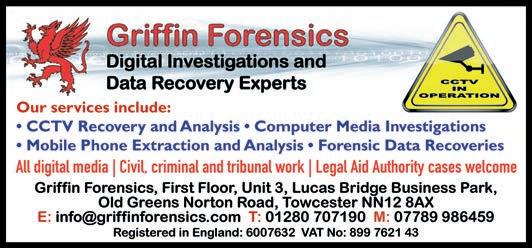



ENGINEERS

EQUESTRIANS



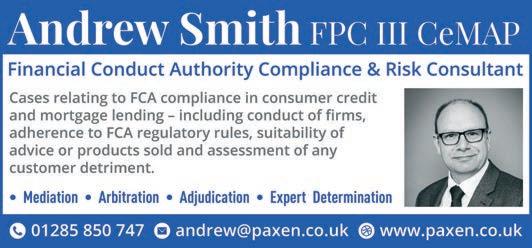

GEOTECHNICAL CONSULTANTS

INSURANCE
MECHANICAL & PROCESS ENGINEERING FIRE
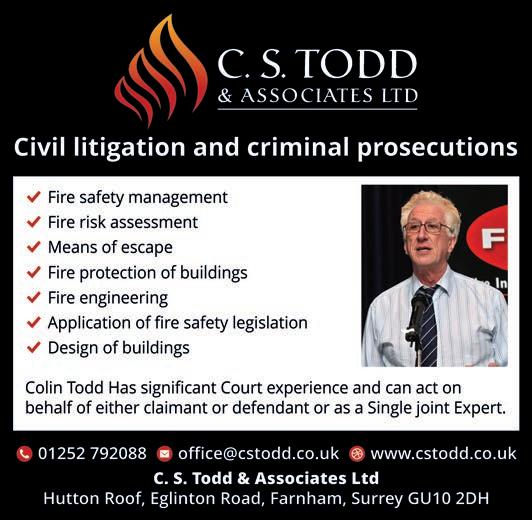


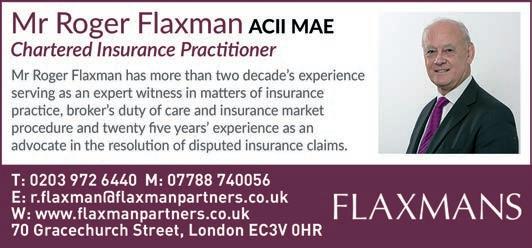


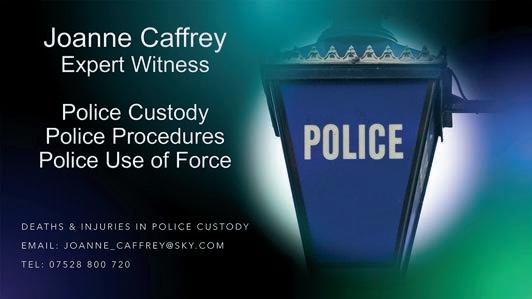

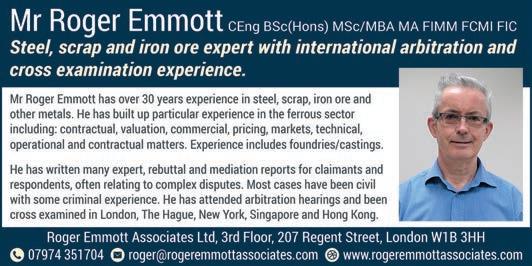

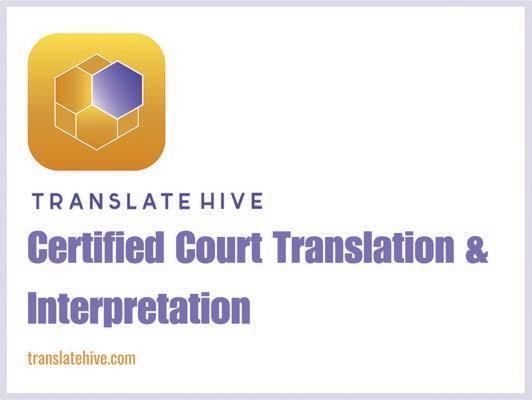
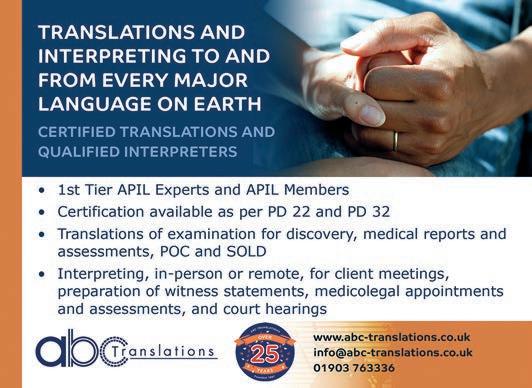




Translations and Interpreting for the Legal Profession since 1997. Specialists in Personal Injury and Clinical Negligence. www.abc-translations.co.uk
Andrew F Acquier BA FRICS
Chartered Art & Antiques Surveyor
Expert witness reports and representation at court for matters involving: • Divorce settlements • Insurance valuation disputes
• Arts litigation • Contentious Probate
www.andrewacquier.co.uk
David Berry PhD FRC Path MFSSoc MRSC
Independent Toxicology Consultant
Specialist in Clinical and Forensic Toxicology with particular emphasis on drugs (both illicit and therapeutic) and alcohol. www.toxicologyservices.co.uk
Professor Paul J Ciclitira MB PhD FRCP MRCS FRCP AGAF
Professor of Gastroenterology with particular interest in food allergy, including Coeliac disease, peptic ulcer, inflammatory bowel disorder and hepatology. www.profpaulciclitira.co.uk
Dr Sarah Cockbill Expert Pharmaceutical Witness PhD BPharm MPharm LLM DAgVetPharm FRPharmS FVPA
• Pharmacology • Drug Interactions • Formulation
• Appropriate Dosage • Veterinary Pharmacy • Drug Licensing Instructions for claimant, defendant or as Single Joint Expert
E: cockbills1@gmail.com
Mr Philip Coleridge Smith DM MA BCh FRCS
Consultant Vascular Surgeon
20 years of:
• Defendant instructions • Claimant instructions
• Single joint expert • Court experience





www.adsummedicolegal.com & www.britishveininstitute.com
Clarke Gammon
Chartered Surveyors with experience in All Aspects of Property • Residential property values
• Asset valuations • Land values and more www.clarkegammon.co.uk
Chris Dawson MS FRCS LLDip

Consultant Urologist with 20 years experience of medico legal report writing and expert witness work and has completed over 1,850 reports. He also regularly completes Fitness to Practice reports for the General Medical Council.
www.chrisdawson.org.uk
DRC Forensics Limited


DRC Forensics Limited offers the complete range of forensic accounting & litigation support: • Fraud • Money laundering
• Partnership disputes • Loss of profit • Professional negligence www.drcforensics.co.uk
Mr Mark Duxbury MA (Oxon) DM FRCSEd (Gen Surg)
Consultant Hepatobiliary, Pancreatic & General Surgeon
• General & emergency surgery • Hernia surgery
• Liver & pancreatic surgery • Gallbladder & biliary surgery
• Laparoscopic surgery • Hepatobiliary surgery www.markduxbury.info/medicolegal
Equip2Speak
Specialists in Brain and Spinal Injury. AT Consultant
• CUBS Certified Expert since 2012 • Accident, Negligence and Criminal Cases • Experienced in High Value Claims
• Claimant/Defendant/Joint Instruction
www.equip2speak.co.uk
Face Restoration
• Complications of cosmetic eyelid surgery
• Brow lift surgery • Ptosis • Non-surgical aesthetics
• Orbital diseases • Watery eyes • Thyroid eye disease www.facerestoration.com
FHDI - Kathryn Thorndycraft-Pope




Examining documents & handwriting • to determine authenticity • to expose forgery • to reveal aspects of origin. Electro Static Detection Apparatus and Mi-Scope used. www.forensichandwriting.co.uk
Mr Roger Flaxman ACII MAE
Chartered Insurance Practitioner with more than two decade’s experience serving as an expert witness in matters of insurance practice, broker’s duty of care, insurance market procedure and as an advocate in the resolution of disputed insurance claims.
www.flaxmanpartners.co.uk

Forensic Collision Investigation & Reconstruction Ltd
Specialists in the analysis of road traffic collisions
• Collision Reconstruction • Expert Witness
• Vehicle Examinations
www.FCIR.co.uk
Formedecon Ltd
Forensic & Investigative Services to the Legal Profession
• All Aspects of Forensic Work Undertaken
• LAA and Privately Funded • Free Estimates www.Formedecon.com


Griffin Forensics eForensics and Data Recovery Experts
• CCTV Recovery and Analysis • Computer Media Investigations • Mobile Phone Extraction and Analysis • Forensic Data Recoveries
www.griffinforensics.com
Mr Kim Hakin FRCS FRCOphth
Consultant Ophthalmic Surgeon and Expert Witness on ophthalmological matters
www.kimhakin.com
Dr Dan Jones PhD MSc BSc MA MEWI Cert


Ecological Consultant – Japanese Knotweed. Undertakes expert witness instructions, including the preparation of expert reports and giving evidence in court, in civil claims relating to the growth and spread of all invasive plants.
www.advancedinvasives.com
Haydn Jones MEng DipLaw FIET
Data Technologist & Digital Regulation Expert
• Injunctive relief • Money laundering
• Digital currency theft • Counter funding of terrorism E: h.jones@xchain.com

Atul Khanna FRCS (Plast)
Consultant Plastic, Reconstructive and Hand Surgeon
• Hand surgery • Soft tissue injury
• Burns management
• Medical negligence in cosmetic surgery www.atulkhanna.co.uk/expert-witness/



Dr Raj Kumar – Dental Expert
Causation and Liability and Condition and Prognosis Reports
• General dentistry • Cosmetic dentistry • Patient consent
• Dental implantology • Orthodontics • Facial aesthetics
07802 456 804 | info@dentalexpert.me | www.dentalexpert.me
Kulvinder Lall Consultant Cardiothoracic Surgeon
Instructions taken in cases relating to cardiac and thoracic surgery, including aspects relating to surgical care and those following trauma to the structures of the chest. www.kulvinderlall.com
Maggie Sargent & Associates
Internationally renowned provider of detailed and independent medical expert witness reports. We consistently provide our solicitors with meticulously prepared and highly trusted reports that put the client at the centre.
www.maggiesargent.co.uk
Mr Chris Makin
• Chartered Accountant • Accredited Civil Mediator
• Accredited Expert Determiner
www.chrismakin.co.uk




Mr Richard Matthews MB BS FRCS FRCSE MAE PLASTIC & HAND SURGEON
Mr Matthews is well versed in the provision of Medical Reports relating to Personal Injury ranging from scarring through trauma, including burns and scalds, to non-bony hand injuries.
www.richardmatthewsmedicolegal.uk
Mr Fredrik P Nath FRCS MBChB
Consultant Neurosurgeon
• Head injury • Spinal injury
• Acoustic neuroma • Lumbar and cervical degenerative disease • Musculo-skeletal injury including whiplash www.neurosurg.co.uk
Mr Abraham Odumala
MBBS M.MedSci FWACS FRCS FRCS(Tr & Orth)
Consultant Orthopaedic Surgeon – Upper Limb Specialist. Expertise in all upper limb conditions and treatment. Shoulder, elbow, wristand hand injuries. www.yorkshire-upperlimb.co.uk
Dr Shanthi Paramothayan
BSc PhD MBBS LLM MScMedEd FHEA FCCP FRCP
Consultant Respiratory Physician specialising in negligence cases relating to all aspects of respiratory medicine. www.paramothayan.com
Dr Stuart Porter Chartered Physiotherapist
PhD MCSP HCPC BSc Hons Grad Dip Phys MLACP PgCAP Cert.MHS SFHEA Specialist areas of expertise include: • Clinical negligence
• Breach of duty • Allegations of inappropriate contact • Assessment of adults and children • HCPC investigations. stuartbporter@aol.com
Simon Quinton Smith BSc FRICS MI Hort
Expert Witness to the Garden Centre & Horticultural Industry
• Rent Reviews
www.quintonedwards.co.uk
Professor Christopher Raine MBE
Specialist in paediatric and adult otology
• Medical negligence
• Personal injury cases involving noise induced hearing loss. www.profchrisraine.co.uk
Mr Sameer Singh MBBS BSc FRCS Orth
Consultant Orthopaedic Surgeon • All aspects of trauma – soft tissue and bone injuries • Upper and lower limb disorders and injuries
• Whiplash injuries • Expert Witness for defence and claimant
Clinic locations – London, Milton Keynes and Bedford
www.orthopaedicexpertwitness.net
Andrew Smith FPC III CeMAP
Financial Conduct Authority Compliance & Risk Consultant Cases relating to FCA compliance in consumer credit and mortgage lending.
• Mediation • Arbitration
• Adjudication • Expert Determination
www.paxen.co.uk


Prof. Elizabeth J. Soilleux MA MB BChir PhD FRCPath PGDipMedEd Expert Witness Pathologist with a particular interest in haematopathology. Short reports on specimens, full court compliant reports and expert biopsy reporting. www.expertwitnesspathologist.co.uk

Dr Ian Starke MSc MD FRCP
Stroke Medicine and Medicine for the Elderly Reports and examinations for clinical negligence and fitness to practise cases in stroke medicine and geriatric medicine www.expertwitnessinstrokes.co.uk







Mr. William E G Thomas Bsc, MBBS, FRCS, MS
Consultant Surgeon specialising in general surgery, hernia surgery, gastrointestinal surgery, hepatobiliary-pancreatic surgery, laparoscopic surgery and endocrine surgery
T: 0114 262 0852 E: wegthomas@btinternet.com W: www.wegthomas.com



UK Ophthalmology Experts
Dr Ravinder Varaich Dental Expert
BDS (University of Birmingham) MFGDP (RCS Eng) MAE
> Criminal cases > Personal injury > Clinical negligence

• Restorative dentistry • Periodontal disease • Endodontics • Dentures
• Oral surgery • Orthodontics • Cosmetic dentistry • Facial aesthetics
UK Ophthalmology Experts are a team of leading, independent ophthalmology experts covering all aspects of ophthalmology. ukophthalmologyexperts.co.uk www.dentalexpertreports.co.uk
DR S V MEDICALS (Mr Sen Venkat)
MSc Ortho (London) FRCS Consultant Orthopaedic Surgeon • Whiplash injuries • General trauma • Sports injuries
• Clinical negligence work • Joint replacement surgery of hip and knee • Hand, shoulder, elbow and wrist injury www.drsvmedicals.co.uk
WOODEXPERTS
Specialist Timber Consultancy and Training since 1991
• Site visits & investigations • Structural surveys
• Desktop analysis & review of documents • Specialist reports • Species identification
www.woodexperts.com
Ms Leyla Ziyal MPhil AFBPsS CPsychol
HCPC Registered clinical Neuropsychologist • Neuropsychological assessment and rehabilitation
Depression
Occupational stress • PTSD • Anxiety www.accentpsychology.co.uk




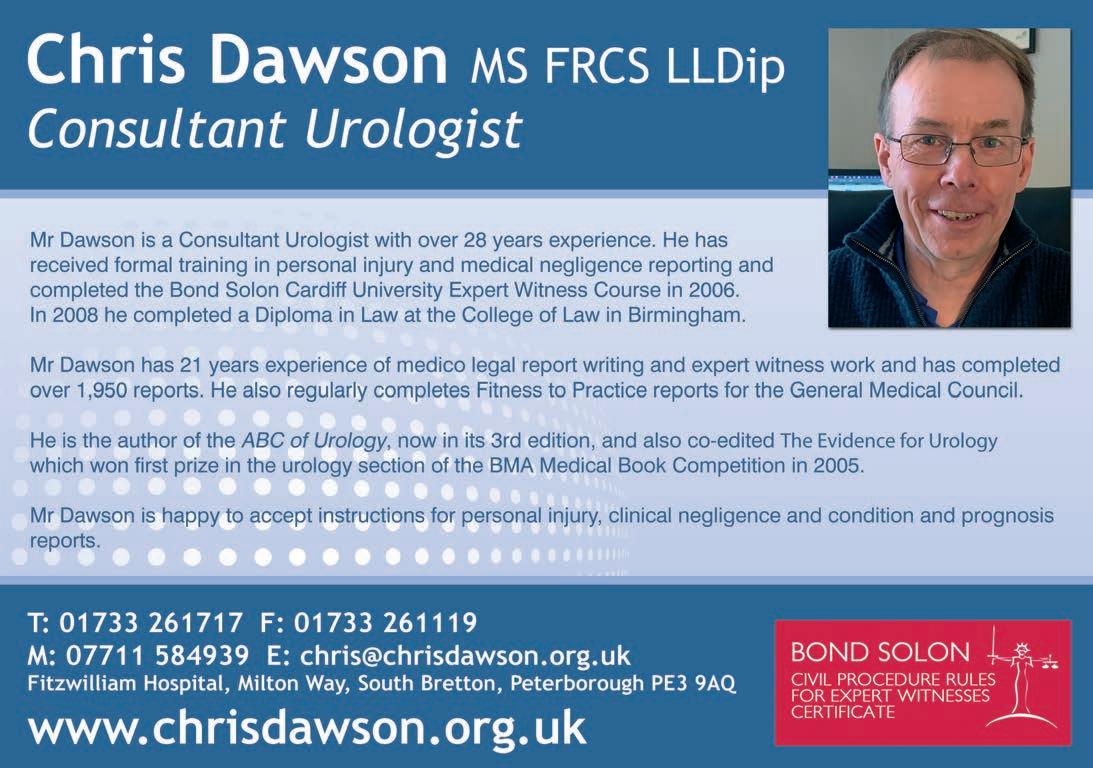


[A RECURRING THEME in the stories from the world of medicine in this issue is change: changes brought about by technological advance and those brought about by changes in attitudes. In terms of technological advance, two notable advances have caught the eye. In Nottingham a novel approach to obtaining a molecular diagnosis of brain tumour is dramatically reducing the speed that diagnosis will take. Tardy diagnosis is, of course, one of the main triggers for negligence claims.
Meanwhile, in Liverpool, co-operation between a neurosurgeon and an orthopaedic surgeon is reducing the speed with which spine pain patients can gain relief from a spinal implant.
• Any talk of technological advance these days must, at some point, include the words ‘artificial intelligence’. AI is everywhere, and the ability of machine learning to deliver analysis quickly is a major advance. But any machine learning program is only as good as its dataset, and the latest example in the medical field is Foresight – a system for using past events to predict future problems – which has as its dataset the medical records of the entire population of England. The information is ‘anonymised’, which we are assured ensures confidentiality.
• A more established use of technology in surgery is robotics. Orthopaedics in particular has been using robots for some time (some even refer to the new joints they are furnished with as ‘robotic’) which has enabled NICE to carry out an assessment of its efficacy. The early evaluation technique enables emerging technologies to be implemented at pace.
• It’s all change on the regulatory front, as well. Both the GMC and the HCPC – the two bodies that regulate doctors and other healthcare professionals – are having their processes for sanctioning members reviewed and modernised. The hope is for more flexible processes that sanction transgressions more effectively and swiftly.
• The ultimate cause for concern in the area of clinical practice, and one that is becoming more to the fore, is the involvement of the police. While negligence on any level can lead to tragedy, it is almost always unintentional. When clinicians’ behaviour becomes criminal we all feel uncomfortable.
The latest hospital trust to be investigated by police, as reported by The Guardian, is in Nottingham, which has been the subject of an inquiry by Donna Ockenden. There is a suspicion that the number of baby deaths there might extend to corporate manslaughter.
Not far away from Nottingham, in East Yorkshire, police are investigating the deaths of a number of elderly patients who underwent transcatheter aortic valve implants – the so-called TAVI procedure. Supposed to be safer than openheart surgery for the installation of new heart valves, the death rate at Castle Hill Hospital was three times that of the national average. There was also suspicion of malfeasance in the filling out of death certificates.
• For many victims of clinical negligence the injury transcends the physical and causes psychological problems. While many settlements include an amount for psychological stress, in extreme cases the psychological damage takes over as the principal injury. In such cases the writing of the report by the clinical psychologist can become a major expert report, as detailed by our contributor.
• Psychological harm caused by traumatic events can also affect those witnessing them at second hand, such as jurors in a trial. The material jurors have to view, in addition to the vicarious trauma they are exposed to during the giving of evidence, can cause jurors to suffer severe psychological harm. A study by researchers at Manchester Metropolitan University found a fourfold increase in PTSD. Most are referred to their GP. As we know, getting a GP appointment can be a traumatic experience itself. q


[THE GENERAL MEDICAL COUNCIL (GMC) has ‘warmly’ welcomed the government’s commitment to prioritising the reform of healthcare professional regulation in the UK. The doctors’ regulator says it has been a long-standing priority to modernise the regulatory framework for doctors.
In a statement the GMC said: “The current legislation that governs our work is more than 40 years old and is complex, overly prescriptive and slow to adapt. Reforming this will be a significant step towards creating legislation that better serves the needs of patients and the professionals we regulate, giving us the flexibility to respond more swiftly to patient safety risks and better support good practice.”
Regulatory reform will bring a range of benefits for patients and those on the register, including:
• Flexibility – the new legislation will allow the GMC to change its own rules
• when improvements are needed. Currently, even minor improvements to
• its regulatory framework require extensive Parliamentary time.
• Swifter and more efficient fitness to practise processes - reform will give
• the GMC greater flexibility to conduct investigations proportionately and
• to resolve cases more quickly. That will enable it to address patient safety
[THE CARE QUALITY COMMISSION (CQC) and the Human Tissue Authority (HTA) have updated their Memorandum of Understanding (MoU) agreement that sets out how they work together to share information and promote quality and safety.
The revised MoU was formalised in April and provides a clear framework to support the working relationship between both organisations. It highlights areas of co-operation and clarifies the boundaries of their respective areas of regulation.
CQC’s assessment of end-of-life care provided by an NHS or independent hospital focuses on the provision of specialist palliative care for patients who are approaching the end of their life and bereavement support for families following death.
CQC will also consider cold storage arrangements in cases when these are part of providing care for a person receiving a regulated activity. As an example, either in a care home or cold cot, arrangements to enable a parent to spend time with their deceased baby. CQC does not inspect mortuaries or body stores; however, it will assess some aspects of bereavement support, such as the mortuary viewing area, how the needs of different faiths and cultures can be met and plans to respond to major disasters.
The HTA is responsible for regulation in six areas:
• The use of bodies for anatomical ex amination, teaching and training
• Post mortem examination and post mortem tissue retention and disposal
• Public display of human bodies and tissue
• Organ and tissue donation, retrieval and transplantation
• The use of human tissue in research
• The use of human tissue and cells for medical treatment.
Dr Colin Sullivan, chief executive of the Human Tissue Authority said:
“Patient safety and maintaining public trust and confidence is at the heart of our renewed Memorandum of Understanding with CQC. We will continue to work closely together and share information to achieve these aims. I’m delighted to make this joint commitment, in collaboration with CQC’s chief executive officer Sir Julian Hartley.
Sir Julian Hartley responded: “CQC and the HTA have a shared commitment to promote patient safety and high-quality care. Close cooperation by sharing information relating to healthcare providers that are regulated by both organisations is essential in supporting that. We have updated our existing Memorandum of Understanding to provide greater clarity on our respective roles and ensure we maintain a consistent and co-ordinated approach where our work intersects.” q
• issues sooner, or close cases in a timely way where there is no current or
• on-going risk to public protection.
• Less adversarial fitness to practise processes – the current process
• provides limited opportunity to resolve cases without going to a tribunal,
• even where a registrant would be prepared to accept the regulatory
• action proposed. That prolongs resolution, increasing stress for both the
• registrant and witnesses. In future, senior decision makers will be able to
• propose what action they should take to protect the public at the end of
• an investigation. If a registrant accepts a finding that their fitness to
• practise is impaired and the action proposed to address it, the matter can
• be resolved without a hearing, leading to a quicker, less stressful
• conclusion, while continuing to protect the public.
• Streamlined approach to registration – a new single legislative framework
• will make the registration process more accessible and flexible by
• ensuring all registrant groups are assessed consistently based on their
• qualifications, knowledge, skill and experience.
• Supporting registrants - by improving the efficiency and effectiveness of
• the current processes, the GMC will be able to invest more of its
• resources in activities that support its registrants to give patients safe,
• high-quality care.
GMC chief executive and registrar Charlie Massey said: “We welcome this announcement from the Minister of State for Health and Secondary Care. Updating our antiquated legislation is a crucial step in enabling us to take a more responsive and flexible approach to regulation, and will make our processes simpler, faster and less adversarial.
“We remain ready to progress this as soon as the Department for Health and Social Care lays the necessary legislation. We look forward to working with them, patients and our registrants to ensure we deliver effective, relevant and compassionate regulation that benefits patient safety and ensures public confidence in the professions we regulate.” q
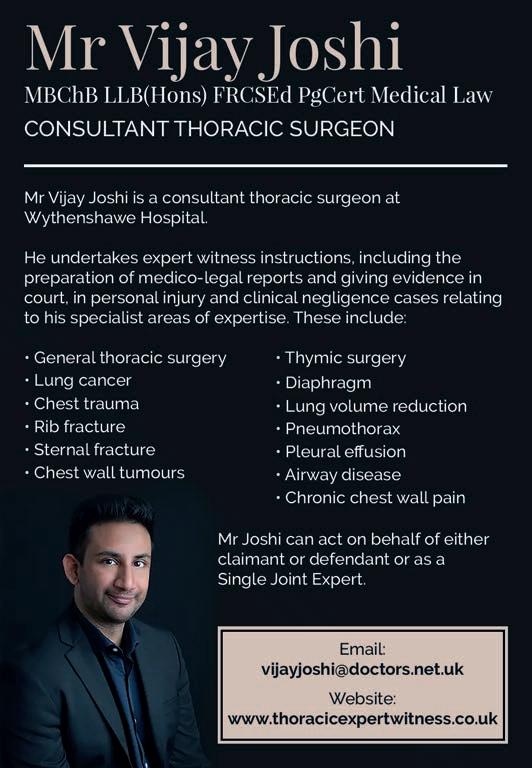
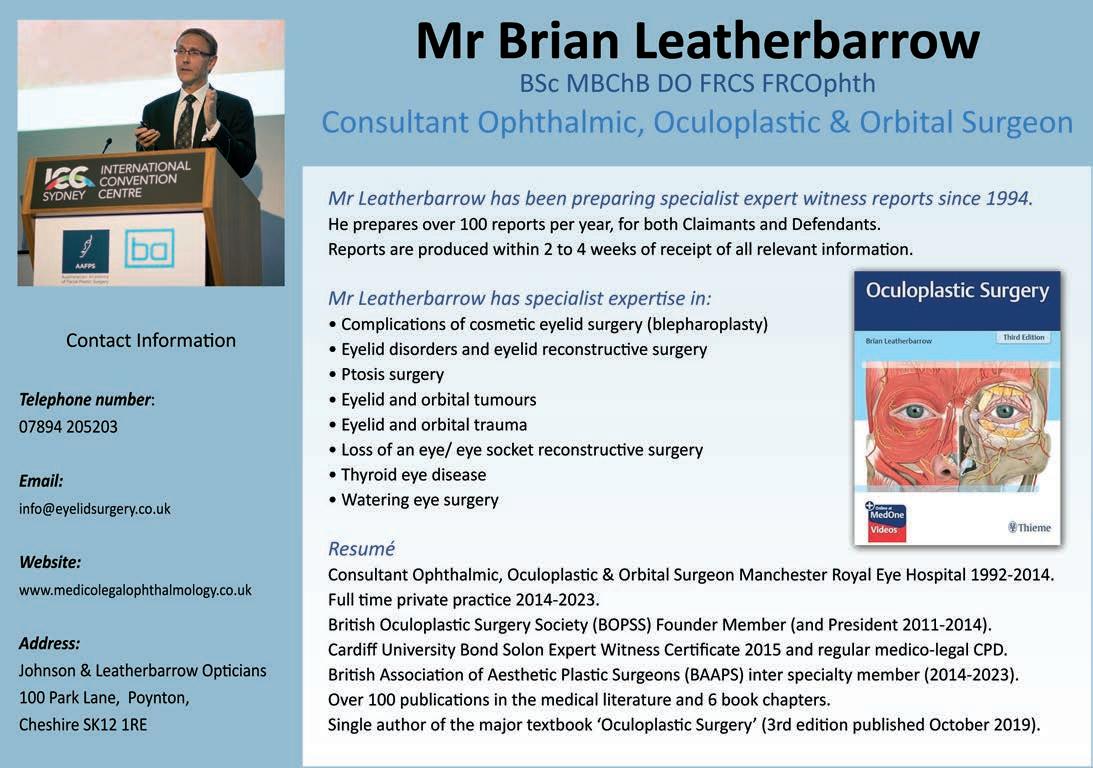
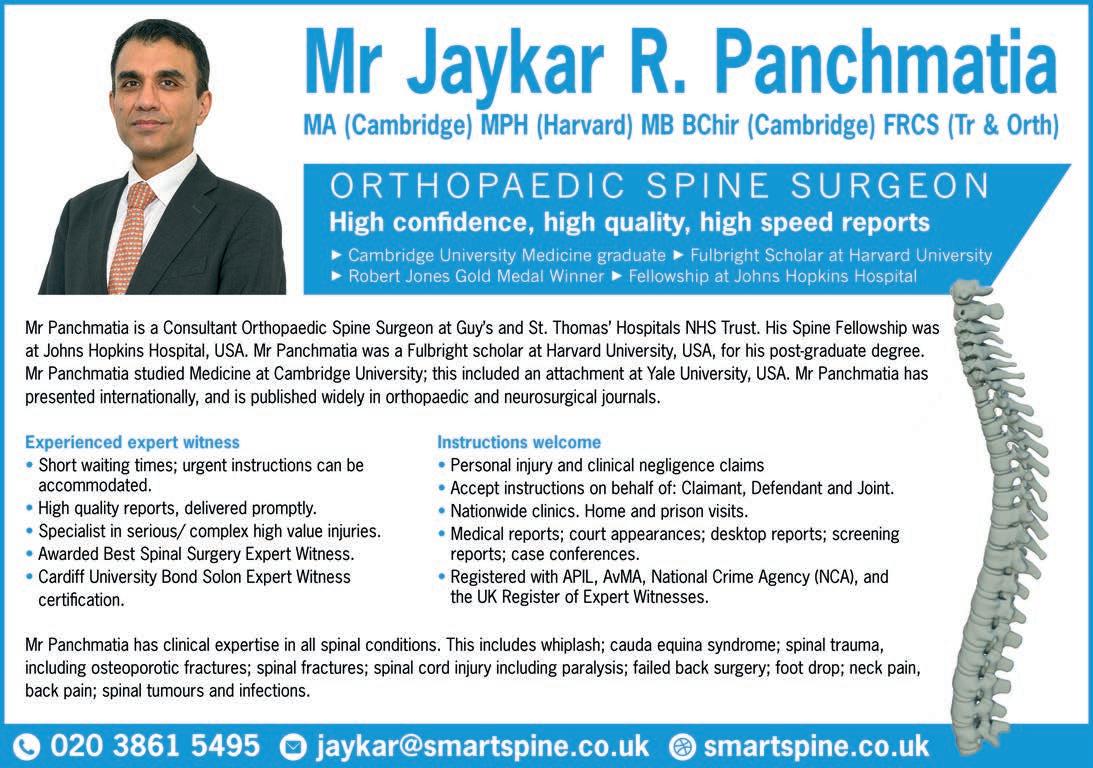
[USING DE-IDENTIFIED NHS DATA from approximately 57 million people in England, researchers at University College London and King’s College London are developing an innovative system to help clinicians, planners and policymakers predict health outcomes following the COVID-19 pandemic more effectively – while maintaining strict patient privacy standards.
Data integration and patient impact
Foresight is an AI model specifically designed for healthcare that has been trained in the NHS England Secure Data Environment (SDE) on deidentified NHS data. Like ChatGPT, Foresight learns to predict what happens next based on previous events, working like an auto-complete function for medical timelines. Predictions are validated against real-world data.
The NHS England SDE provided secure access to extensive de-identified records to train Foresight AI. It included:
• Data from 57 million individuals, including hospital admissions,
• vaccinations and other medical records
• Over 10 billion healthcare events across more than 40,000 types – for
• example, admissions, diagnoses, procedures and medications
• Records spanning November 2018 to December 2023
By accessing population-wide data, Foresight AI also studies minority groups and rare diseases, which are often overlooked when using smaller datasets.
Dr Chris Tomlinson, honorary senior research fellow at University College London, explained: “AI models are only as good as the data they are trained on. To benefit all patients the AI must be trained on data that represents everyone.”
Training large language AI models like Foresight requires significant computing power. Industry partners Amazon Web Services and Databricks provide that essential resource while never accessing the data or AI model. The research team's access to the SDE was facilitated by the BHF Data Science Centre at Health Data Research UK, following rigorous approval processes and involving members of the public in approving and shaping the research.
Only approved researchers working under strict NHS governance can
[THE Health and Care Professions Council (HCPC) is reviewing its sanctions policy to improve consistency and further strengthen decisionmaking by independent fitness to practise (FTP) panels.
The sanctions policy is a guidance document that outlines the principles for determining appropriate outcomes of FTP cases. It is designed to support panels in making fair, consistent and transparent decisions, ensuring that regulatory outcomes maintain public confidence and uphold professional standards. The policy was last updated in 2019.
Key areas in which the HCPC is proposing changes relate to sanctions imposed for discrimination, breaches of professional boundaries and sexually motivated misconduct. The proposed changes will provide more clarity and guidance for panel members when deciding on the appropriate sanction in HCPC FTP cases.
The updates will further support them to make informed, fair, proportionate and consistent decisions that maintain trust and confidence in health and care professions and protect the public.
The HCPC has been working with stakeholders such as professional bodies, unions and panel members to inform the proposed changes, to ensure they effectively meet the needs of the public and the professions it regulates. The consultation closes on 1 September. q
access the data, which remains within the SDE at all times, as does the trained model. Industry partners provide infrastructure but cannot access the raw data, AI model or any outputs.
Michael Chapman, director of data access and partnerships at NHS England, commented: “Foresight shows the incredible potential of AI combined with secure access to the deidentified data held in NHS England's SDE. This project is paving the way for smarter, more predictive healthcare –helping us improve patient outcomes across the UK.”
In the future the researchers would like to train the model further on deeper data sources, going back further in time. They’re also exploring how to responsibly expand the scope of the model, which is currently restricted to COVID-related research.
Professor Richard Dobson, professor of medical bioinformatics at King’s College London, explained: “The current dataset is broad but shallow. We hope to improve Foresight-SDE by incorporating richer sources like clinician notes, blood tests and scans.”
However, the researchers are clear: patients and the public also must be at the heart of any guidance developed around the model’s use and predictions, to make sure this research and its applications are in their best interests.
A public contributor involved in reviewing and approving this project, said: "As a patient, I’m interested in how this research could help identify linked health conditions, reduce the risk of developing new ones, and support those who face challenges accessing healthcare.
“It’s important that people know how their health data is being used, so it’s encouraging to see a focus on transparency and making sure AI is used in the NHS in a safe, ethical way with public benefit at its heart.” q

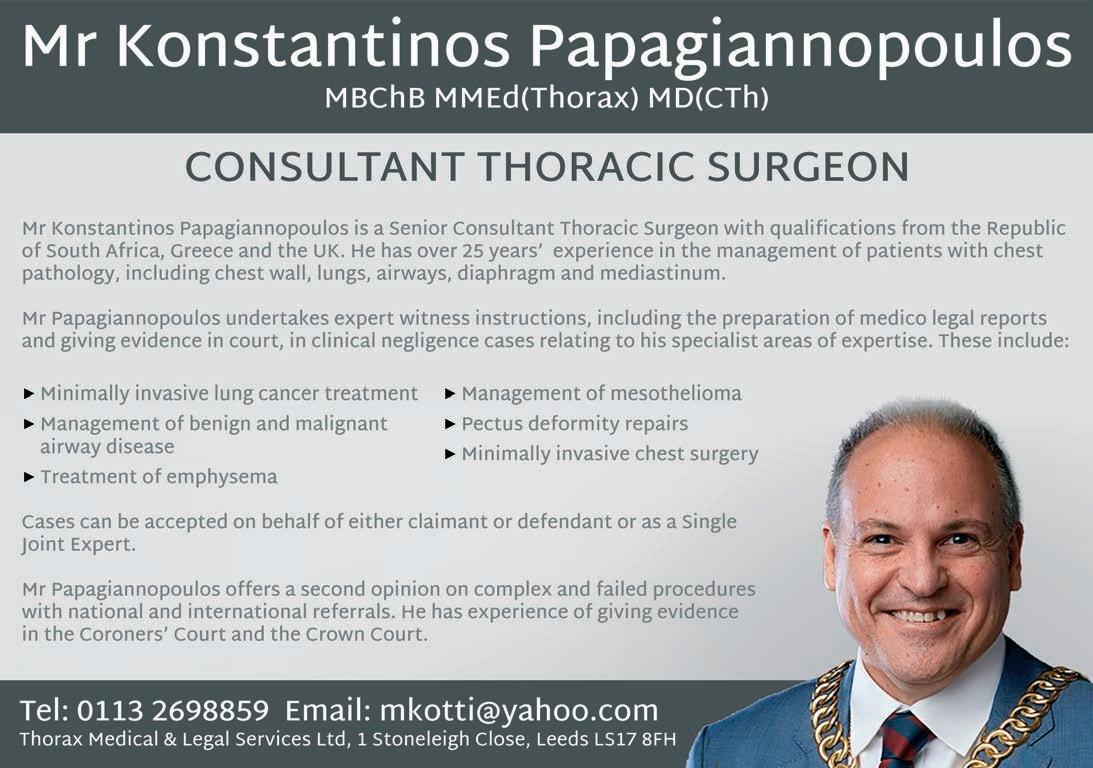

[ON 2 JUNE The Guardian carried a report that the police had launched a corporate manslaughter inquiry into Nottingham University Hospitals NHS Trust, law firm Lime Solicitors has reported.
The firm’s Neil Clayton wrote: “The police inquiry follows the largest investigation that we have ever seen in relation to deaths and injuries to more than 2,000 babies at the trust, which covers the Queen’s Medical Centre and the Nottingham City Hospital. This review is being conducted by the respected midwife Donna Ockenden, who had

[ A NEW LAW requiring healthcare staff to always be open and honest with patients and families when there are safety failures during treatment is long overdue in Northern Ireland, personal injury lawyers have said.
“Introducing a ‘duty of candour’ law would mean clinicians, managers and senior leaders have a clear statutory obligation to be transparent when negligent treatment has happened,” said Oonagh McClure, the Northern Ireland representative of campaigning group the Association of Personal Injury Lawyers.
“A duty of candour law in operation would mean all staff are legally required to be forthright when patients have been the victims of sub-standard care. All too often patients suffer further anguish when they are left in the dark as to what went wrong when they suffer harm.
“A candour law would ensure patient safety is at the centre of health care. And if negligent treatment occurred a legal requirement to be frank means lessons can be learned and avoidable suffering is not repeated.
“The Northern Ireland Inquiry into Hyponatraemia Related Deaths, which found some deaths were due to avoidable medical errors and a flawed healthcare culture, recommended a candour law back in 2018, but nothing came of it. It’s time to act,” she added.
The Department of Health for Northern Ireland is currently consulting on proposals to introduce its Being Open Framework, which aims to establish a culture of honesty and openness in healthcare.
“We support introducing the framework, but it must be accompanied by a candour law, because without statutory enforcement the framework lacks teeth. The proposals being discussed at present are an opportunity to make a real positive difference to patient safety and improve the experiences of injured patients who deserve answers,” said Ms McClure. q
previously conducted a review into similar failings at Shrewsbury and Telford Hospitals NHS Trust.”
According to Neil Clayton, Ms Ockenden was appointed to carry out her review because there were concerns about the number of stillbirths, neonatal deaths and serious injuries to babies born at the trust. Added to that were concerns that deaths had been ‘covered up’ and that parents were led to believe that what had happened to their child was unavoidable.
It is understood that lots of babies suffered hypoxic brain injuries in the period prior to birth leading to them dying while being born (still birth) or to them having serious hypoxic brain injuries – often referred to as cerebral palsy. Such injuries have lifechanging effects upon families. There are few worse tragedies than experiencing a stillbirth, while children with cerebral palsy often require lifelong specialist care.
Addressing concerns that claims against the hospital for negligence may be affected by the police inquiry, Neil wrote: “The police inquiry is unlikely to affect your claim. Corporate manslaughter is a very rare charge to bring. For a successful prosecution for this crime, it will have to be proven that the deaths of babies occurred as a result of a gross breach of the duty of care owed by the hospital to its patients. It would be necessary to show that severe failings on the part of the senior management at the trust had led to the deaths of babies. The standard of proof will be the very onerous ‘proof beyond reasonable doubt’.
“To win a medical negligence case, an individual must show on balance of probability (more likely than not) that they were injured by negligence, whether by the organisation or a clinician (whether that be a consultant, junior doctor, midwife or other professional). This is still far from easy to prove but is not quite as hard as prosecuting a hospital trust for corporate manslaughter.” q
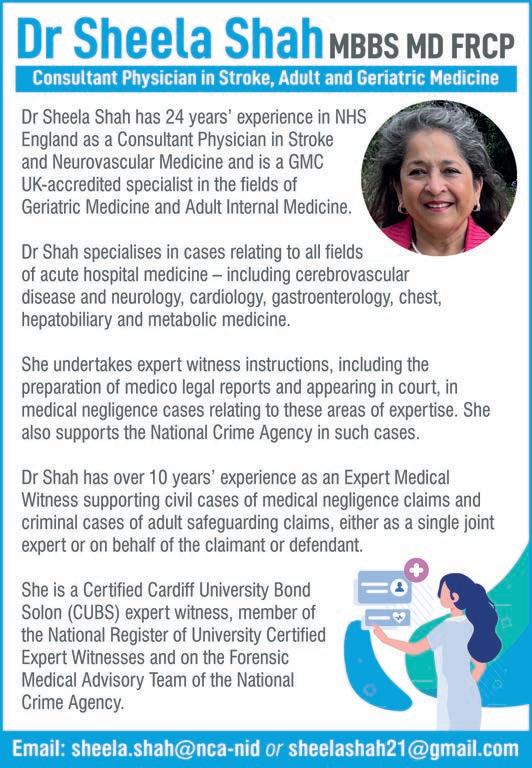
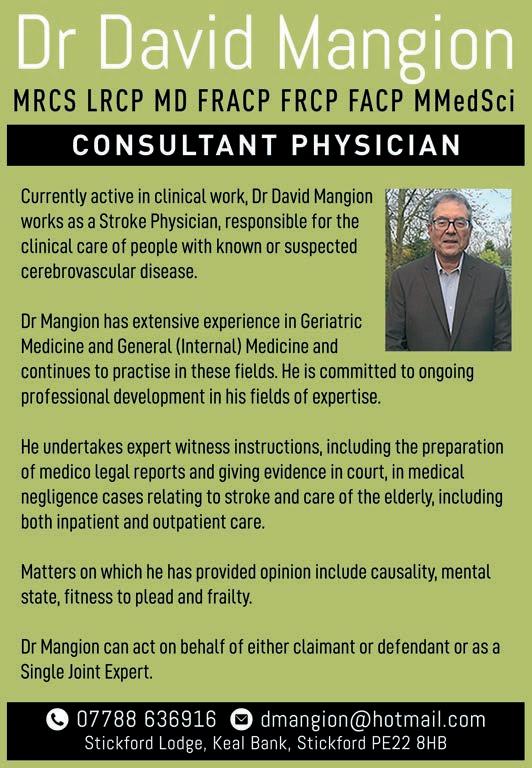

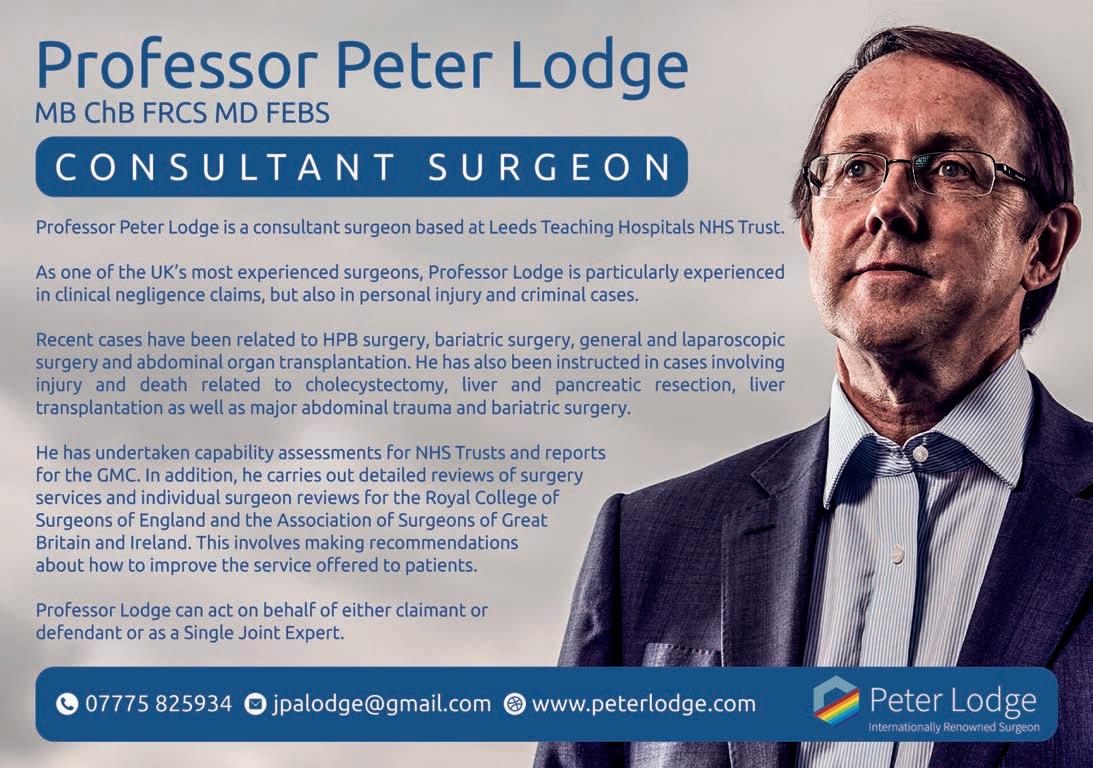
[A PRACTICE DIRECTION has been issued by the senior President of Tribunals that makes radical changes to the length of expert witness reports in SEND tribunals listed to take place after 15 July, Bond Solon has reported.
It applies to hearing bundles prepared for special educational needs and disability appeals and for disability discrimination in schools claims.
Specifically, expert reports must include an executive summary of no more than two pages of A4, contain numbered paragraphs and not exceed 15 pages, including the executive summary. The report must not be more than three years old and be in a font size no smaller than 12 point.
Bond Solon warns that bundles that do not comply with the requirements may be rejected and may lead to hearings being vacated or in the non-compliant party being barred from participating further in the proceedings.

The report continues: “Speech and language therapy reports can be lengthy, and it may prove very challenging to reduce them to 15
pages; equally, it can be very difficult to reduce the overall report into a two-page executive summary.
“Given that this Practice Direction applies to all hearings that are listed to take place after 15 July, experts are advised to review their current reports and check the dates of any hearings in which their evidence will be used.
“If you have already submitted a report for a hearing after 15 July, the new restrictions apply and your report will need to be rewritten urgently, with all the accompanying implications for costs of rewriting and the time to do so.”
Bond Solon can work with groups of experts from the same discipline to identify how reports can be reduced in length and how to produce an effective, short executive summary, which does not risk losing the important parts of the expert’s opinion.
To discuss or book an in-house Excellence in Report Writing course, call 020 7549 2549 or email expertwitness@bondsolon.com q
[ A CORONER HAS REFERRED a hospital consultant to the General Medical Council (GMC) after the deaths of three patients.
Colorectal consultant Daniel McGrath ceased surgery shortly after operating on 52-year-old Lorraine Parker at Royal Berkshire Hospital in Reading in January 2024.
In a report on Mrs Parker’s death, Senior Berkshire Coroner Heidi Connor said she had raised concerns about the surgeon with the GMC. The hospital said Mr McGrath was still seeing outpatients, but had stopped surgical duties 10 months ago.
Mrs Parker, a childminder, died in March 2024 after a surgical join leaked and was not quickly diagnosed and managed, the inquest heard. Independent medical experts were critical of her aftercare rather than the surgery itself, the coroner said.
In a Prevention of Future Deaths Report, Ms Connor said: “Lorraine Parker’s death was
the third in three months following surgery by the same consultant colorectal surgeon.”
She said one of Mr McGrath's previous patients, Michael Edwards, died in December 2023 following a ‘significant surgical error’ when a healthy part of his bowel was removed instead of a cancerous area. However, an internal hospital review rated his care as either ‘good’ or ‘excellent’.
In Mrs Parker’s case, the hospital found ‘no learning points’, she added.
A third patient died in March 2024, Ms Connor said.
In 2024, Mr McGrath was ordered to pay £1.2m towards damages and costs following the death of his patient Simon Healey at Berkshire Independent Hospital in Reading.
Ms Connor told Mrs Parker’s inquest: “There has been throughout little acceptance of any of the issues and criticisms raised by different independent experts. I am concerned about the risk of

future deaths should Mr McGrath continue to operate here or elsewhere.”
Ms Connor said the surgeon’s case was her first ever referral to the GMC. She added: “It appears that the option to return to operating remains open for Mr McGrath, even after a GMC notification by the trust with certain caveats and requirements in place before he may do so.”
A spokesperson for the Royal Berkshire NHS Foundation Trust said: “The trust extends our sincerest condolences to Ms Parker’s family. The consultant ceased surgical duties 10 months ago and we have worked closely with the Coroner and the GMC to provide them with assurance about measures put in place to oversee his work which has been restricted to outpatient work.
“We continue to monitor this arrangement and will implement any further recommendations made following this inquest.” q
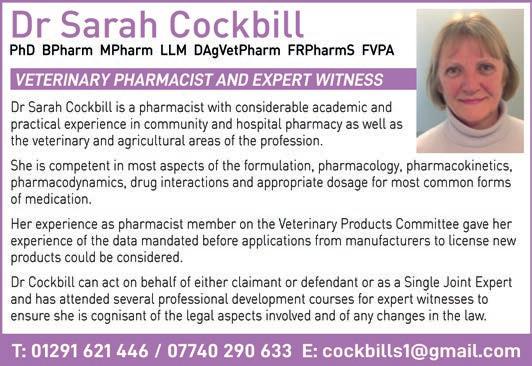
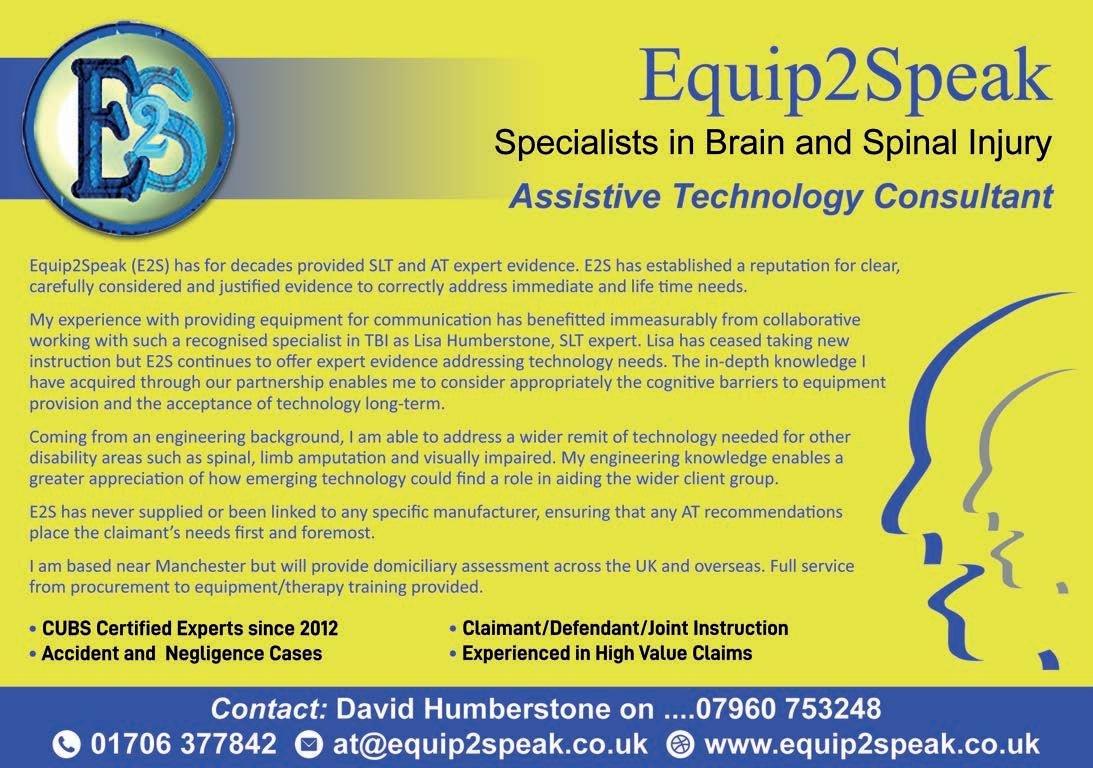

[ ALL NEW PATIENTS registering at GP practices are to be asked if they had a blood transfusion before 1996, as part of an NHS drive to find undiagnosed patients affected by the contaminated blood scandal. Each year, around 400,000 people born before 1996 – around half of new sign-ups online – will now be asked if they received a historic blood transfusion, with those who did then being offered a test for hepatitis C.
Patients will be able to order discreet, self-testing hepatitis C kits to complete at home, involving an easy finger prick blood sample which is then posted to a lab for analysis: or they can also access testing at GP surgeries, sexual health clinics and other services.
Hepatitis C is a virus that can infect the liver and, if left untreated, can sometimes cause serious and potentially lifethreatening liver damage over many years. It often does not have any noticeable symptoms until the liver has already been significantly damaged, meaning many people have the infection without realising it.
Once diagnosed, hepatitis C can be treated successfully by taking direct-acting antivirals for several weeks, curing more than nine out of 10 patients with hepatitis C.
The new questions are due to be introduced in the online GP registration service from 16 June and follows a recommendation by Sir Brian Langstaff in the Infected Blood Inquiry report, published in May 2024.
Professor Sir Stephen Powis, NHS national medical director, said: “The failures of the contaminated blood scandal have had a horrifying impact for patients and their families for decades, and I would like to reiterate our deepest apologies for the role the health service played in the suffering and loss for so many.
“The NHS is dedicated to implementing the inquiry’s recommendations and this simple change to the GP registration process for patients is a vital step forward in ensuring that nobody affected by contaminated blood is living undiagnosed and unsupported.
“By routinely checking their risk when anyone signs up to a new GP, and offering fast hepatitis C tests where necessary, we will ensure any undiagnosed cases can be found and treated as quickly as possible, while enabling thousands more to receive the reassurance of a negative test.”
NHS England has issued new guidance to GPs on introducing the questions, capturing responses and supporting patients where a blood transfusion and infection risk is indicated.
Only newly registered patients born on or before 31 December 1995 will be asked if they have had a blood transfusion. The new questions remind patients of likely reasons they may have had a blood transfusion, including after an accident, complication during childbirth, surgery or other medical treatment.
Health Minister Ashley Dalton said: “The Infected Blood Scandal is one of the gravest injustices this country has ever seen. The government has been clear nothing of this nature can ever happen again, and we must take tangible action.
“This initiative will see patients asked about their history and given access to the tests they need if they are at risk of hepatitis C, in line with the recommendations of Sir Brian Langstaff.”
Rachel Halford, CEO of Hepatitis C Trust, added: “This is a very welcome and important step. Every two weeks we hear from someone infected with hepatitis C through a transfusion who is only now finding out. All of these people have had hepatitis C for more than three decades: some are very ill.
“A more pro-active approach is critical to reaching and diagnosing those who remain unaware of their infection. Thanks to the brilliant

advancements in treatment, hepatitis C can be quickly cured through a short course of tablets.
“We strongly encourage anyone who had a blood transfusion before 1996 to get tested – they can order a test through the online NHS portal, and if they have any worries or concerns before or after a test, to contact our helpline.”
Anyone living in England over the age of 18 can order a free home test for hepatitis C from hepctest.nhs.uk q

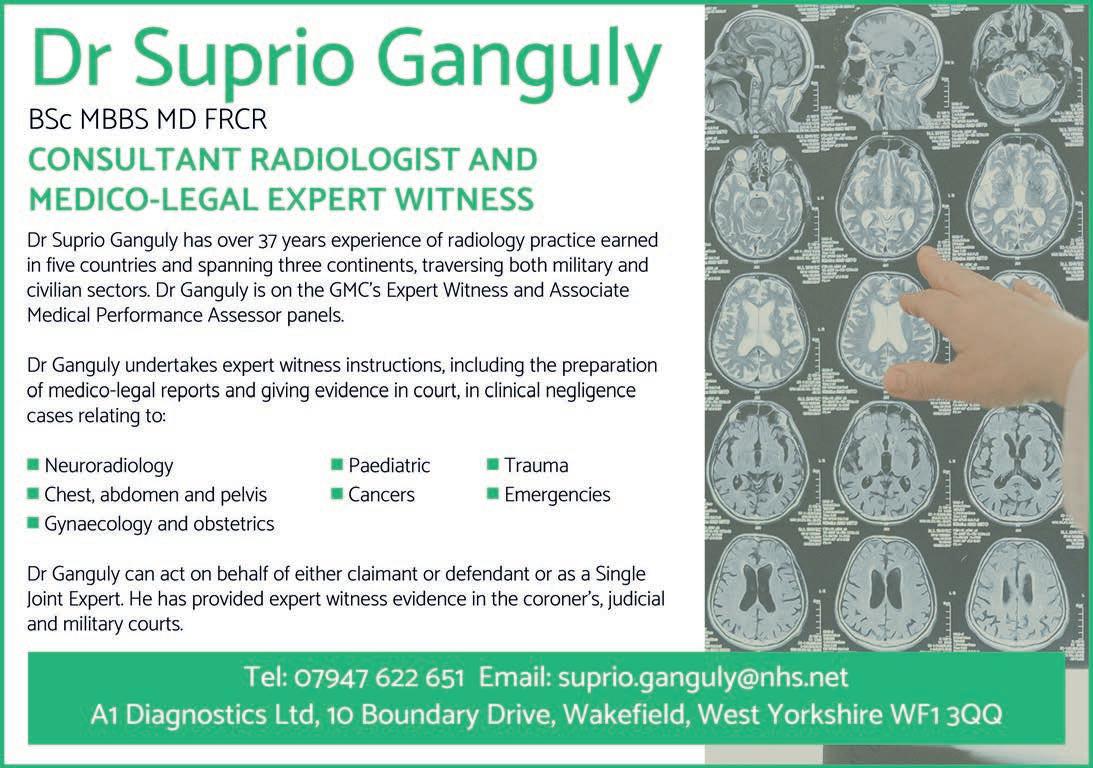
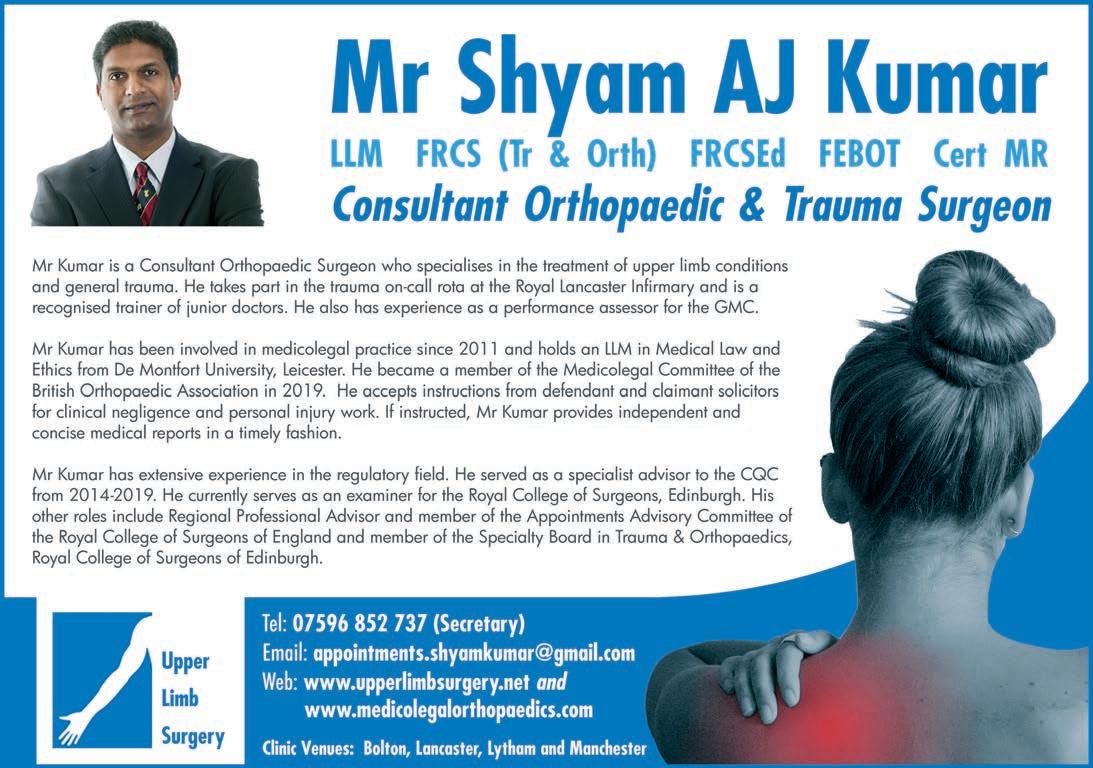
[THE Faculty of Intensive Care Medicine (FICM) has published a new ICM Training Quality Report: an evolution of its previous Quality Reports, which includes results obtained from the most recent FICM Intensivists in
[
FATIGUE amongst NHS healthcare staff poses a significant yet under-recognised risk to patient safety, according to the latest investigation report from the Health Services Safety Investigations Body (HSSIB).
The report examines the impact of staff fatigue in healthcare on patient safety. It found that, despite some data from surveys and staff anecdotes on exhaustion and fatigue, there is still little evidence available to help understand the size and scale of the problem, the scale of its impact on patient safety and those staff who are at most at risk from fatigue. The healthcare sector lacks robust systems to monitor and manage this issue, even as demands on the NHS workforce become more challenging and intense.
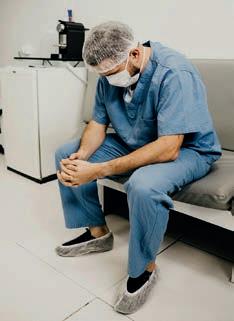
Drawing on interviews, site visits, national data and expert insight, the investigation found that staff fatigue contributes directly and indirectly to patient harm. Yet fatigue is not routinely captured or considered in patient safety event reporting or learning reviews.
According to the HSSIB: “Our report highlights that fatigue in healthcare is often misunderstood: viewed primarily as a wellbeing concern rather than a critical patient or staff safety risk. Although individual actions by staff can help to mitigate fatigue, this narrow perception leads to fatigue being treated only as an individual issue, with limited organisational accountability. The report highlights how this misunderstanding can create a culture of blame.”
Staff shared concerns about speaking up when fatigue may have contributed to patient safety incidents, fearing disciplinary action from their employers or professional bodies. That culture discourages transparency and hampers opportunities for system-wide learning and improvement, the report says.
The report was welcomed by representative bodies, including the Association of Anaesthetists, who said in a statement: “These findings are powerful; but they’re not new to us. Our Fight Fatigue campaign has worked to raise awareness around the dangerous culture of fatigue within the NHS for some time. In our survey of over 2,150 anaesthetists, nearly 75% said fatigue had harmed their physical or mental health. A staggering 84% had felt too tired to drive safely after a night shift and 57% had experienced a near miss or accident.
“Fatigue is not just an individual issue: it’s a systemic challenge that requires meaningful, structural change. The HSSIB’s report is a significant step forward in recognising this, and we strongly urge the Department of Health and Social Care to implement the report’s recommendations without delay.” q
Training (IiT) and ICM Regional Advisors (RA) surveys to capture a broad picture of intensive care medicine training in the UK.
The IiT survey was designed and led by the FICM Training, Assessment and Quality Committee, with considerable input from the FICM Intensivist in Training Lead Representatives. The survey incorporated questions around issues raised in the December 2023 StR Survey Report – both to gain greater insight into experiences in training and keep track of those important matters, but also to keep the number of surveys IiTs are asked to complete to a minimum.
The faculty said: “The IiT survey has explored some difficult and provocative areas as openness and transparency are key to progress. The report includes a programme of action points that the faculty committees will implement to address each identified priority, along with a summary of work that has been undertaken since the previous surveys were conducted.
“We are pleased to note that, whilst there are areas where action and improvement are needed, most Intensivists in Training report that their overall training experience has been positive, which is a real testament to the hard work of our educators in the current NHS climate. Feedback is invaluable, and we are committed to continually improving the ICM training experience for all. Thank you for your dedication and resilience.
“We are very grateful to all those who took the time to complete the surveys in such detail and wish to thank those involved in its creation and subsequent data analysis. We recognise that for some of you sharing your experiences in this way may have been difficult, and every effort has been made to ensure anonymity.” q
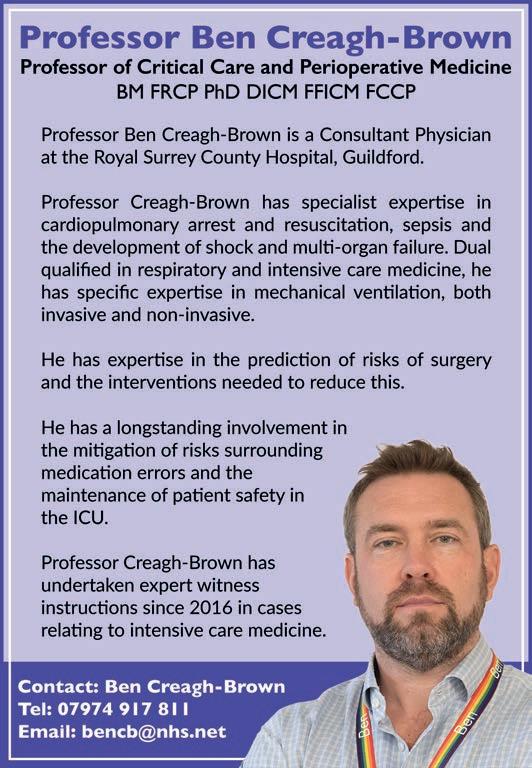
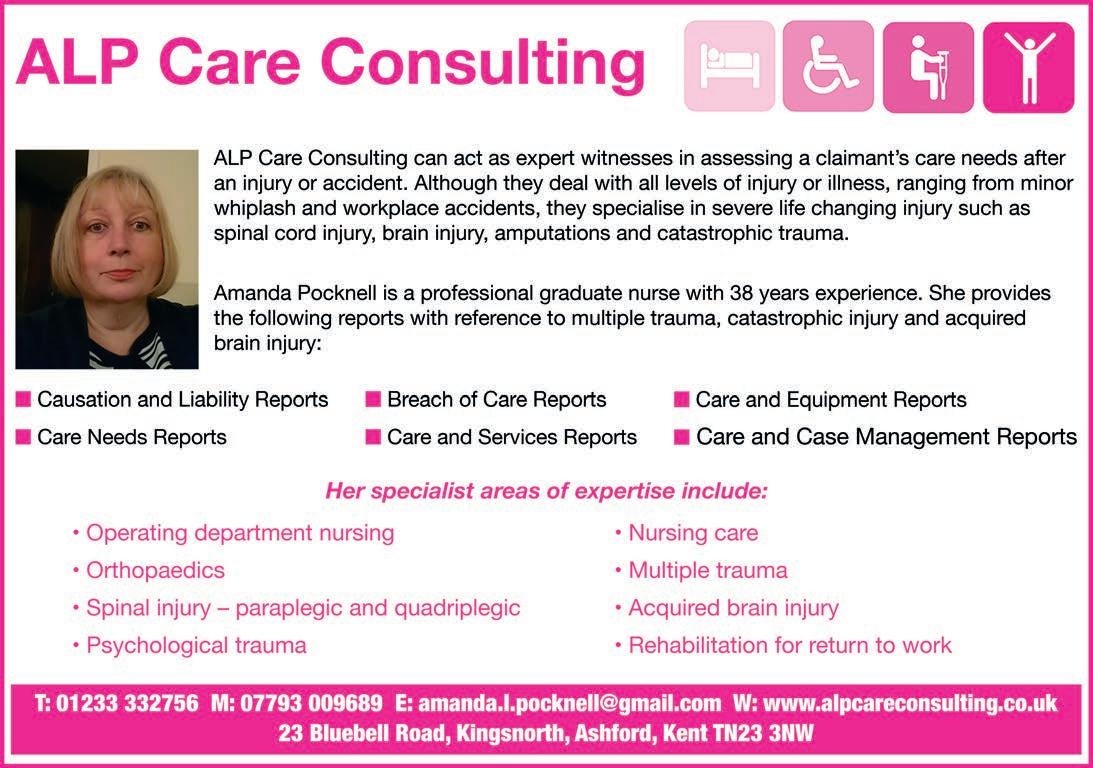
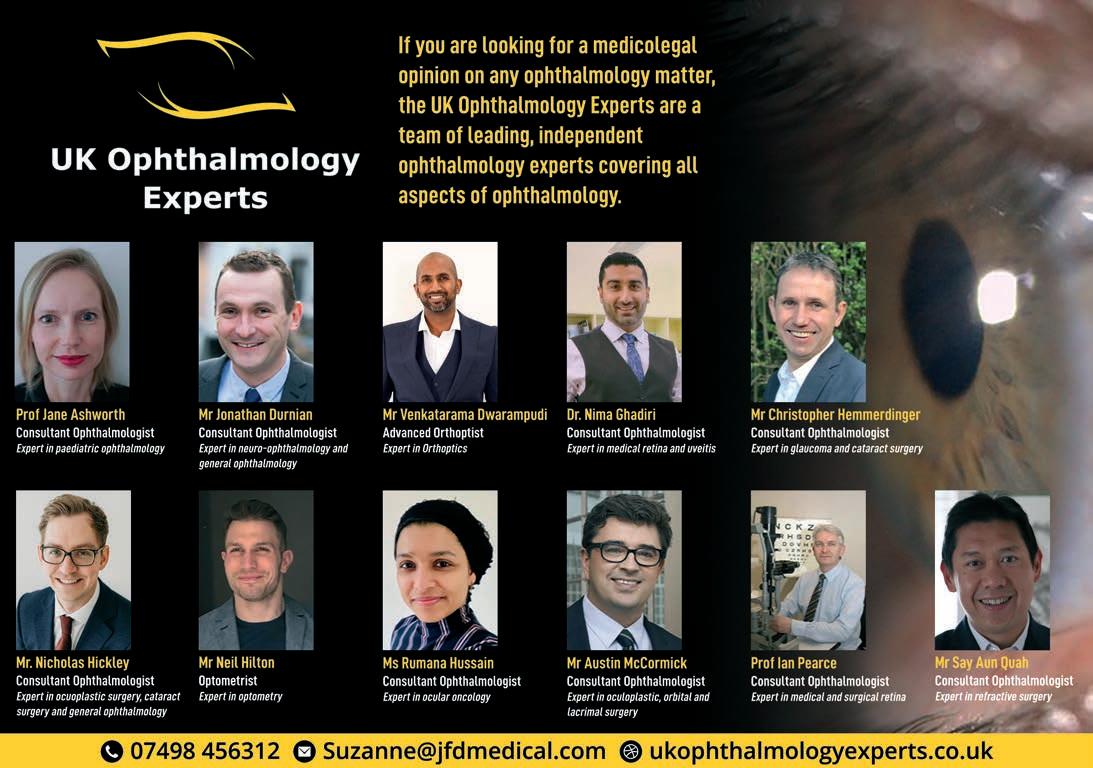
[TRAUMATIC INJURY often results in people living with disability and a reduced quality of life. An essential part of good trauma care is to maximise access to rehabilitation to assist physical and psychological recovery after injury.
In its introduction to the guidance document Identification and assessment of rehabilitation needs after traumatic injury, NICE says: “A proportion of people will have complex needs necessitating in-patient rehabilitation from a multidisciplinary team with expertise. Some people will need on-going support, rehabilitation and re-enablement once they are discharged home.
“People in major trauma centres with an injury severity score of 9 or more, should be assessed by a consultant in rehabilitation medicine within
[A NEW PLAN aimed at improving emergency care in England has been described as both ‘good and bad’ by the Royal College of Emergency Medicine (RCEM).
The Urgent and Emergency Care Plan 2025/26 was published on 6 June by NHS England (NHSE) and the Department of Health and Social Care (DHSC). It contains a range of pledges and ambitions aimed at avoiding another winter A&E crisis – which last year saw socalled ‘corridor care’ become endemic and clinicians battling a ‘quaddemic’ of viruses.
The new plan includes a commitment to publish A&E performance data from each individual hospital in England, which is something RCEM has been pushing for, and which has been welcomed by the college. However, RCEM has concerns about the lack of a cast-iron commitment to ending dangerous and demeaning 12-hour waits in emergency departments.
The plan includes pledges to:
• Reduce the number of patients exposed to Emergency Department
• waits of 12 hours to less than 10%.
• Improve the issue of delayed discharges – where people remain in
• hospital despite being well enough to leave, which is often caused
• by the lack of adequate social care.
• Reduce all ambulance handovers to less than 45 minutes.
• Maintain the four-hour standard – which states that every person
• who goes to A&E should be treated, discharged or admitted
• withing four hours – at 78%.
• Increase the number of NHSE staff vaccinations to help protect
• patients.
• Measure and reduce so called ‘corridor care’.
It also details that almost £450m will be made available to support the expansion of Same Day Emergency and Urgent Treatment Centres, to expand the provision of Mental Health Crisis Assessment Centres and specialist mental health in-patient bed numbers, as well as providing around 500 new ambulances by March next year.
Responding, RCEM president Dr Adrian Boyle said: “There is some good and some bad – but we wholeheartedly welcome the commitment to publish A&E performance data for each and every hospital, and we thank NHSE and DHSC for heeding our recommendation.
“It will provide a true picture of the pressures and challenges being faced and will prevent any potential ‘muddying of the waters’, which can happen when only trust-level information is provided. As this data is already available, we urge NHSE to start publishing it as soon as possible.
“However, some parts lack ambition: for example, accepting that 10% of people will face A&E waits of more than 12 hours, when no patient should; also, maintaining the four-hour standard at 78% when the stated aim is that 95% of patients should move through the ED within this time: something which hasn’t happened for a decade.” q
three calendar days and have a rehabilitation prescription formulated. The specialist team, including nurses, should complete their assessment and recommendations for early phase rehabilitation.
“The rehabilitation prescription is used to document the rehabilitation needs of patients and identify how their needs should be addressed. It should describe physical, functional, vocational, educational, cognitive, psychological and social rehabilitation needs of a patient.
“The prescription was designed an extension of a discharge/transfer summary and should include on-going health and social care plans so that everyone is working from one document, which is regularly reviewed and updated.”
Where the injury is the result of negligence or fault and there is likely to be a claim for the funding of the on-going rehabilitation and care, the Rehabilitation Code 2015 comes into play.
Published by a joint Rehabilitation Working Party of the International Underwriting Association and the Association of British Insurers, the code provides a framework in which insurers and claimant lawyers can collaborate to consider the health needs of injured people. Although voluntary, it is attached to the Pre-Action Protocol that explains the conduct and steps expected of claimants, defendants and their respective representatives before commencing legal proceedings for personal injury claims. Research has consistently shown it to be well established and widely used by claims handlers, personal injury lawyers and providers of rehabilitation services.
Matthew Scott, chair of ABI’s Personal Injury Committee, said at the time of the code’s publication: “Rehabilitation can play a crucial part in helping people recover from injuries, and the Rehabilitation Code plays an important role of ensuring those patients get the right treatment as speedily as possible. Those who are unfortunate enough to be hurt in an accident deserve quality care that puts their interests first, and insurers are committed to playing their part in providing that.” q

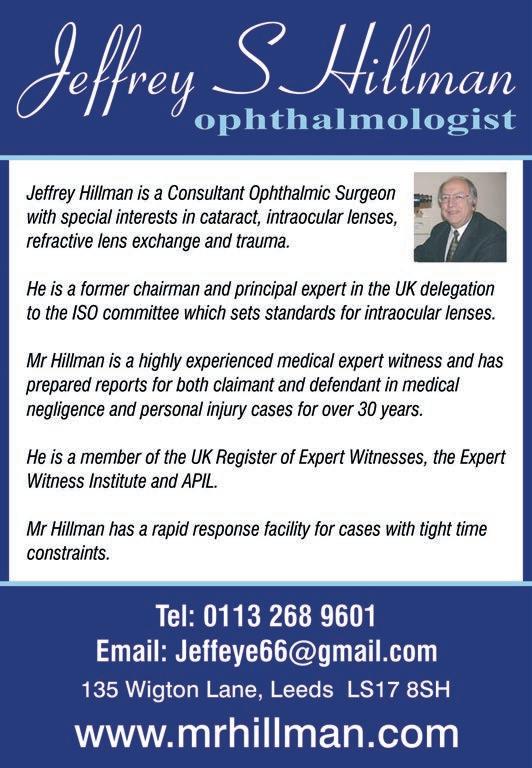

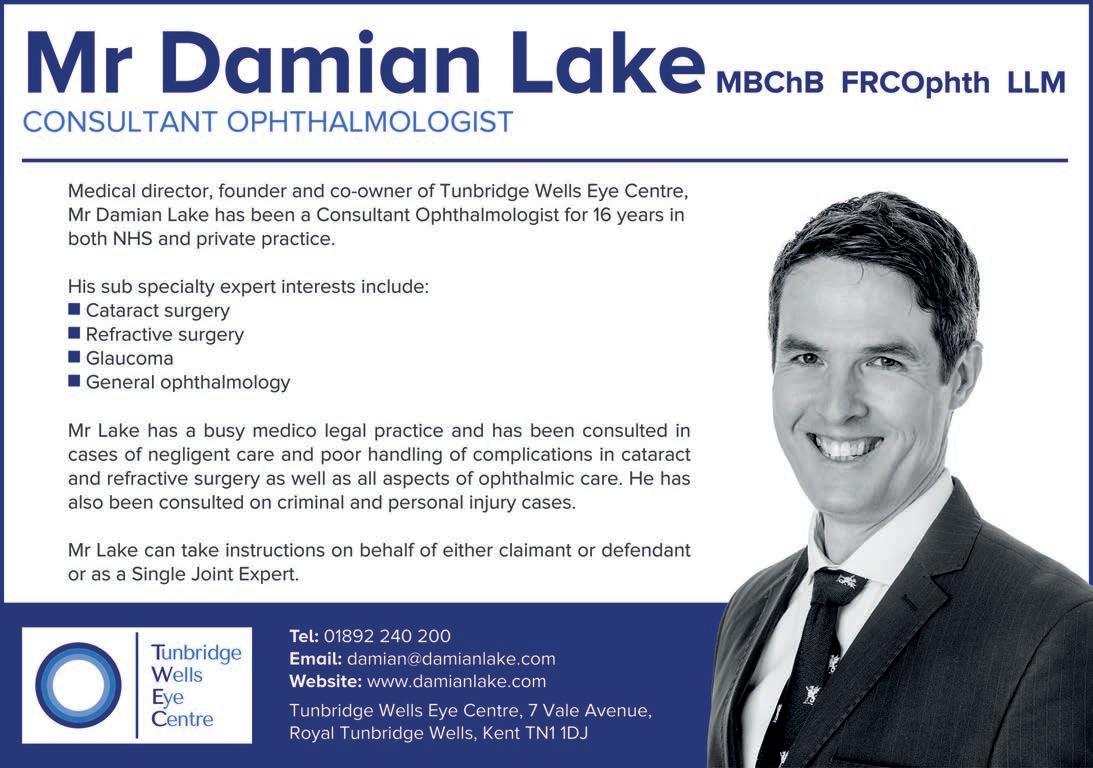
[ IN AN OPEN LETTER to Health Minister Stephen Kinnock MP, the Royal College of Ophthalmologists has called for a review into the use and oversight of independent sector providers in NHS-funded cataract surgery, given the worrying issues around patient safety and value for money raised by a recent Sunday Times investigation.
In a statement the college said: “We believe such a review must address issues including non-contracted activity, potential upcoding practices and payments in referral pathways. Equally, patient safety must be central –particularly in relation to the management of post-operative complications.”
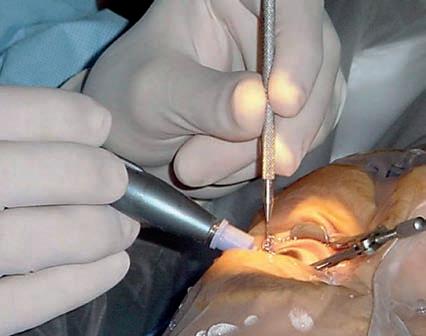
The letter also highlights the fact that investing in NHS ophthalmology is paramount to ensure we have comprehensive sustainable eye care services into the future. That includes the workforce, clinic and theatre space and IT infrastructure.
The Centre for Health and the Public Interest (CHPI) found that five major cataract surgery firms made £169m from delivering NHS services in 2023/24, with a profit margin of 32%. That indicates that approximately one in every three pounds the NHS pays is lost to profit. Additionally, CHPI flagged conflicts of interest among NHS consultants who have shares in private cataract firms.
The CHPI also quotes a leaked Department of Health and Social Care (DHSC) briefing highlighting a lack of minimum standards for commissioning and contracting, leading to variable quality in care. The briefing also noted that 235,000 patients attended follow-up appointments described as ‘unnecessary,’ costing almost £16m.
AWH Solicitors have revealed that a number of the providers are currently under NHS England investigation, after they received reports of severe complications after operating. Issues include infections, retinal detachments and cases of permanent vision loss. Those incidents have led to UK-wide scrutiny into private clinics delivering NHS cataract surgeries. The Department of Health and Social Care has announced investigations into private clinics after concerns were raised about their financial practices, post-surgery care and patient safety.
The letter from the RCOphth, over the signature of its president Professor Ben Burton, states: “Following the very worrying issues around patient safety and value for money raised by the recent Sunday Times investigation, I am writing to urge the Department of Health and Social Care to initiate a review into the current use and oversight of
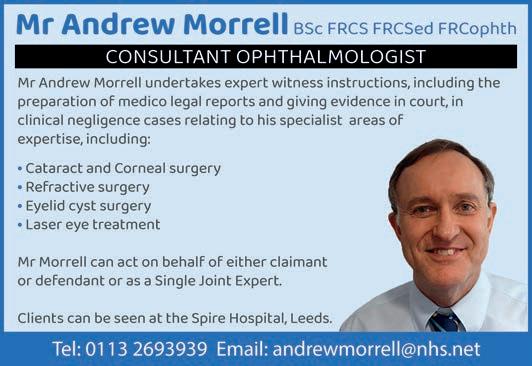
independent sector providers (ISPs) in NHS-funded cataract surgery.
“The college has for some time expressed deep concern about the unintended consequences of moving the majority of NHS cataract surgery to ISPs. These concerns appear to be shared by your officials too; as reported by the Sunday Times, a leaked ministerial briefing note stated that ‘NHS England have concerns covering value for money, unnecessary operations, impacts on workforce and training, poor follow-ups and patient safety’.
“Recent research shows that between 2018/19 and 2022/23 NHS spending on ISPs delivering cataract surgery increased by at least 380% to £282m annually and the overall proportion of the NHS ophthalmology budget spent on cataracts jumped from 27% to 36%. This shift has led to funding, workforce and infrastructure being diverted here at the expense of resourcing for conditions such as glaucoma and age-related macular degeneration that can cause irreversible sight loss if not treated swiftly.
“Concerningly, 67% of ophthalmology clinical leads feel that independent sector provision has had a negative impact on patient care, and commissioners have told us they are unable to properly control their cataract spend and, therefore, effectively resource services that can prevent irreversible sight loss. This is backed up by recent research that found in 2021/2022 14% of ISP-delivered cataract surgery was on a non-contracted basis – rising to 25% in seven integrated care boards.
“This question of value for money and making the best use of scarce resources is paramount. A review must address issues including noncontracted activity, potential upcoding practices, and payments in referral pathways. Equally, patient safety must be central – particularly in relation to the management of post-operative complications.
“To ensure we have comprehensive, sustainable eye care services into the future, we must invest in NHS ophthalmology – its workforce, training, estate and infrastructure. We hope that the forthcoming 10 Year Plan and Long Term Workforce Plan refresh will reflect these priorities.
“I look forward to working with you and all stakeholders in the eye care sector to address the challenges relating to independent sector provision of NHS-funded cataract surgery to ensure we do all we can to prevent avoidable irreversible sight loss.” q

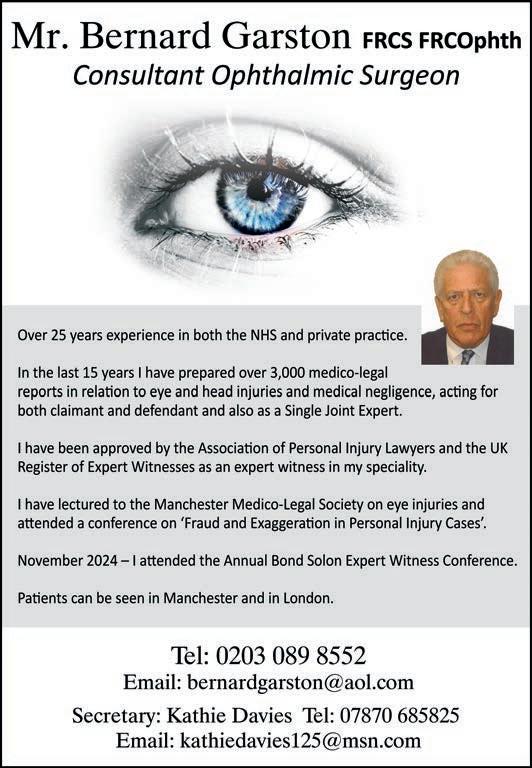
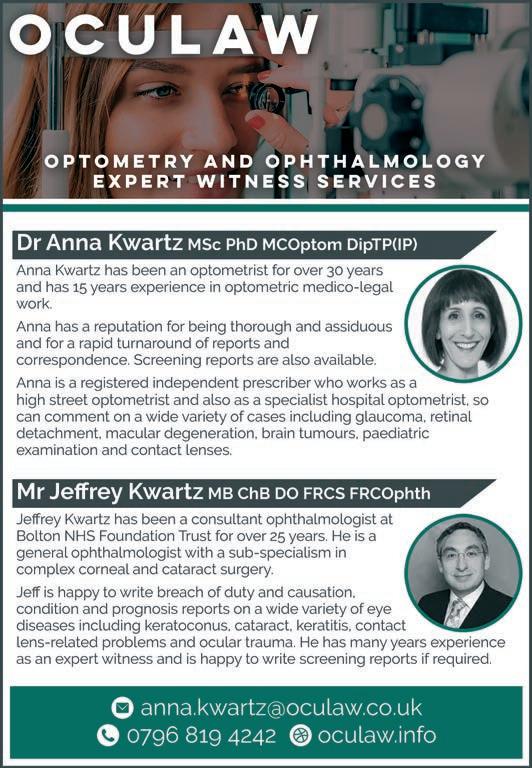
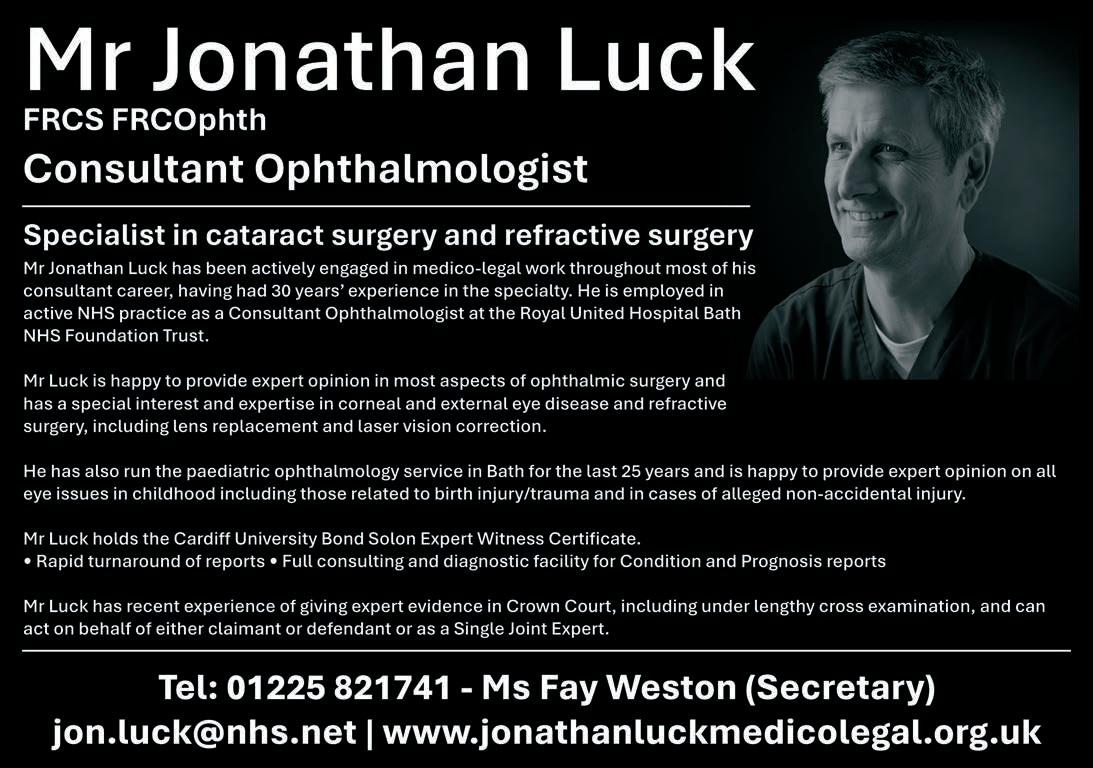
[
ON 1 APRIL the General Optical Council (GOC) published its corporate strategy for 2025-2030. It sets out a new vision for safe and effective eyecare for all, and a new mission to protect the public by upholding high standards in eye care services.
The strategy builds on the GOC’s strong foundation as a high-performing regulator and focuses on three key strategic objectives:
• Creating fairer and more inclusive eye care services by addressing
• inequalities in access to eye care and supporting a diverse and
• inclusive workforce. That includes using research and data to highlight
• inequalities facing the public, patients and professionals, using its
• regulatory levers to help reduce barriers to people – especially those
• with vulnerabilities – accessing services and tackling negative working
• environments.
• Supporting responsible innovation and protecting the public by
• supporting registrants to adapt to technological advancements and
• workforce changes while maintaining high standards of patient care.
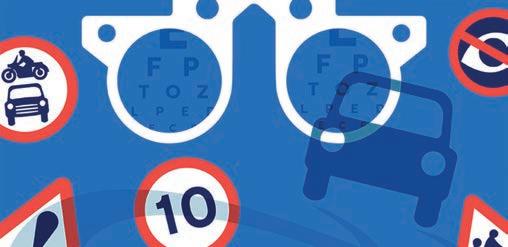
[THE COLLEGE OF OPTOMETRISTS and the Association of Optometrists (AOP) have written to the Secretary of State for Transport, Heidi Alexander, calling for mandatory vision checks for drivers at first licence application and at every renewal. The move follows an inquest into the deaths of four people killed by drivers with failing eye sight.
HM Senior Coroner for Lancashire, Dr James Adeley, sent a Prevention of Future Death Report to the Secretary of State, warning that enforcement of visual legal standards for motorists is ‘ineffective and unsafe’. Both the AOP and The College of Optometrists gave expert evidence at the inquest.
In comments to the Transport Committee about the Coroner’s conclusions, Ms Alexander made a commitment to consider changes to vision standards for drivers. Welcoming Ms Alexander’s remarks, in the joint letter the Association of Optometrists and The College of Optometrists state: “We strongly believe that vision-related accidents are preventable with simple, evidence-based legislative changes. The UK’s approach is out of step with best practice internationally and the current vision standards mean UK drivers do not undergo an objective measure of vision and assessment of eye health.
“With over 7,000 optometry practices nationwide, optometrists are well placed to support the delivery of these checks swiftly and effectively. Lives can and must be saved by ensuring no driver with unsafe vision remains on the road unchecked.”
To make UK roads safer, both organisations are calling for mandatory vision checks that take place at first licence application and at every renewal: every 10 years for most drivers and every three years for those over 70. Further information is available from the Association of Optometrists’ Don’t swerve a sight test campaign pages, alongside guidance and evidence on The College of Optometrists’ website. q
• That will include: taking a more strategic approach to post
• registration qualifications, reforming its CPD system so that it
• focuses on the quality rather than quantity of activity and supports
• the expanded clinical roles of registrants, and extending regulation
• to all businesses carrying out restricted activities.
• Preventing harm through agile regulation by ensuring public and
• patient voices are at the heart of decision-making. That will
• include: investing more in research activities, engaging better with
• patient groups and strengthening the user voice in its decision
• making structures; shifting to a more anticipatory model of
• regulation that seeks to prevent harm based on a risk-based,
• data-driven approach that joins up intelligence and insight;
• supporting workforce planning and patient choice by collecting
• better data about registrants and improving how it publishes and
• shares it with others; changing its governance arrangements and
• other internal processes in response to anticipated legislative reform.
GOC chief executive and registrar Leonie Milliner said: “This new strategy sets some ambitious goals for ensuring safe and effective eye care for all. By fostering collaboration, embracing innovation and enhancing our regulatory approach, we aim to improve outcomes for both patients and professionals.
“While the focus of this strategy is on areas of change, we are also committed to continuous improvement across our core statutory functions, such as maintaining the registers, approving qualifications and managing our fitness-to-practise operations.
“We recognise we are one of many stakeholders in a wider landscape of professionals and organisations working to improve eye care in all four nations of the United Kingdom for the benefit of patients and serviceusers. We look forward to continuing to work collaboratively with partners across the sector to protect the public and uphold high standards in eye care services.” q
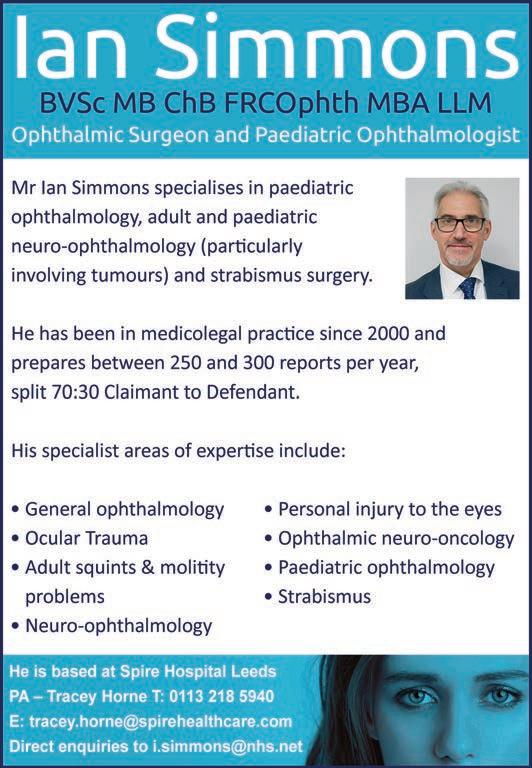



By Mr Zaid Sadiq, consultant oral and maxillofacial surgeon
[
OTHER THAN IN an emergency situation, informed consent must be obtained from all patients before any surgical procedure can be performed. Ideally, informed consent is provided by the patient under optimal conditions, without any coercion or time pressure. In reality that is often not the case, and the consent process is impacted by many factors.
However, failure to obtain proper consent is a common cause of litigation. In this article I will consider general aspects of informed consent and then pose some scenarios related specifically to dentoalveolar surgery: a specialised area of oral and maxillofacial surgery that focuses on treating conditions affecting the teeth, jawbone and surrounding soft tissue. Given that the number of dentoalveolar surgical procedures is rising, a lack of proper informed consent being obtained from patients is likely to become an increasingly common issue.
There is no standardised procedure for obtaining patient consent in the UK. Usually, the surgeon and patient meet to discuss the proposed procedure and its associated risks. The patient is provided with information about the nature of the proposed surgery, the expected benefits, material risks and possible complications, alternative treatment options and the consequences of choosing not to have the surgery. The discussion is then documented in writing and signed by both parties.

Unfortunately, when questioned later, it is clear that many patients either do not fully understand the risks involved or have forgotten them. That is not entirely surprising, given that many patients may feel anxious about the impending procedure and it may affect their ability to take in and recall information. Furthermore, the patient’s illness or injury may also affect their understanding, particularly if they are in severe pain or under a degree of sedation. Language may also be a barrier, and the patient may ultimately receive only a fraction of the information being discussed if adequate translation facilities are not available.
Documentation in the form of a brochure explaining the proposed procedure and its associated risks may allow the patient to assimilate the pertinent information in a quieter, less stressful environment, or in the patient’s native language – thus aiding understanding. However, documentation is not a substitute for a proper discussion between surgeon and patient, and it has been demonstrated that allowing extra time for the consent process has a bigger impact on patient understanding than multimedia approaches to information delivery.
For any surgical procedure there are hundreds of conceivable risks, and it is not possible to discuss all of them during the average consent consultation. While it is essential that all material risks are included in discussions with the patient and on the consent form, it is not always clear what constitutes a material risk. Generally, they are deemed to be those risks that would be regarded as significant by a reasonable person in the patient’s position when deciding whether or not to undergo the recommended procedure. Therefore, it is particularly important to disclose risks that may lead to the patient refusing surgery, and patients should certainly be informed about all serious risks, even if they are unusual or only occur rarely.
The scope of the disclosure of material risks may need to be
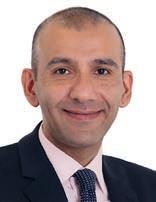
expanded in some patients, particularly those who are unfamiliar with medical procedures. Conversely, there is no obligation to disclose risks that are commonly understood, obvious or already known to the patient – although doing so may offer further protection from litigation. Furthermore, it is clearly vital that clinicians keep up to date with the literature regarding the risks associated with the proposed procedure and alternative treatments, so that the information given is correct. As well as the risks common to any surgical procedure, dentoalveolar surgery carries specific risks, such as nerve injury and damage to adjacent teeth. Surprisingly, those risks are frequently absent from informed consent forms. For example, the risk of restricted movement of the jaw following surgery was missed off over 95% of forms examined in a recent study. The development of a standardised list of risks for each procedure may reduce the incidence of such omissions in the future; however, that list should still be tailored to each individual patient.
Factors that need to be taken into account include work responsibilities, family circumstances, insurance coverage and religious beliefs. It is also important that the surgeon allows enough time for the consent discussion. Nowadays, there is a wealth of information available online and some patients may have many questions and want to engage in a lengthy and detailed discussion.
Occasionally, a surgeon will encounter an unexpected medical abnormality during the procedure, which requires treatment. However, it is not possible to seek informed consent from a patient under anaesthesia. For that reason, a good consent form should include a clause removing the need to seek additional informed consent for any unanticipated conditions that arise during surgery. In the event of the patient expressly indicating that they do not want information about the surgical procedure and its associated risks, that waiver must be clearly documented in writing, to protect the healthcare provider should a claim later arise.
There are several ways in which the consent process could be improved. Implementing those changes would benefit patients and ensure that they really are giving informed consent, rather than just consent to surgery. That would also benefit surgeons, as it would reduce the risk of litigation arising. q
• Mr Zaid Sadiq is a consultant oral and maxillofacial/head and neck surgeon and a highly-experienced expert witness. He is qualified in both medicine and dentistry and also holds a Cardiff University Bond Solon Expert Witness Certificate.
Mr Sadiq accepts instruction for both adult and paediatric cases in a range of areas, including skin cancer, oral and facial cancer, facial reconstruction and fractures, trauma surgery to the head and neck, oral surgery (dental extractions) and dental implants. He is available for medicolegal consultations on a weekly basis in Harley Street, London.
Find out more at https://www.medicolegal-partners.com/our-experts/ mr-zaid-sadiq/ or contact info@medicolegal-partners.com to discuss a case or to instruct Mr Sadiq


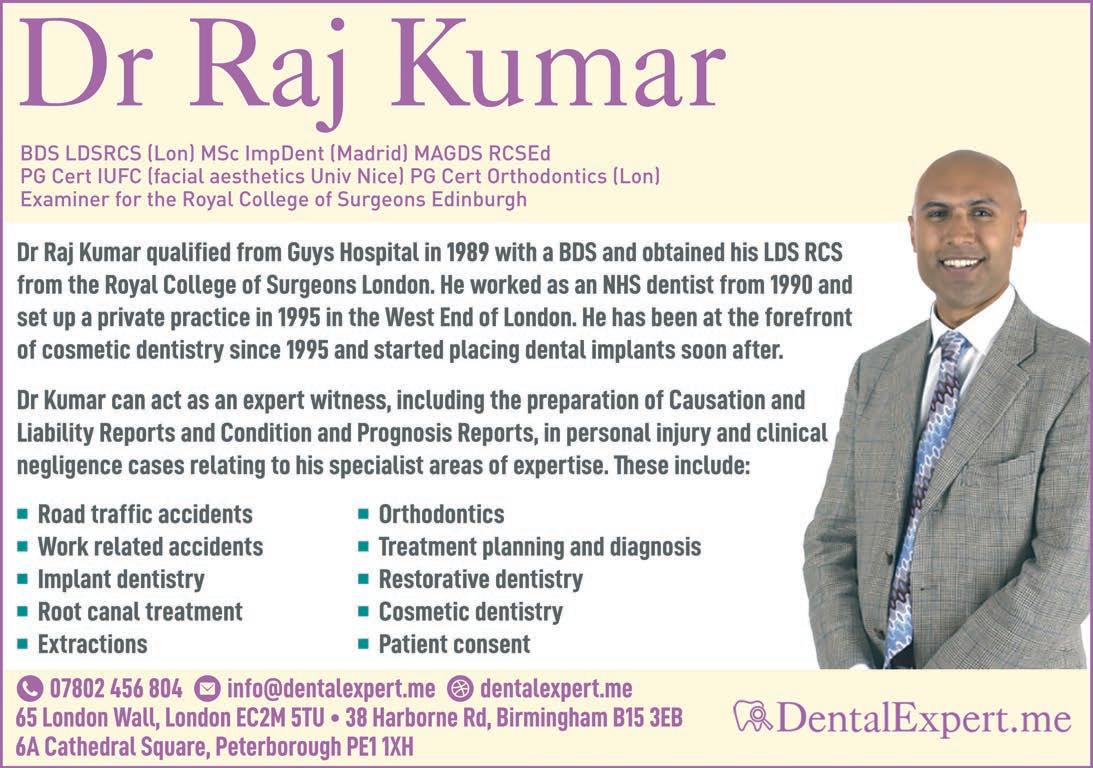
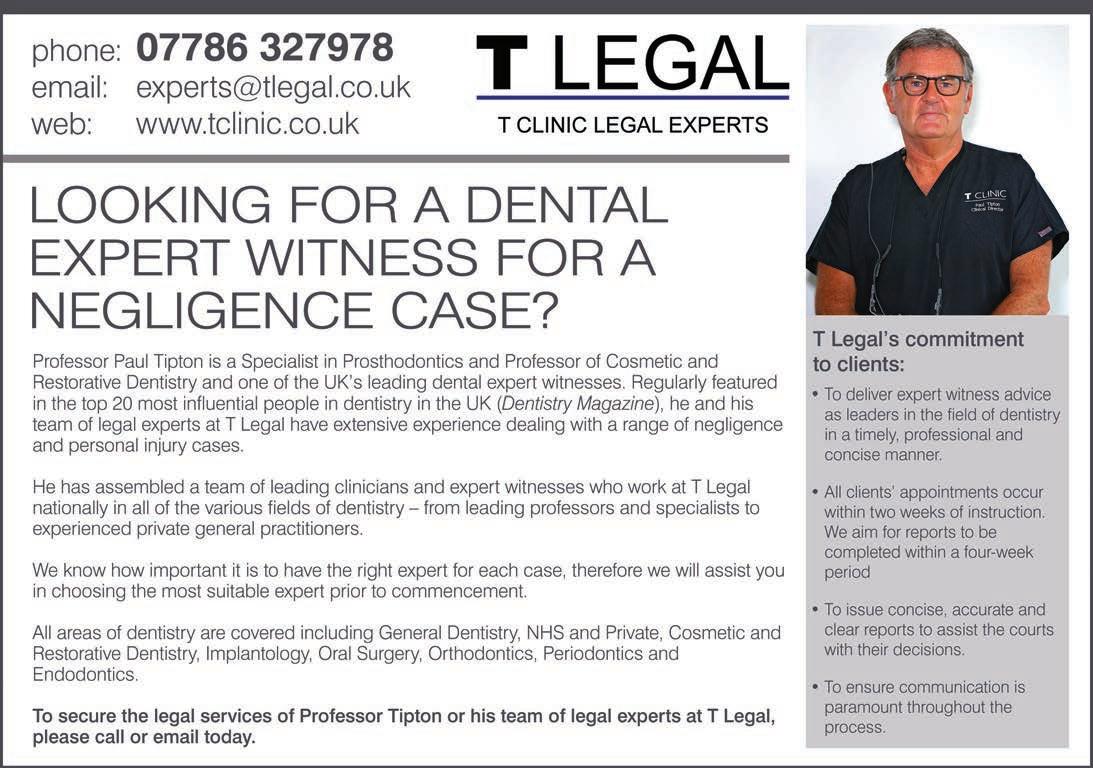
[ON 6 MAY the General Dental Council (GDC) published its Fitness to Practise (FtP) Statistical Report for 2024, which highlights that 18 dental professionals were removed from the register following Practice Committee hearings, representing just 0.01% of all registered dental professionals.
The report, which breaks down FtP cases by a range of equality, diversity and inclusion (EDI) characteristics, including ethnicity, shows that 1,401 new concerns were received during 2024, representing an 8% increase compared to the previous year. Of those concerns, 88% were resolved at assessment and case examiner stages, with only 12% progressing to a practice committee hearing.
In total 1,294 assessments were carried out during 2024: a 10% decrease from 2023, reflecting a reduced caseload in the area during the year. The number of Practice Committee initial hearings held also decreased by 18%: from 91 in 2023 to 73 in 2024.
The report shows meaningful improvements in case-handling efficiency, with 76% of cases meeting assessment timeframe targets in Q4 2024. Additional resources added to the case examiners’ team in the third quarter of 2024 are expected to clear the backlog of older cases by mid-2025.
Theresa Thorp, executive director of regulation at the GDC, commented: “Our annual statistical report provides insights into our fitness to practise processes and outcomes. The data helps us understand trends and patterns in concerns raised about
dental professionals, which in turn informs our regulatory approach.
“This year's report continues our commitment to transparency in presenting robust data that can benefit the wider dental sector. We're focused on using this data to help us identify any issues of discrimination, bias or racism in the reporting or referral of concerns to us.”
The report reveals that patients and members of the public remain the primary source of concerns, accounting for 61% of cases received: up from 59% in 2023. There has been a continued increase in referrals from dental professionals: rising to 9% in 2024 from 8% in 2023 and 6% in 2022.
Regional analysis shows that dental professionals practising in London and the South East were more likely to have fitness to practise concerns raised against them, accounting for 22% of concerns received despite representing only 14% of the register.
The report also highlights key demographic patterns:
• Male dentists were significantly more likely
• to have concerns raised than female
• dentists, making up 47% of registered
• dentists but accounting for 65% of
• concerns.
• Asian or Asian British dentists faced a
• disproportionately high number
• of concerns (34%) relative to their
• representation on the register (30%).
• Younger dental professionals were
• proportionately less likely to have
• concerns raised against them.
• Dentists aged 51-60 make up 18% of the
• register but account for 21% of FtP
• concerns.
• DCPs aged 31-40 represent 32% of DCP
• registrants but account for 38% of
• concerns in that group.
Around 94% of FtP cases are generated outside the GDC. The report shows an overrepresentation of dentists of an Asian/ Asian British ethnicity at the referral stage of the process. However, that shifts as they move through the process, so that the proportion of cases progressed throughout the FtP process, when measured by ethnic group, remains consistent at each point in the process.
“This,” the GDC says, “gives us confidence in our decision making. There is currently no evidence to suggest that our processes systematically exacerbate this bias; however, we will continue to monitor and review our processes.”
The report includes detailed timeframe analysis, showing that 54% of investigation stage cases were completed within six months in 2024, compared to 55% in 2023 and 47% in 2022.
EDI analysis is complex, and the information and data should not be considered in isolation when assessing correlation and causation as many other factors may be relevant, such as practice size, location or local population demographics.
The full Fitness to Practise Statistical Report for 2024 is available at www.gdc-uk.org q
[ LATEST RESEARCH from the British Dental Association (BDA) highlights the shocking amount of sugar in some baby food pouches, and the BDA is calling on the government to take action.
Appearing on the BBC’s Panorama programme, BDA chair Eddie Crouch highlighted how options marketed as ‘healthy’ are loaded with sugar, causing tooth decay. The BDA examined hundreds of the pouches – some aimed at infants just four months old – and found that many have more sugar than cola.

The BDA has therefore launched a petition to ‘Make sugar the new tobacco!’. The petition’s message to Health Secretary Wes Streeting is: “From tooth decay to type-2 diabetes, excessive sugar is fuelling preventable diseases with a multi-billion-pound price tag to our NHS.
“Voluntary action to try and encourage the food industry cut the dose has failed. So, we need mandatory policies that force them to do the right thing. To reformulate their food, to remove misleading
claims in their ads and on their packaging, to stop them peddling junk food to infants in the face of government guidance.
“The very same strategies that have been applied to tobacco need to be brought to bear on sugar. This isn’t about adding to the cost of living: it’s forcing the hand of Big Food.”
Eddie Crouch said: “If we look at a carbonated drink, which has about 15 grammes of sugar; we’ve got these pouches that are being advertised as healthy; they’ve got 4 grammes of sugar more than the can of drink, which is really quite shocking.
“It’s obviously not all down to these pouches; but clearly, regular use and feeding of these pouches, with such high levels of sugar, causes serious problems to the general health of children as they're growing up.”
Prevention is at the heart of the dental profession, the BDA says, so there needs to be real action on labelling, marketing and taxation. q

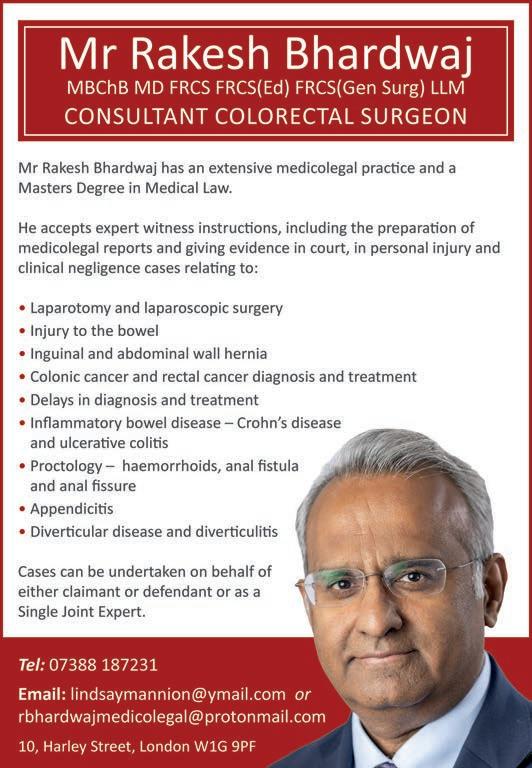
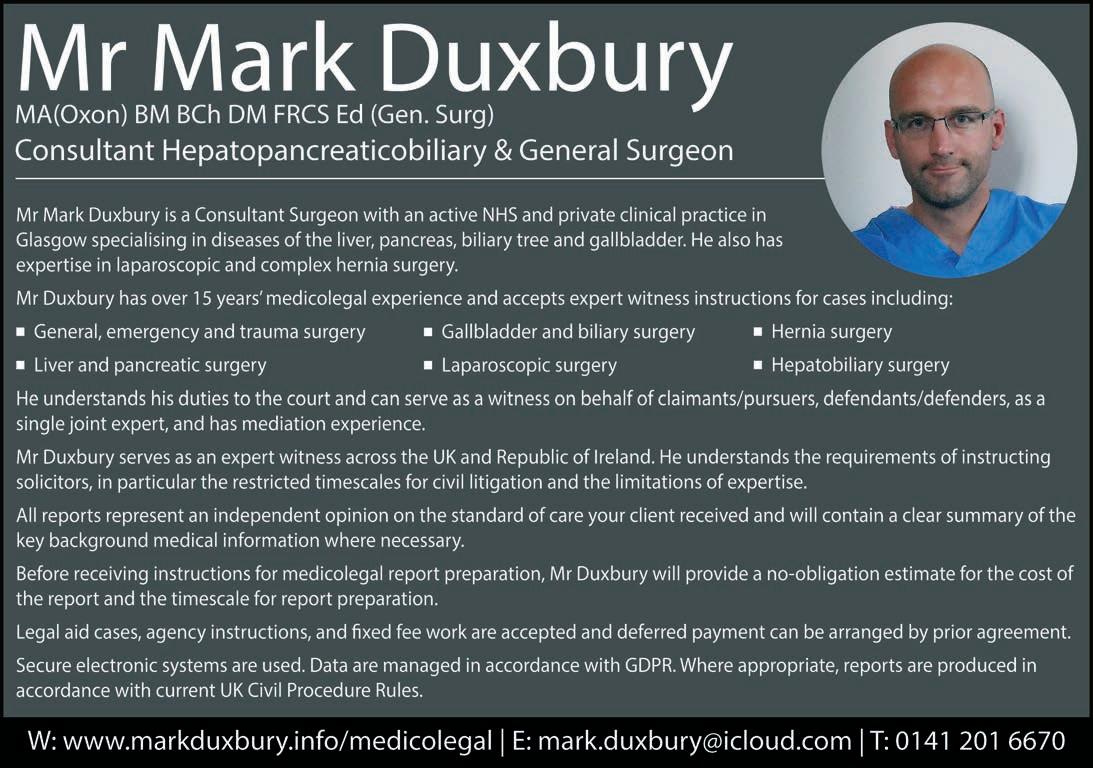
[INGUINAL HERNIA REPAIR is one of the most frequently performed surgical procedures worldwide and is generally considered safe and effective. Despite the high success rate, the operation is not without potential complications, some of which can be difficult and long-lasting. Those complications may arise due to technical factors during surgery, individual patient characteristics or reactions to surgical materials such as mesh.
According to NHS Inform: “An inguinal hernia usually occurs when fatty tissue or a part of your bowel, such as the intestine, pokes through into your groin at the top of your inner thigh. It pushes through a weak spot in the surrounding muscle wall (the abdominal wall) into an area called the inguinal canal.
“Inguinal hernias occur mainly in men. Most are thought to result from ageing, although they can occur at any age. This is because as you get older, the muscles surrounding your abdomen (tummy) can become weaker.”
One of the more challenging complications following hernia repair is chronic groin pain, often referred to as post-herniorrhaphy neuralgia. The condition may develop when nerves such as the ilioinguinal, iliohypogastric or genitofemoral nerves are damaged, entrapped or irritated during or after the procedure. This pain can be persistent and debilitating, sometimes requiring long-term management with medication, nerve blocks or, in rare cases, further surgical intervention.
Another recognised issue is the recurrence of the hernia. Although modern surgical techniques and the use of mesh have significantly reduced recurrence rates, it remains a possibility. Recurrence may occur if the repair was under tension, if the mesh did not integrate well, or if the patient had risk factors such as obesity or chronic coughing which place stress on the repair site.
Infections, although relatively uncommon, can be particularly concerning when they involve the mesh used to reinforce the repair. A superficial
[LAW FIRM DIGBY BROWN have described an example of a claim brought following an inguinal hernia repair that went wrong. Their client is referred to as Mr B.
During the hernia repair surgery, the surgeon inserted a piece of equipment called a trocar into Mr B’s abdomen. Unfortunately, the surgeon inserted the trocar much further into the abdomen than would be usual and normal practice in obtaining entry to the abdominal cavity. A degree of force was used to insert the trocar right through the abdominal cavity, almost as far back as the spine, and in doing so punctured Mr B’s aorta.
Mr B suffered significant blood loss and required life-saving surgery. He was in intensive care for a number of days and remained in hospital for over a week: for an operation which should have meant he was discharged the same day, or the next morning.
Mr B developed a further hernia as a consequence of the medical negligence which resulted in further complications. As a result of the nature of the injury he sustained, Mr B developed injuries to his bowel and has experienced a number of episodes of bowel obstruction. He is at risk of recurrent episodes of acute bowel obstruction. He may also require further surgical treatment in the future.
Digby Brown concluded: “Our solicitors obtained independent expert opinion to support the case on medical negligence, and sued the health board who employed the surgeon responsible. Medical negligence was admitted following court proceedings being raised and the case settled for £60,000 following a meeting with the health board’s solicitors.” q
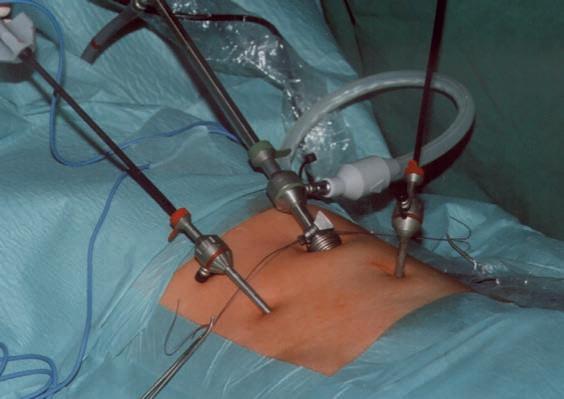
wound infection may resolve with antibiotics, but a deep mesh infection often necessitates mesh removal and a more complex surgical revision. This can be both physically and emotionally taxing for the patient.
Mesh-related complications are not limited to infection. The mesh may erode into surrounding organs or structures such as the bladder or bowel, or it may migrate from its original position. These events can lead to chronic pain, fistula formation or functional disturbances in affected organs. q
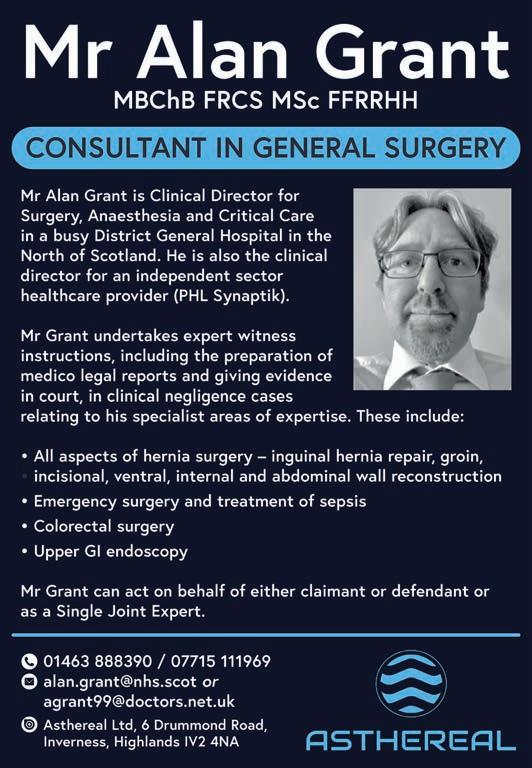
[A MAN WHO LOST A TOE following serious failings in diabetic foot care is speaking out to help prevent others from suffering similar harm.
Colin Rotherham, a retired support worker who lives with Type 2 Diabetes, was under the care of Castlefield and St Paul’s Health Centre, part of Bridgewater Community Healthcare NHS Foundation Trust in Cheshire.
The story was reported by Thompsons Solicitors, who represented him.
During a routine podiatry appointment on 12 January 2023, Mr Rotherham says he felt a sharp pain – following which the podiatrist applied Opsite spray and sent him home. However, on arriving home he found a pool of blood in his sock. Concerned that he may have been cut during his appointment, and worried about infection risks linked to diabetes, he contacted his GP and was prescribed antibiotics.
Over the following weeks and months Mr Rotherham continued attending podiatry appointments during which staff cleaned and dressed the wound and told him that the wound was healing.
However, Mr Rotherham said he felt on-going pain and he had observed that his blood sugar levels were raised. That prompted him to request a further swab during his routine appointments to check for further infections; but he says his concerns were dismissed.
It wasn’t until late April the following year, when his wife removed a dressing that had come loose, that it was discovered that the tip of his toe had become black and necrotic. A swab was finally taken, confirming infection, and he was urgently referred to the diabetic foot clinic, where he was diagnosed with gangrene.
On 17 May 2023, at the Countess of Chester Hospital, he underwent emergency surgery to amputate the second toe on his left foot.
Following the amputation Mr Rotherham instructed Thompsons Solicitors to investigate his care. The trust went on to admit that earlier action – such
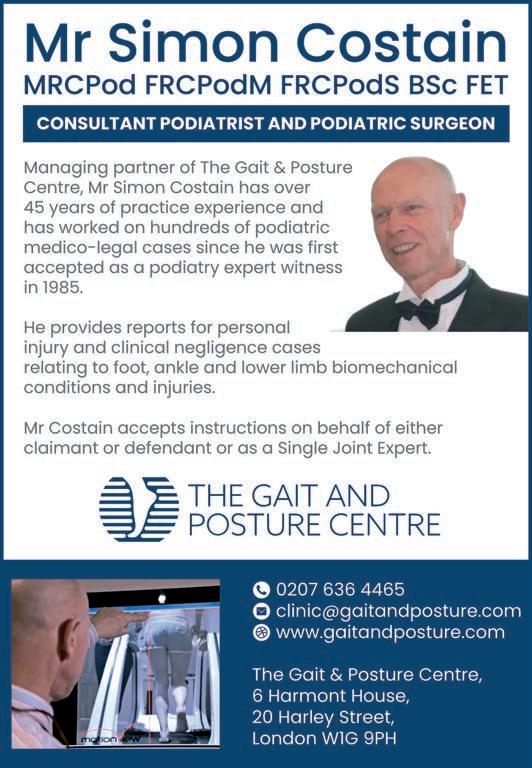
as prompt imaging, referral and infection management – could have avoided the need for amputation.
It also acknowledged that “the failure of the podiatry team to adhere to NICE guidelines and refer the claimant to the diabetic foot clinic MDT fell below a reasonable standard of care”.
“You see a health professional and you place your trust in them,” said Mr Rotherham. “I kept asking if it was healing properly. I was in pain, and my blood sugar was all over the place; but I believed them. I even asked for a swab, but was told it wasn’t needed. I just didn’t feel listened to.
“It was devastating: to go from discomfort to being told your toe is dead – it was such a shock. At one point doctors feared they’d have to remove my whole foot. And to think it could have been avoided with the right aftercare.
“The podiatrist even said ‘mistakes happen’. But that’s not good enough, when those mistakes cost you part of your body. I still don’t feel like anyone’s really acknowledged how badly I was let down.”
The case was settled out of court, with Mr Rotherham receiving compensation that reflects the serious nature of the injury, the on-going costs of rehabilitation and his mobility needs.
Reece Trammer, Mr Rotherham’s solicitor at Thompsons Solicitors, said: “This case highlights the serious consequences of failing to follow clinical guidelines. With proper care this amputation could have been avoided. While the trust’s admissions are welcome, these failings must not be repeated.”
Now, Mr Rotherham is calling for urgent improvements to diabetic foot care: particularly for vulnerable patients. He’s urging NHS Trusts to strengthen staff training, follow national guidelines and prioritise early intervention. q
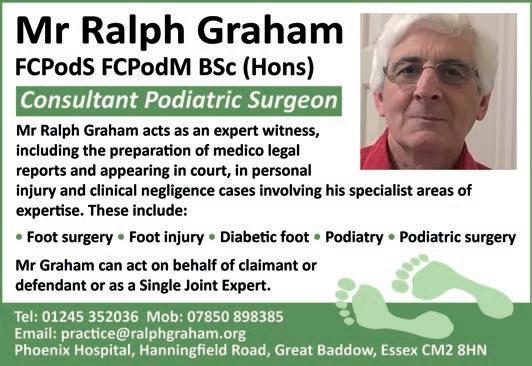

[IN MAY the Health and Safety Executive (HSE) brought two separate prosecutions against companies for exposing workers to potentially harmful dust, which could cause severe respiratory problems in the long term.
On 20 May a company that manufactures popular stone kitchen worktops was fined £60,000 and ordered to pay £7,363 costs at Staines Magistrates’ Court, after it repeatedly failed to protect workers from exposure to hazardous dust.
Inspectors from the Health and Safety Executive visited Inova Stone Ltd nine times over a six year period, and found little or no improvement across several areas of concern.
HSE inspectors were left stunned after visiting the company’s premises in Slough in May 2021 when employees told them that ‘no-one is in charge of health and safety’. That visit had come about after concerns had been raised about unsafe working practices. Inspectors soon saw the complacency for themselves, after identifying several breaches of health and safety law, including a failure to control exposure to respirable crystalline silica (RCS).
RCS dust is invisibly fine and can reach
deep inside the lung. It can cause permanent lung damage before symptoms develop. Stone workers are at risk of exposure to airborne particles of stone dust containing RCS, with the risk higher when exposure is prolonged and uncontrolled. Over time, breathing in these silica particles can cause irreversible, life-changing and often fatal respiratory conditions such as silicosis, chronic obstructive pulmonary disease and lung cancer.
HSE recently updated its guidance for those working on stone worktops – including a helpful guide of do’s and don’ts.
After the hearing, HSE principal inspector Karen Morris said: “After being provided with advice and guidance over several years the company had plenty of opportunities to comply with the law, yet they consistently failed to do so. The fine imposed should send a clear message to employers that the risks from working with engineered stone must be taken extremely seriously.”
Earlier, on 16 May, Fakenham-based wood supplier Nat Pal Ltd was fined £40,000 for failing to protect its workers from exposure to wood dust. The company was also ordered to


pay costs of £4,072, at the hearing at Norwich Magistrates’ Court.
When the Health and Safety Executive visited the company in April 2023, dust was found scattered across the floor (pictured). The inspection identified failings in the company’s control measures to prevent exposure of their employees to wood dust and enforcement action was taken.
Breathing in wood dust excessively can cause asthma and nasal cancer. Guidance on working in the woodworking industry is available and an inspection-led campaign to protect workers continues. The guidance states that employers must take effective measures to prevent exposure of their employees to wood dust.
After the hearing, HSE inspector Natalie Prince said “The fine imposed on Nat Pal Ltd should underline that HSE take a failure to protect the health of employees extremely seriously. To make matters worse, this company had been visited previously and had failed to take steps to protect its workers.” q

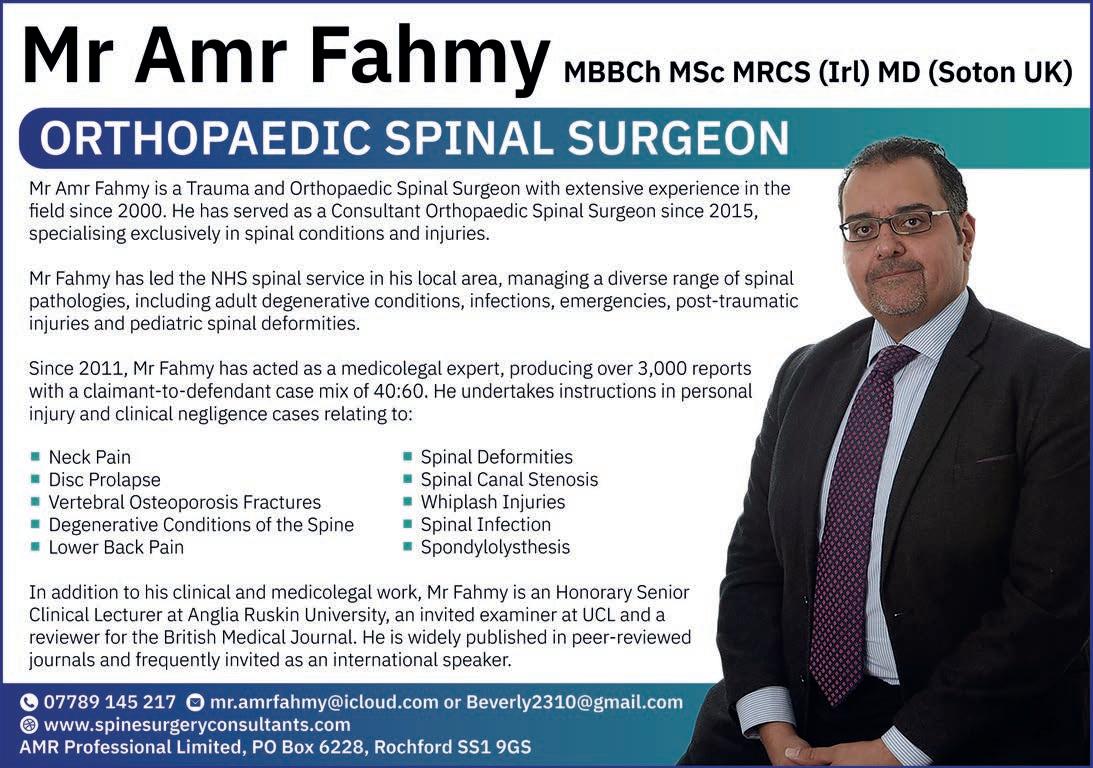
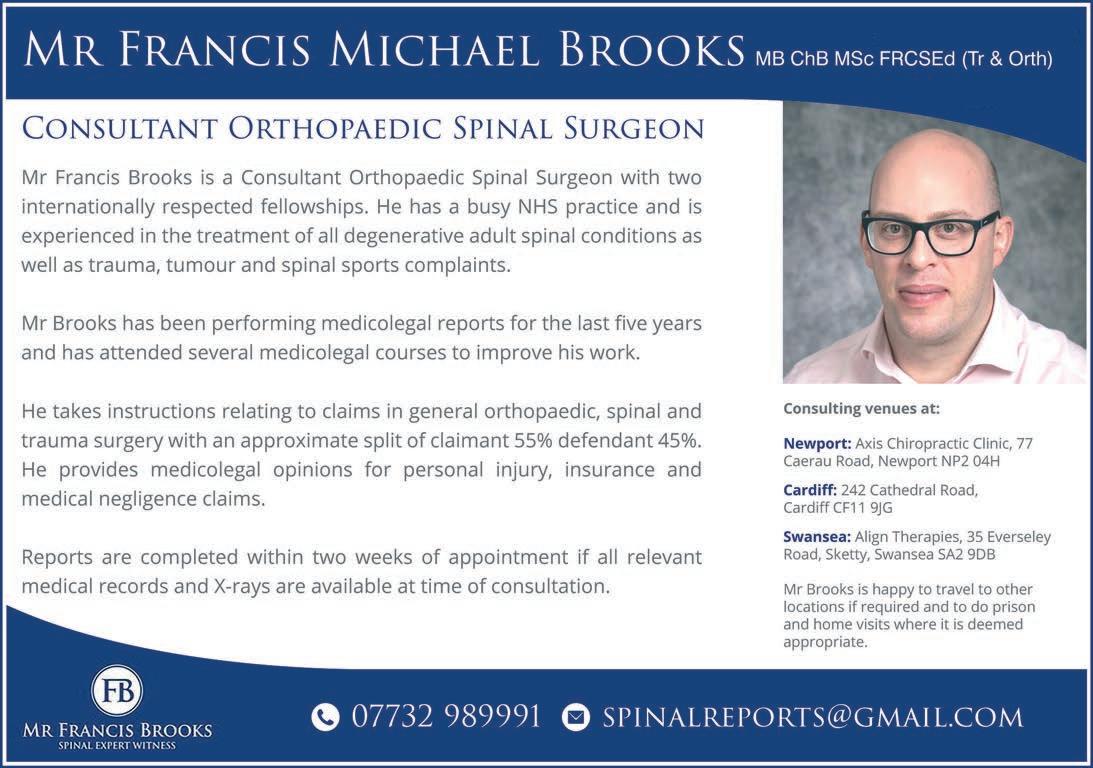
[THE British Orthopaedic Association has updated its BOASt standard for Assessment of the Spine in the Trauma Patient. The guideline describes the clinical and radiological standards for assessment following blunt spinal injury and outlines temporary protective measures until these have been completed.
It excludes penetrating spinal column injury confirmed on imaging –which mandates immediate referral to a spinal surgical team.
According to the guidance: “A spinal immobilisation protocol (including collars, log rolling and patient transfers) must be in place across all trauma networks and apply to all pre-hospital and hospital services.
“Spinal injury should be assumed in all patients and spinal immobilisation and precautions must continue until excluded by clinical assessment and appropriate imaging.
“For patients with cervical kyphosis in ankylosing spondylitis, their usual spinal position must be maintained and supported whilst immobilised in line.”
The guidance references NICE NG41, which covers the assessment and early management of spinal column and spinal cord injury in pre-hospital settings (including ambulance services), emergency departments and major trauma centres. It describes issues that should ‘heighten the index of suspicion for spinal injury’.
The guidance states: “If general clinical or neurological assessment is abnormal, spine precautions must continue until discussion with the regional spinal service as defined by the Spinal Cord Injury BOASt.”
In the case of a fracture: “If a fracture is to be treated nonoperatively, the decision-making team should specify the degree of stability of the fracture and details of the planned non-operative management, such as use of collar/ brace, including duration, care and changing procedures.
“A clear treatment plan including follow up arrangements must be included in the medical records and made available to the patient.” q
[THE ALL-PARTY PARLIAMENTARY GROUP (APPG) on Spinal Cord Injury is running an inquiry to understand what life is really like for people affected by spinal cord injury (SCI) and how things can be better.
The inquiry sessions include:
• The need for a national Spinal Cord Injury strategy
• Rehabilitation
• Agreed Standards & Training
• Lived Experience Roundtable
• Reintegration into the Community
• National Research & Patient Voice Infrastructure
After which the inquiry will be considering submissions from people living with SCI.

The Spinal Injuries Association (SIA), which acts as the secretariat for the APPG, commented: “We believe that the voices of people with lived experience are vital to shaping a national strategy that meets real needs. We want to hear from people who live with SCI, as well as their families and carers. Your views will help us show the government and NHS why change is needed, and what support should look like at every stage, from early care and rehab to returning home and living a full life.
“You don’t need to be an expert or write in any special way. Just tell us what you’ve experienced and what you think needs to change.
The association provided some questions to guide those wanting to make submissions, available at www.spinal.co.uk/news/inquirylaunched-by-appg-spinal-cord-injury/
The association is also inviting professionals and organisations who work with people affected by spinal cord injury, including those in healthcare, law and care provision, to share their insights. Whether they work in hospitals, the community, legal support or home care, their frontline experience is vital, the SIA says.
“We want to understand the challenges, good practice and what needs to change to deliver better support across the SCI pathway.”
Again the association has provided questions to act as a guide.
The SIA says: “Every story matters and will help shape a national conversation about what good care and support should look like for people with spinal cord injury.
“Your insights will help inform recommendations to government and NHS England as part of the inquiry into the need for a national strategy for spinal cord injury.” q

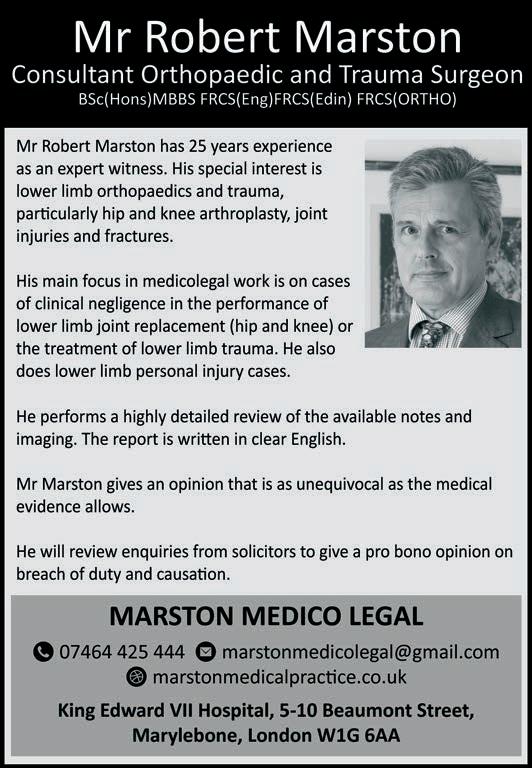
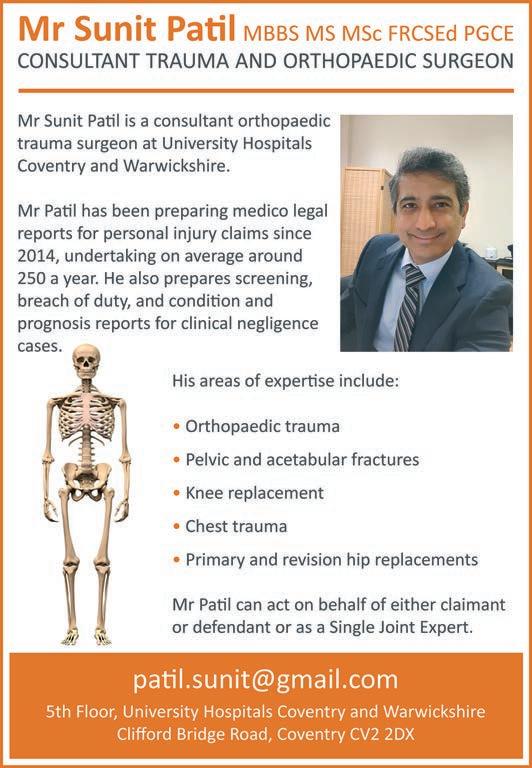
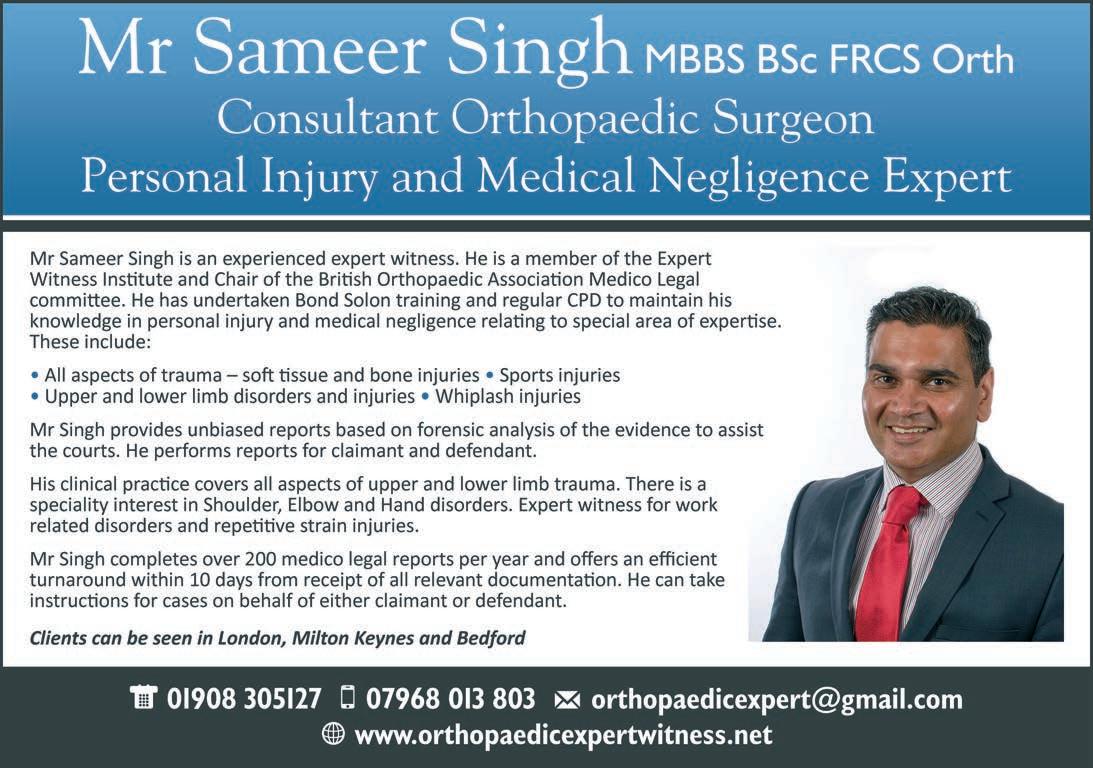
[THE National Institute for Health and Care Excellence (NICE) has published Early Value Assessment (EVA) guidance on the conditional use of six robotassisted surgery (RAS) systems for orthopaedic procedures such as full and partial knee replacement procedures and hip replacements.
The use of RAS in orthopaedics has seen a rapid expansion in the past five years, from approximately 300 procedures per annum in 2018/19 to over 4,000 cases 2024/25.
According to the British Orthopaedic Association (BOA): “EVA guidance provides recommendations on promising health technologies that have the potential to address national unmet need, permitting earlier patient and system access in the NHS while further evidence is generated. By permitting conditional access to a limited number of systems, further evidence will be generated over the next three years to assess if the benefits of these technologies are realised in practice. NICE guidance will be reviewed to include this evidence and make a recommendation on the routine adoption of the technology across the NHS.”

and gathering the evidence on this in orthopaedics. We must innovate and adopt novel technologies for patients; but it is essential to do so in a safe and responsible manner, with highquality data.
“There has been a widespread but an unco-ordinated approach to the adoption of RAS across the UK healthcare sector, without an agreed national approach, particularly in the NHS; leading to inequality of access.
“Although three years is possibly rather short in T&O outcomes terms, this EVA will hopefully give the opportunity to show if the 'improvements in precision’ correlate with potential improved patient outcomes and health economic benefits.
“The training requirements for the use of RAS are significant and is another instance where most consultant training in the use of novel technology has been delivered by industry providers. If we are to show the benefits and commit to equality of access in the longer term, then we must also commit to improvements in the estates and training to deliver these.
In the case of the EVA in question, systematic reviews and randomised controlled trials have shown the potential benefits for RAS in orthopaedic procedures. They include:
• Improved patient outcomes
• Reduced length of stay
• Improved survivorship in registry data
• Less soft tissue damage
• Improved implant positioning
• Reduced dislocation rates
• Reduced rates of musculoskeletal injuries, fatigue and pain
• amongst surgeons
A major barrier to more widespread adoption of RAS for many organisations is the capital and revenue cost of establishing and running a RAS programme which have to be high volume and be capable of efficient turnaround times, with minimal downtime for the systems. Scalability and equity of access to RAS are also an increasing challenge in providing training and mentorship at a pace that matches the procurement of RAS systems.
BOA president Mark Bowditch said: “We welcome this decision to support further evidence on novel innovative technologies such as robotic-assisted surgery. The UK is leading the world with designing
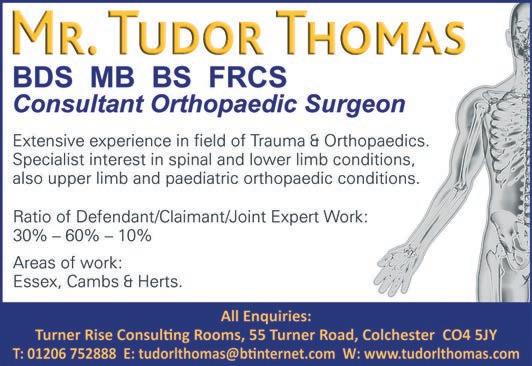
“Nevertheless, we are delighted at this step towards encouraging data-driven innovation and working with our industry partners in potential improvements in patient care.” q
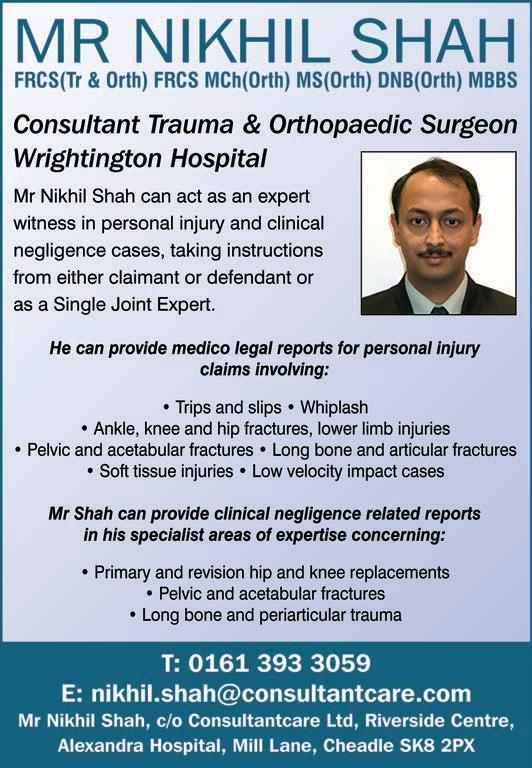
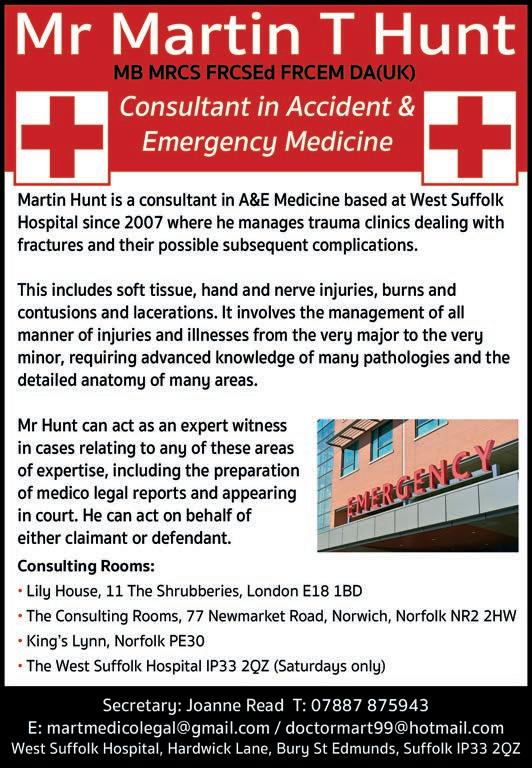

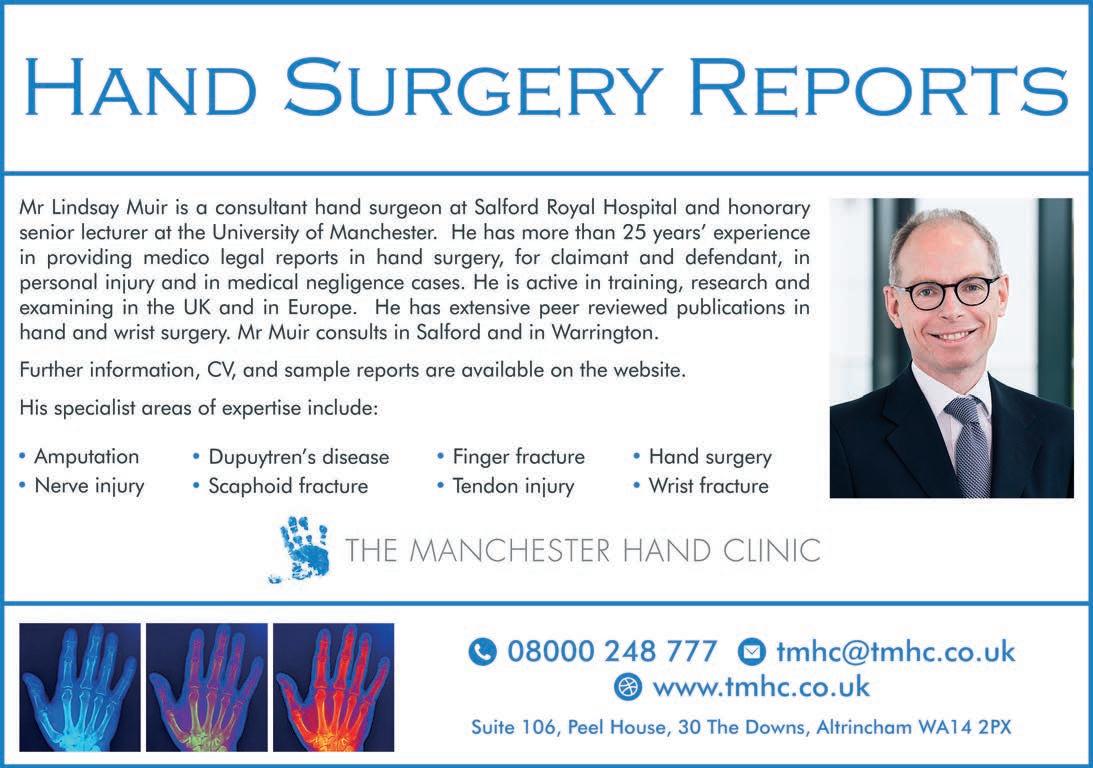
[THE British Association of Aesthetic Plastic Surgeons (BAAPS) has published its annual audit for 2024-25. The audit reveals a 5% overall rise in cosmetic surgical procedures, with a total of 27,462 procedures performed in 2024. That surge was largely driven by increases in facial rejuvenation and body contouring procedures, while male cosmetic surgery numbers saw a slight decline.
Key highlights:
Breast augmentation remains most popular. With 5,202 procedures performed, breast augmentation saw a 6% rise, securing its position as the most sought-after cosmetic surgery in 2024.
Eyelid surgery is on the rise Blepharoplasty jumped 13%, moving up to the third most popular procedure – surpassing abdominoplasty.
Face-off Face and neck lifts increased by 8% while brow lifts saw a 20% jump.
Body contouring grows Liposuction (+8%), abdominoplasty (+6%) and thigh lifts (+24%) all saw significant increases.
Men’s procedures decline. While male cosmetic surgery made up only 6.5% of total procedures, it nevertheless saw a 1.5% drop from 2023, with rhinoplasty (-14%) and liposuction (-7%) declining the most.
The top five cosmetic procedures of 2024 were:
• Breast augmentation – 5,202 (+6%)
• Breast reduction – 4,707 (+1%)
• Blepharoplasty (eyelid surgery) – 3,138 (+13%)
• Abdominoplasty (tummy tuck) – 2,997 (+6%)
• Liposuction – 2,623 (+8%)
Women accounted for 93.5% of all cosmetic surgeries in 2024, with a total of 25,663 procedures performed (+6% from 2023). Eyelid surgery showed the most notable increase (+15%), overtaking abdominoplasty in popularity. Brow lifts (+25%) and thigh lifts (+25%) also saw sharp rises.
BAAPS president Nora Nugent said: “Breast augmentation remains limited to two primary methods – breast implants or fat transfer – but these approaches yield different results. Fat transfer offers a more subtle enhancement, which may explain the continued demand for implants, as there is no true alternative for many women. Interestingly, implant removal rates have also declined, possibly for similar reasons. Additionally, new research is helping to reshape previous misconceptions about the long-term safety of breast implants.”
Men underwent 1,799 procedures in 2024, a 1.5% decrease from 2023. Rhinoplasty remained the most popular male procedure (332 surgeries), despite a 14% drop. However, face and neck lifts surged by 26%, suggesting a growing interest in anti-aging procedures among men.
Nora Nugent commented: “The decline in male plastic surgery may appear more pronounced due to the smaller number of procedures overall, making fluctuations more noticeable. However, we are seeing a rise in facelifts among men, mirroring the trend observed in women.”
Non-surgical procedures also saw a slight increase, with Botox treatments increasing by 5% and dermal fillers by 27%.
Summarising what the data suggests, BAAPS vice president Anthony Macquillan said: “Post-COVID, we’ve observed a shift in patient priorities, with a greater focus on both mental and functional health. This may explain the rise in procedures like abdominoplasties and breast reductions, which offer both physical and psychological benefits.
“At the same time, the increase in facelifts could be linked to societal changes, such as the rising pension age and the desire to remain
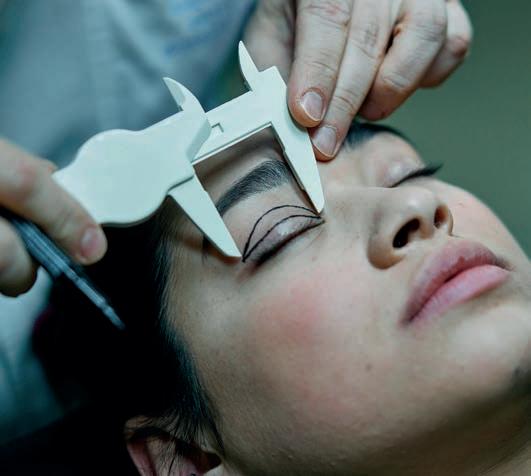
relevant in the workplace. For many, this type of surgery is not just aesthetic but also functional, helping to maintain confidence, secure employment and reduce anxiety associated with age-related bias.” The full audit results can be found at baaps.org.uk q
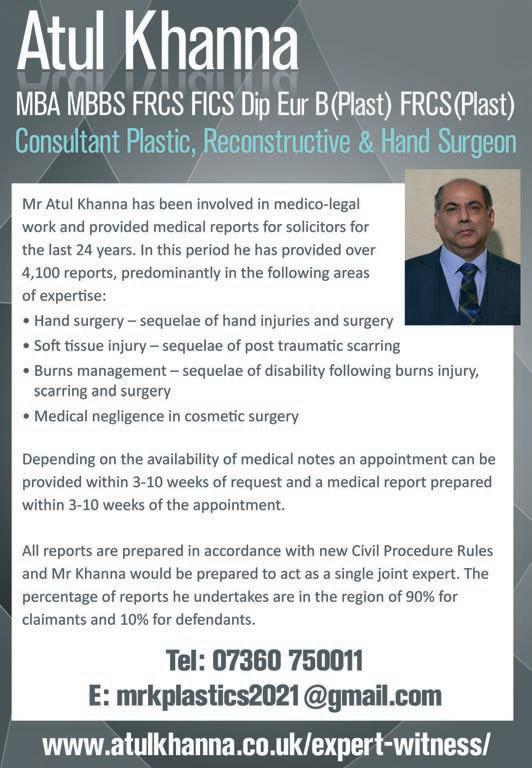
[ LEADING LAW FIRM DWF has reported on what it describes as part of an on-going collaboration in the fight against claims layering. The firm acted for Markerstudy Insurance Services Ltd in a claim seemingly layered with the addition of claims for tinnitus and psychological injuries.
Following investigations and Part 35 replies, it became apparent that the replies of the ENT expert Mr Khan were not adequate, with him ‘implying’ that he had relied on what the claimant had told him. Consequently DWF applied to call Mr Khan to give oral evidence at trial.
At trial the claimant’s counsel advised the court that he had been told by Mr Khan that he had not personally examined the claimant, despite him having provided a report stating that he had. Off the back of that admission Mr Khan’s evidence was abandoned and the tinnitus claim dismissed.

The judge made a finding against the claimant of fundamental dishonesty pursuant to Section 57 of the CJCA 2015 as a result of the claimant’s exaggeration regarding his psychological symptoms. DWF then successfully applied to join Mr Khan into the
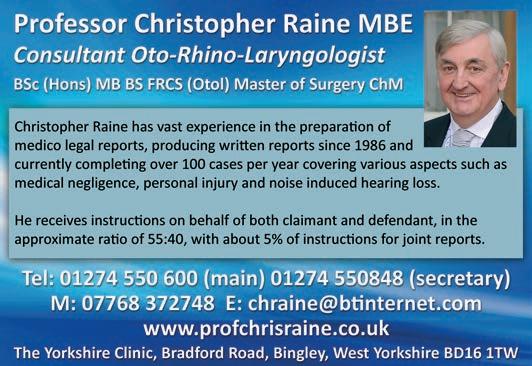
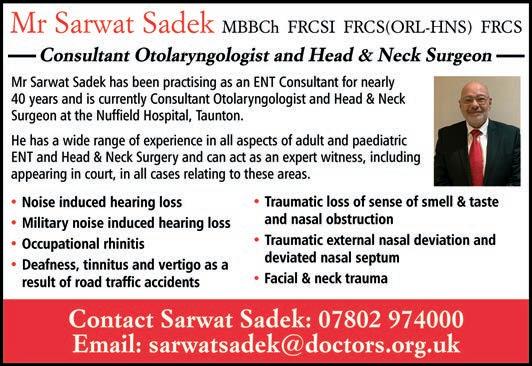
proceedings as a party for the purpose of costs. The court ordered Mr Khan to pay the defendant’s wasted costs, assessed at approximately £16,000.00. The judge found Mr Khan’s conduct ‘concerning’ and to be a ‘wholesale failure that called into question more than just the report in the index proceedings’.
The judge furthermore alerted consulting members of the senior judiciary for a possible referral to the Attorney General. Based on Mr Khan’s behaviour and the findings made, DWF are also advising Markerstudy Insurance Services Ltd on taking further action.
Sam Lee, fraud and technical risk manager at Markerstudy Insurance Services Ltd, said: “The evidence in support of this claim from a highly experienced consultant ENT specialist on face value carried significant weight. It’s truly shocking that Mr Khan would put his name to a report supporting a significant financial claim for an individual he had not personally examined.
“I welcome the strong message sent by the court here in its comments and actions relating to Mr Khan.” q
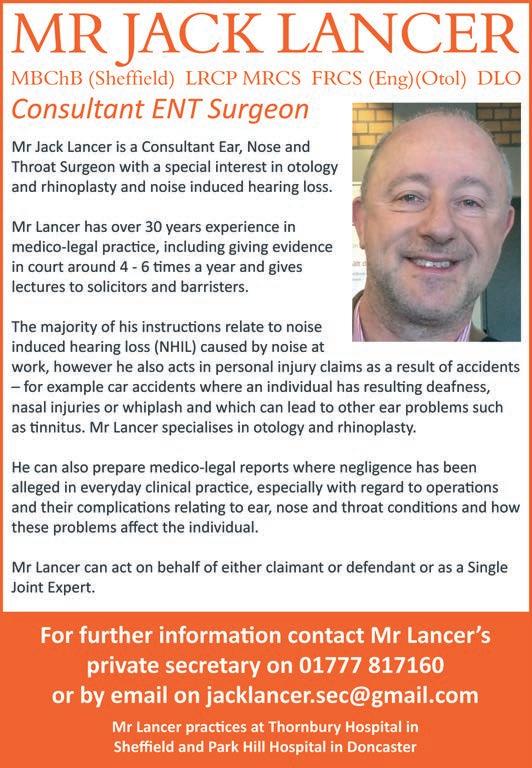
[ JF LAW LIMITED , in its persona of online claims lawyers Legal Expert.co.uk, have described a typical claim for damages following scalp damage caused by a hairdresser.
The claimant had visited a hair salon to have her hair lightened. The client had a history of skin and hair irritation with certain products and requested the use of all-natural products with no harsh chemicals on her scalp. As a precautionary step a patch test was carried out and there was no adverse reaction to the claimant’s skin or hair.
Several days later the claimant visited the hair salon for the full treatment as booked. However, the hairdresser did not use the same products which had been tested on the claimant’s hair and scalp. Initially, the claimant noticed that their new hair colour was not as expected.
It was alleged that the damaged hair and scalp were then caused by the hair salon trying to rectify that by reapplying the hair products to achieve the desired ‘look’ for the claimant. The salon were alleged to
have used an excessive amount of hair products, which had not been patch tested on the claimant.
Very soon after the treatments were applied, the claimant began to notice their damaged hair as well as some scalp damage. The claimant’s damaged hair was very noticeable. She also suffered skin symptoms over her ears, where the products had come into contact with the skin, and her cheeks. As a first step, the claimant went to her local A&E department, where she was prescribed a course of skin treatment as well as painkillers.
The claimant also visited a dermatologist over the longer term. She was diagnosed with a severe case of dermatitis caused by chemicals in the hair treatment products. Alopecia was also caused by the dermatitis. The hair loss and overall damage to the hair the claimant suffered forced her to wear a wig to hide the damage and bald patches.
As well as the physical injuries, the claimant also suffered symptoms of anxiety as well as depression and became
short-tempered at times as a result of the damage to her hair. The claimant saw a mental health practitioner and was diagnosed with an adjustment disorder. She was prescribed treatment for this concurrently with her physical injuries. The claims against hairdresser included both sets of injuries: physical and psychological. The claimant’s hair did start to grow back after about a year of treatment, and within three years it had returned to its previous condition.
Hairdressing compensation claims can sometimes be quicker and easier to resolve than others. In the case in point there was no need to take small claims court action as the hairdresser did admit their liability. The two parties were able to come to a settlement out of court and a total of £8,300 compensation was agreed upon. Of this, £1,500 was awarded for future medical costs and £300 was awarded for miscellaneous costs and interest. The bulk of the award – £6,500 –was awarded for the claimant’s pain and suffering, as well as her loss of amenity. q

By Anna M M Wybraniec , consultant clinical psychologist
[
SAYING THAT assessment of PTSD is a complex process and that it requires a specialist's knowledge may sound like stating the obvious. Yet, it is not uncommon in the medico-legal arena to encounter the view that diagnosis of PTSD is a simple process of ‘ticking boxes’, that it can be done using simple templates or that just evaluation of medical notes, without seeing the client, would be sufficient to make a diagnosis. Not infrequently, solicitors have asked me to ‘confirm’ the diagnosis presented in the medical notes without assessing the client.
On the other hand, since last year, I have observed an increase in the number of new medico-legal agencies trying to recruit psychology experts to assess clients for PTSD by using standard templates. When I have been approached by such companies, they have tried to convince me that such templates would facilitate the assessment process and, as a result, I could prepare six to eight reports daily! Understandably, a solicitor would pay a very low price for such a report, but the quality and reliability would be far from the minimum standard. I am not aware of the number of solicitors that have become ‘victims’ of such agencies, but in case any law firm might be tempted to use their services, I have listed below some of the challenges an expert has to consider and address, when assessing PTSD, in order to create a valid and reliable diagnosis. These challenges cannot be properly approached while using simple templates.
To arrive at the right conclusions, data from all available sources should be gathered. Relying mostly or even exclusively on medical notes poses at least two major dilemmas:
• Limited or lack of medical records. The medical notes are often
• fragmented, incomplete and inaccurate. In many cases there may
• be a complete lack of any data related to PTSD, as the symptoms
• were unreported. Why? That could be due to a lack of awareness in
• a claimant of how symptoms of trauma can show up, or due to
• avoidance of distress associated with talking about their symptoms.
• Lack of independent opinion. If the expert places too much
• emphasis on what is or is not present in the medical notes, would
• their opinion be considered an independent opinion, or would it
• rather be an opinion of another mental health professional
• confirmed by the expert?
Every expert witness who evaluates a claimant for post-traumatic stress disorder must consider the possibility of malingering. According to DSM5, malingering is defined as the intentional production of false or grossly exaggerated physical or psychological symptoms for external gain. Assessment of malingering can be challenging: the specific DSM criteria necessary for the diagnosis of PTSD are easily accessible on the internet, and there are entire psychological reports on PTSD presented online for everybody to view. That poses additional difficulty for an expert since it permits any potential malingerer to prepare the ‘correct’ responses.
So, what can experts do? To increase the reliability of the diagnosis, certain guidelines for assessment of malingering should be followed, which take into account:
• A thorough evaluation of available collateral data, such as police
• reports, witness statements, past medical/psychological records of
• the claimant and the assessment of at least one family member of
• the claimant.
• Information obtained from the claimant: a detailed history of the
• traumatic event and the claimant’s psychological symptoms,
• treatment efforts, living patterns, any prior compensation claims or
• lawsuits and any arrests or criminal charges
• The clinician’s interview style. Ideally, the interview style should employ
• two types of questioning: open-ended questions and closed questions.
• The latter should follow a structured interview based on the SCD-I
• Structured Interview and the DSM. The clinician should obtain a very
• detailed description of each symptom, with specific examples.
• Assessment of the differential diagnosis of malingered PTSD. That
• should include an evaluation of whether the symptoms reported by
• the claimant and their development are compatible with their
• description in clinical literature.
• Consideration of the threshold for a full assessment of malingering:
• for example, if there is evidence of poor work record, prior
• ‘incapacitating’ injuries, discrepant capacity of work and recreational
• activities, unvarying repetitive dreams, antisocial personality
• traits, over-idealised functioning before the trauma, evasiveness
• and inconsistency in either symptoms presentation or between
• various sources of information.
A psychological diagnosis should be based on a coherent psychological formulation.
A psychological diagnosis is the process of identifying and classifying an individual’s mental health condition based on specific criteria outlined in manuals like the Diagnostic and Statistical Manual of Mental Disorders (DSM) or the International Classification of Diseases (ICD)
Psychological formulation is an explanation of why someone is experiencing psychological difficulties, how symptoms have developed, what maintains them and the relationship between them.
In simple cases, when a claimant has no prior medical or psychological history, the traumatic event did not lead to the development of chronic physical problems and there are no additional traumas following the index event, the diagnosis can be pretty straightforward.
In complex cases, however, the coexistence of at least two different diagnoses is not infrequent and may be necessary to make. Therefore, a psychological formulation would be needed to explain the relationship between all the diagnoses – PTSD, chronic pain or depression – and how they relate to each other. In such cases, an expert not only has to have expertise in the assessment of PTSD but also an in-depth knowledge and experience in the assessment and treatment of any other condition the claimant may suffer from in order to understand and explain the complexity of the relationship between all of the symptoms.
In summary, each psychological assessment should be conducted with diligence and care. It should be tailored and appropriately adjusted to each client, depending on the information obtained during the process of gathering data. In complex cases, it is especially important to choose an expert with expertise in dealing with all of the problems and difficulties a client suffers from in order to arrive at the right conclusions. q
[IN RECENT YEARS there has been concern expressed both by the judiciary and the press about the appropriate use of psychologists in the Family Court, particularly where the psychologist’s report can lead to a decision as to which parent assumes custody of children.
Last October, commenting on a series of articles in The Guardian, the Association of Clinical Psychologists said: “Problems with poor regulation have also led to significant problems within the family court with the potential for significant harm.”
Milners Solicitors commented: “It matters because the diagnosis and assessments that are made by expert witnesses can have far-reaching, profound consequences for children. A psychologist’s report can influence whether a child is placed in care or which parent they live with.”
They cited a case in point: “To take a recent example, a woman anonymised as ‘Helena’ had her children removed after a psychologist convinced the judge that she had ‘alienated’ them from their father. The psychologist in question was appointed by the court – but not approved by the regulator.”
The regulator referred to is the Health and Care Professions Council (HCPC), which regulates the protected healthcare

professions. The term ‘psychologist’ is not protected and anyone can call themself a psychologist. That is opposed to terms such as clinical psychologist, educational psychologist, health psychologist or counselling psychologist.
In addition, many problems arise because the psychologist appointed by the court may not be a psychologist practising in a clinical setting. They may be an academic who works purely in a teaching role, with no contact with real patients.
In 2023 the Family Justice Council and the British Psychological Society (BPS) issued new guidance. It states: “Courts
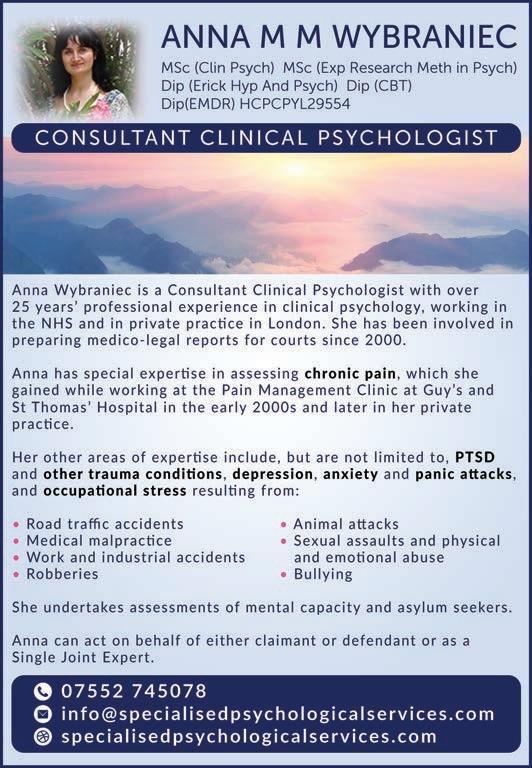
should expect that all psychologists based in the UK providing evidence in family proceedings are regulated by the HCPC (if they are practitioners) and/or that academic psychologists have Chartered membership with the BPS.
“It remains at the discretion of the court to appoint individuals who are not eligible for Chartered membership of the BPS or qualified for registration with the HCPC but that the court determines have relevant psychological knowledge or training.
“However, it should be made clear in orders and letters of instruction that these individuals are not being appointed as psychologist experts but under the auspices of other professional frameworks, eg independent social workers with additional psychological qualifications or psychotherapists. These individuals are also distinct from psychologists in relation to their remuneration rates paid by the Legal Aid Agency.”
Milners quotes the guidance’s lead author Dr Jaime Craig, as reported in The Guardian: “Were you to see a psychologist in the NHS you would only see a practitioner and not a researcher. There are lots of psychologists who do very interesting research but they are not qualified to make assessments and diagnoses – or deliver treatment.” q


In this first of a two-part series, Professor Walter Busuttil, consultant psychiatrist at Expert in Mind, looks at some cases which document the effects on mental health caused by physical health clinical negligence.
[ I HAVE FOUND over the years that it is really important to read the letter of instruction from the solicitors very carefully and to work out and understand exactly what they’re asking of me. If the request is not clear, pick up the phone and discuss it with the instructing solicitors. One will obviously need to know whether the instruction comes from a claimant’s solicitors or defendant’s solicitors, or whether you are being jointly instructed.
Usually, the letter of instruction will contain a summary of the case, which is important as a guide to understand what is going on. There could be a whole series of events that occurred in relation to a medical clinical negligence case where, for example, a surgical operation went wrong, and the solicitors require your opinion as the appointed medicolegal expert psychiatrist or psychologist as to whether or not a mental illness has occurred as a result of the alleged negligence. Would this mental illness have happened in any case because of the nature of the operation?
Of course, in reflecting carefully about the case, one will need to think about predisposing factors, precipitating factors and maintaining factors. Those are issues of causation from a legal perspective.
From a predisposition point of view, a past psychiatric history or family history of mental illness could be important, as well as exposure to previous trauma or significant life events or similar events.
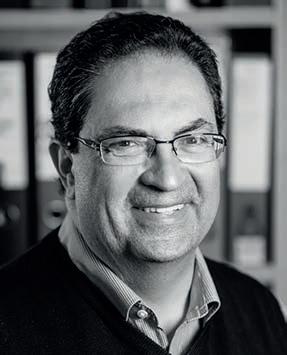
normally read and summarise all relevant parts of the documents. I would start with the letter of instruction, and then the letters of claim and defence, moving on to the general practice records and hospital records and finishing with the expert medicolegal reports. I would make written summaries of important entries within each document. I would also make a note of the date and the page of each entry relevant to the case.

As far as maintaining factors are concerned, it is important to bear in mind the resultant long-term physical health of the patient post the alleged negligence. Will there be chronic pain, or scarring, or disability ascribed to the negligence which is only present because of the negligence? Those factors may be maintaining factors which trigger the mental illness prognostically.
One will need to consider what other experts are saying about the physical health prognosis, as there will be an impact on the long-term mental health prognosis. One may consider recommending treatment interventions which are co-ordinated with physical health recovery, such as antidepressant medications that treat depression as well as chronic pain.
The solicitors will usually send a bundle of clinical records, including the general practice records and possibly hospital records, as well as other expert medicolegal reports. In addition, they may include a letter of claim and the response letter rebutting the claims from the defence.
In my own clinical practice preparing medicolegal reports, I would
I find that this process always gives me a good insight and understanding of what is going on. I start chronologically with the general practice records as they give a broad idea of the lifelong clinical history of the individual. I usually start with the Lloyd George handwritten records and then go on to summarise the electronic consultation records. I would also consider the electronic summaries and medication prescribing records, which allow a bird’s eye view of physical and mental illness over many years, as well as medications prescribed and the frequency of those prescribed medications. Following that I would summarise the letters of correspondence. Then I would read and make handwritten notes of the hospital records, excluding anything already summarised within the general practice records and anything that was not relevant from a mental health perspective. Finally, I would read and make notes from the expert medicolegal reports. To keep track of the important entries in all those records, I usually prepare a brief handwritten note of each relevant entry, together with the date and page number on the bundle.
Following that, before seeing the patient I would dictate what will be the second part of my report – the ‘Evidence from the Documentation Provided’ – by following the notes I have made and referring to the entry of each note in the bundle. That process, I find, gives me a second run at the records and allows me to analyse the importance and relevance of each entry.
In this way, before seeing the patient I would have a very good idea not only of what has happened, but a clear idea of the clinical framework that the index events or event actually fit into. So, for example, if there’s a prior chronic history of depression documented in the clinical records predating the index event, or a history of childhood trauma predating the index event, I have a better handle on how relevant and important those potentially predisposing factors are.
In my next instalment I will talk a bit about the actual assessment of the patient, and easy ways to go about it. q


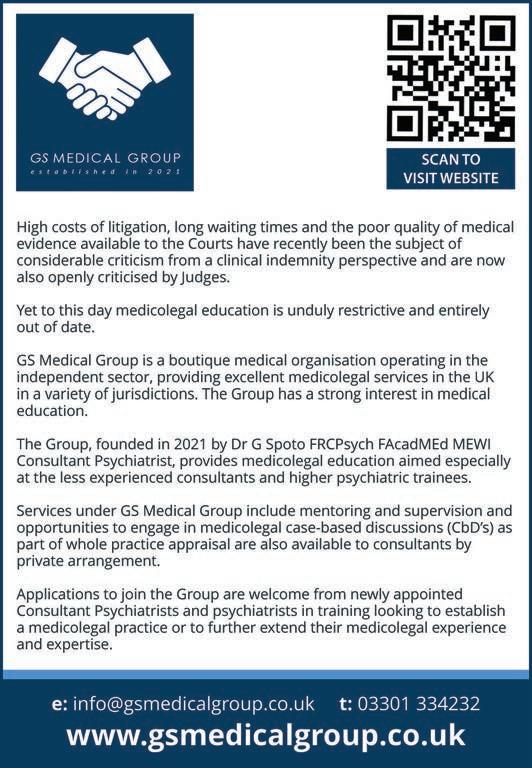
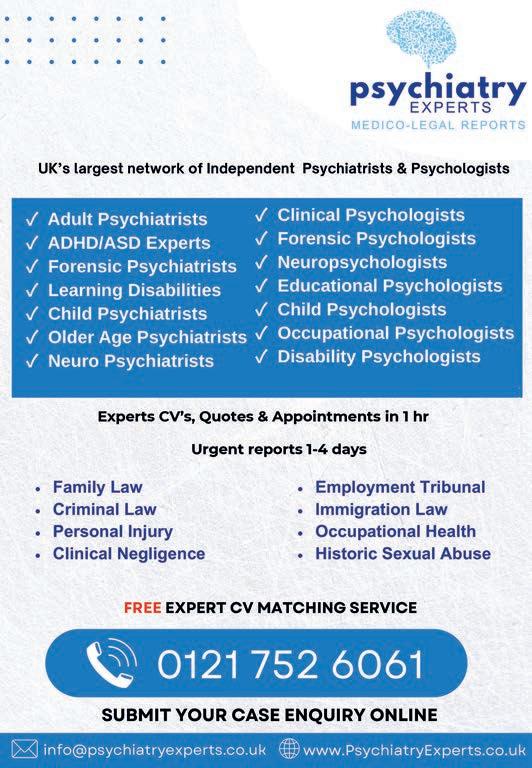
[SPECIALISED MENTAL HEALTH SUPPORT for jurors should be made readily available across the country, following the completion of a government pilot: that’s according to the British Psychological Society (BPS).
The BPS continues to be concerned that jurors who are exposed to distressing evidence in court, sometimes over several months, are particularly at risk. Jurors can potentially go without psychological support throughout a case and can be 'dropped' at the end of their service, with no support available.
The call comes after the pilot scheme in 14 Crown Courts across the country concluded in April, when jurors in the most traumatic cases were offered support and free counselling sessions around the clock for the first time.
Speaking ahead of Juror Appreciation Week in May, which highlights the underappreciated role of jurors within the justice system, BPS president Dr Roman Raczka said: "Jurors are members of the public who have been required to join court proceedings from their everyday lives, and who can potentially be exposed to material far beyond what they are used to seeing. Following our work to raise awareness of the lack of psychological support for jurors, the government pilot was a positive step in the right direction. We hope the support seen within the scheme will be rolled out nationally and look forward to the results in due course."
[RESPONDING TO A REPORT by the London Drugs Commission, the Royal College of Psychiatrists has called for an end to underestimating the harms caused by use of natural cannabis and ‘synthetic’ cannabinoids.
Dr Lade Smith CBE, president of the Royal College of Psychiatrists, said: “Cannabis is the most widely used illicit substance in the UK, and around a third of people who use cannabis develop a problem with the drug at some point during their lives. This is a similar proportion to people who will develop a problem with alcohol. Despite this, there is a widespread misapprehension that cannabis is not an addictive substance.

“Daily cannabis use is associated with depression, anxiety and reduced motivation. At worst, it makes vulnerable people up to five times more likely to develop a psychotic disorder, with adolescents at particular risk.
“We agree with the London Drugs Commission’s ambition to focus on a public health approach to cannabis use, especially given the disproportionately negative impact cannabis use has on younger people.
“And though we also welcome an examination of the danger of synthetic cannabinoids, it is important not to underestimate the potential harms caused by natural cannabis. Some of the most potent cannabis found on our streets is natural in origin.
“As a priority, the UK Government must provide substance use and mental health services with the training, staff and funding they need to support people with co-occurring substance use and mental illness. The RCPsych has recently published a report on co-occurring substance use and mental illness. This can be used to support the implementation of a co-ordinated approach, across England, in which patients are managed based on the severity of their illness and level of need.” q
Research from psychologists at Manchester Metropolitan University, published in the British Journal of Clinical Psychology found a fourfold increase in post-traumatic stress (PTSD) symptoms in jurors who had witnessed upsetting evidence. Within the study, 44% of participants who were shown a murder case summary and evidence of skeletal remains reported signs of PTSD seven days later.
Jurors, who are often exposed to material that could result in vicarious trauma, are currently signposted to their GP to access NHS Talking Therapies and the Samaritans should they experience distress or mental health difficulties following their jury service. However, with waiting lists for NHS mental health services rising all the time, the BPS is urging the government to provide more efficient psychological support for jurors and a nationwide rollout of their pilot scheme.
Such support should at the very least be provided when cases meet a certain threshold for the evidence jurors are expected to consider.
Dr Raczka continued: “Material jurors face could include graphic detail and images about extreme physical, sexual and emotional harm, and further contextual information – which creates a strong potential for people to experience vicarious trauma. We must ensure the role and importance of jurors is recognised; and that includes recognising the potentially damaging mental health impact of being part of a jury during particularly distressing and traumatising cases.
“Ultimately we want to see proper psychological support available during and after trials, to ensure a better experience for all within the criminal justice system. One solution could be to replicate the model used in Scotland where there is a dedicated counselling service for jurors.” q
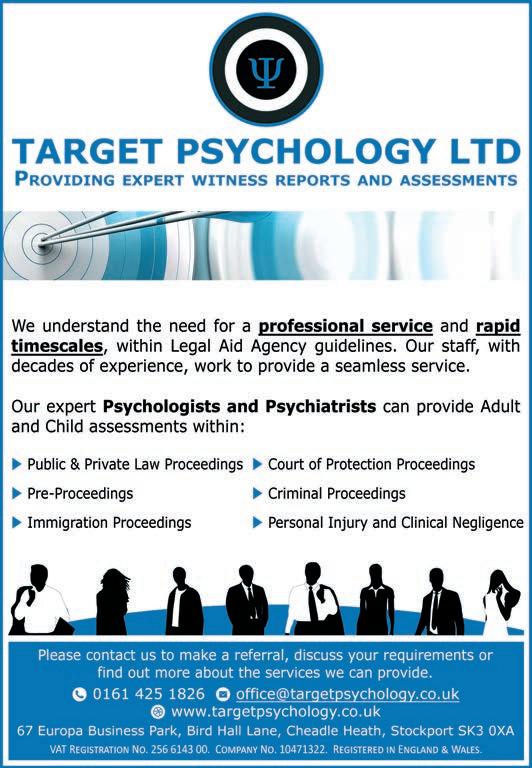
By Lisa Crowther of Carter Brown
[ WHEN WAS the last time you gave feedback to an expert on the role they played in proceedings, and the contribution made by their evidence?
In legal proceedings, expert witnesses can play a pivotal role in bridging the gap between technical knowledge and legal argument. Their input can shape the outcome of a case, providing clarity on complex matters that require specialist interpretation. Yet one vital component of that working relationship is frequently overlooked: constructive feedback from solicitors to their expert witnesses.
It is surprising how often experts tell me that they do not know how their report has been received or how helpful – or not –they have been to the court.
Feedback is not just a professional courtesy: it’s a strategic tool. First and foremost, it helps improve the quality of future reports and testimony. Experts are usually highly trained in their field but may lack insight into the legal standards and expectations surrounding their contributions. Clear, specific feedback from solicitors allows experts to tailor their reports to better serve the court’s needs: whether that means refining the tone, adjusting the level of technical detail or aligning with procedural expectations.

Secondly, feedback fosters stronger professional relationships. When experts understand what worked well or what could be improved, they’re better equipped to support future cases with increased precision and confidence. Conversely, the absence of feedback can create uncertainty, leading to missed opportunities for improvement and potentially weakening the solicitor’s case in subsequent matters.
Moreover, providing feedback contributes to the integrity of the legal process. Courts rely on experts to be clear, impartial and comprehensible. When solicitors help experts to understand the judicial perspective – such as how their evidence was perceived or why a report was challenged – it elevates the overall quality of expert input in proceedings. That ultimately benefits clients, the court and the pursuit of justice.
Feedback should be timely, balanced and actionable. It’s most effective when it includes both positive reinforcement and areas for development. A quick conversation or written note following a hearing or report submission can be sufficient, especially if it’s framed constructively and with respect.
Finally, for firms that work with a panel of preferred experts, providing feedback supports consistency across cases. It builds a reliable network of specialists who understand a firm’s standards, communication style and procedural expectations – streamlining future engagements and enhancing case outcomes.
In short, giving feedback to expert witnesses isn’t merely good practice: it’s essential. By investing in such communication, solicitors not only improve the effectiveness of expert contributions but also strengthen the foundations of their legal strategy, and play a key role in an expert’s continuing professional development. q

[A NATIONAL wake-up call is needed on neurodiversity services, the Royal College of Psychiatrists in Scotland has said. The call comes after a Scottish Liberal Democrat debate on Addressing the Inadequate Provision for Neurodevelopmental Conditions in the Scottish Parliament.
RCPsych in Scotland recently consulted with a number of senior doctors and those who live with neurodiversity to develop a proposal that it is hoped, if adopted, will improve the lives of those who live with conditions such as autism and ADHD. The plan includes measures such as a new public health campaign and digital self-help resources and funding put in place for specialist teams and mental health hubs across the country. Each hub would have the capacity to help around 8,000 patients each year – cutting waiting times.
And with each hub estimated to cost around £2.7m, it is projected it would save the public purse an incredible amount yearly, in comparison to the current spend on unsupported neurodevelopmental conditions.
Speaking after the debate, Dr Jim Crabb, policy lead at RCPsych in Scotland, said: “The demand for support for people with ADHD and autism has soared; and without a dedicated service we’re now at breaking point. This is leading to a mental health crisis which includes unsustainable waiting times, delayed care for patients and an overburdened mental health sector.
“Conditions like ADHD are on the rise, but the current mental health system is built to provide help to people with more serious mental illness. That’s why we’re calling for a public health campaign and digital self-help resources to raise awareness, so individuals feel empowered and make informed choices: even without a formal diagnosis.
“We’d also like to see funding put in place for specialist teams and to establish mental health hubs across the country, so nobody falls through the cracks.
“This is about fairness, dignity and making sure no one is left behind: it’s also about protecting our mental health workforce, as demand for services continues to increase at an alarming level. We need a national wake-up call because, without urgent action, the services our patients rely on could collapse.” q
[ PSYCHOLOGISTS MUST BE INCLUDED as part of a co-ordinated multidisciplinary approach to treatment of functional neurological disorder (FND), according to the British Psychological Society.
FND is a neurological condition with biopsychosocial elements, which disrupts normal pathways, patterns and networks of brain processing. Symptoms can include arm and leg weakness and seizures.
To emphasise the vital role that psychological treatment can play in helping those with FND, the BPS has published new guidance for the profession.
Recommendations in the guidance include:
• Training in FND to be a core component of psychologist training
• programmes
• FND treatment services to be located within neurological
• neurorehabilitation services for better multidisciplinary coordination
• A national framework and new funding to develop effective service
• in all areas.
Chair of the working group, and Chartered member of the BPS’s Division of Neuropsychology, Dr Niels Detert said: “FND is a complex condition and requires a multidisciplinary approach to be effectively treated. Psychologists are a key part of this multifaceted approach. This could take the form of specialist assessments, treatments and co-ordinated therapy with other multidisciplinary colleagues.
“Historically there has been a lack of services for patients with FND, which has led to a lack of appropriate care and poor health outcomes, often exacerbating symptoms. Psychological services should be embedded within treatment pathways to deliver the best results for FND patients.” q

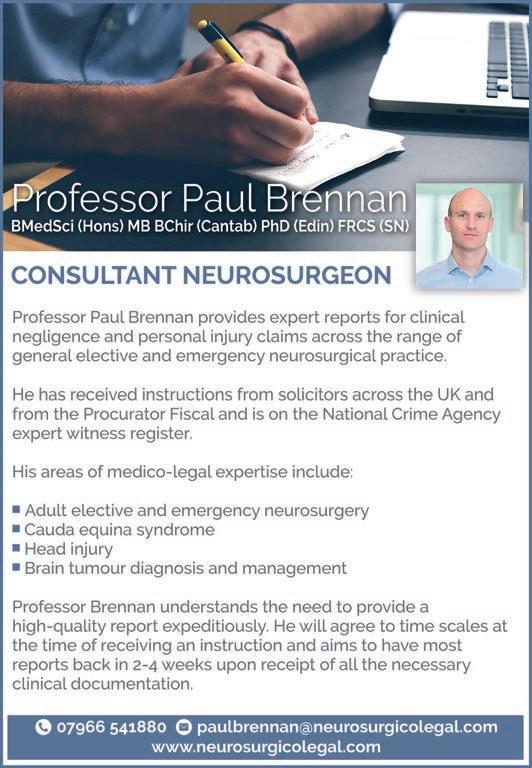
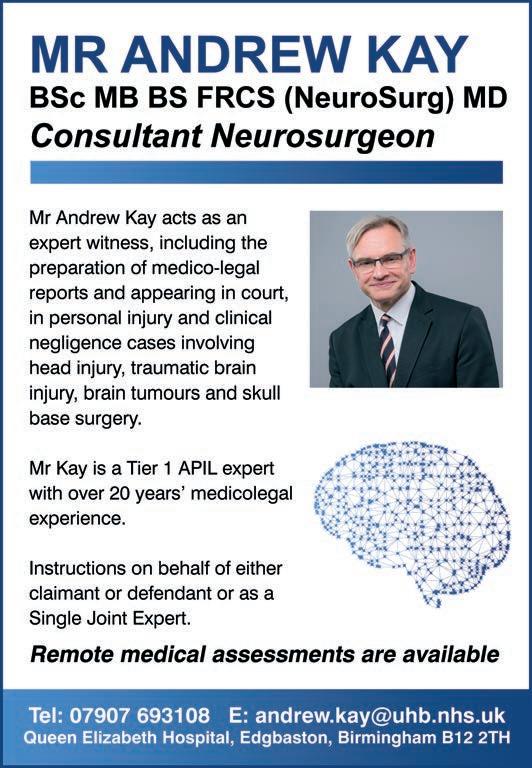
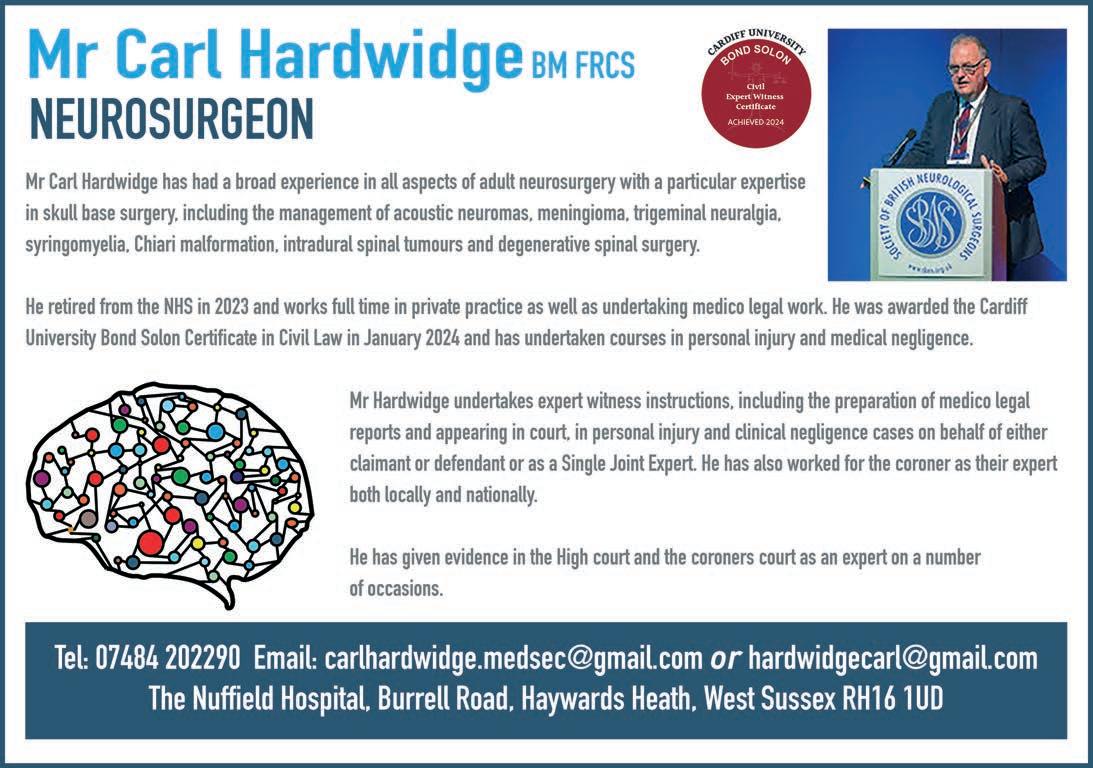
[A STUDY HAS BEEN PUBLISHED on a new method of molecularly diagnosing brain tumours that’s been developed by scientists at the University of Nottingham, along with clinicians at Nottingham University Hospitals NHS Trust (NUH). The results were published in Neuro-Oncology and reported by the Brain Tumour Charity.
The new ultra-rapid method will drastically reduce the time it takes to get an accurate molecular classification of a brain tumour. It’s hoped that reducing the time from 6-8 weeks after a biopsy to as little as two hours, will provide people with a more complete diagnosis and prognosis faster: as well as making sure they receive the optimal standard of care in a timely fashion.
The team at NUH utilised the new approach during 50 brain tumour surgeries to deliver a rapid diagnosis while the surgery was happening. That approach achieved a
100% success rate and provided diagnostic results in under two hours from the biopsy being taken.
While the results are extremely promising, it’s important to note that there are still some important steps that need to be taken before this kind of test becomes widely available.
What is a molecular diagnosis of a brain tumour and why is it important?
An MRI or CAT scan can identify that somebody has a brain tumour, as well as showing the size of the tumour and where in the brain it’s located. That information is usually enough for a healthcare team to understand whether somebody will need surgery to remove or debulk the tumour –called a craniotomy. However, there are still many answers they need before they fully understand the brain tumour and can make
suggestions about ongoing treatment and care. By taking a biopsy of the brain tumour –either as part of a craniotomy or as a separate procedure if a craniotomy isn’t needed – the team can diagnose the type of brain tumour and what grade it is.
With around 130 different types of brain tumour, that information is vital to understanding what treatment might be most effective and what somebody’s prognosis is likely to be. They can also perform genetic testing that reveals the exact classification of brain tumour somebody has.
Currently, these complex genetic tests have to be sent away to be analysed and it can take 6-8 weeks or more to get full results. It’s hoped that by reducing the length of time it takes to receive these results, people will get a more complete diagnosis faster and help ensure they receive the optimal standard of care in a timely fashion. q
[TWO SURGEONS at the Walton Centre in Liverpool have begun delivering endoscopic surgery for patients needing spinal cord implants.
The Walton Centre NHS Foundation Trust is the only hospital trust in the UK specialising in neurology, neurosurgery and pain services.
Although the majority of patients come from Merseyside, Cheshire, North Wales, Lancashire and the Isle of Man, for some specialist treatments of complex disorders the centre sees patients from all parts of the country, referred by their GPs or other neurologists, neurosurgeons and pain clinicians.
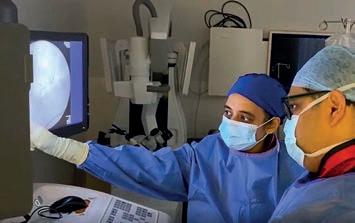
The two surgeons undertaking the groundbreaking procedures are consultant neurosurgeon Miss Deepti Bhargava and consultant orthopaedic surgeon Mr Narendra Rath.
Patients who qualify for the implant and procedure are benefiting from the minimally invasive surgery to reduce debilitating back pain. Small incisions allow the precise equipment to make paths for electrodes, which are placed near key areas of the spine relating to the patient’s pain. Once connected to an implanted battery pack, the current delivered disrupts the nerve signals, with the aim of reducing pain, in many cases, significantly.
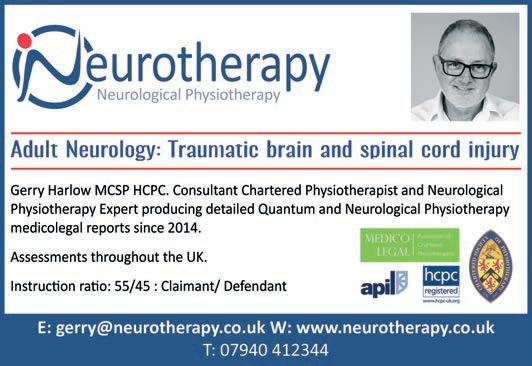
Miss Bhargava said: “Endoscopic surgery and implant surgery have been on offer to patients for a number of years. But to combine them in the way that we have has been revolutionary for this patient group. With the minimally invasive nature of the procedure, patients are able to heal quickly, and this means testing and then switching on the implant is quicker too.”
Mr Rath said: “Being established as a Centre of Excellence in endoscopic spinal surgery already, it was natural to expand the learned skillset across other subspecialities. Working with Miss Bhargava was an immense pleasure, and I am sure this will help more patients in the near future. I would like to thank The Walton Centre and RIWO Spine for their kind support in this project.”
Debbie Daniel, who underwent this procedure in March, said: “I was so glad when I got the all-clear to be able to have this procedure. My pain had steadily got worse, to the point where sleeping was becoming impossible. The surgery was successful, and I’ve healed really quickly because the wounds were small. Now the implant is turned on I would say my pain has reduced drastically and I’m so grateful!” q



[THE Royal College of Obstetricians and Gynaecologists (RCOG) has raised serious concerns around the National Police Chiefs’ Council’s Guidance on Child Death Investigation
RCOG president Dr Ranee Thakar said: “We are very alarmed by the increasing number of women being prosecuted for ending their own pregnancy, including women who have experienced the tragedy of an unexplained pregnancy loss being criminally investigated. This is not in the public best interest.
“The new National Police Chiefs’ Council guidance is truly shocking to read. Women in these circumstances have a right to compassionate care and to have their dignity and privacy respected; not to have their homes, phones, computers and health apps searched, or be arrested and interrogated.
“Parliamentarians now have an unmissable opportunity to decriminalise abortion, to ensure women can access abortion safely, confidentially and free from the threat of investigation and prosecution.”
Earlier the RCOG welcomed an amendment laid to the Crime and Policing Bill, which is currently making its way through Parliament. The amendment, laid in the name of Tonia Antoniazzi MP, would remove women from the criminal law related to abortion in England and Wales and ensure that they are no longer subject to years-long investigation, criminal charges and custodial sentences for ending their own pregnancy.
Ms Antoniazzi said: “There is simply no world in which prosecuting a vulnerable woman who may have experienced a medical complication, miscarriage or stillbirth is the right course of action. I am confident that, when Parliament has the opportunity to vote on these proposals, my colleagues will agree that never again should a woman be prosecuted for ending her own pregnancy in England and Wales.”
Dr Thakar commented: “Abortion law in England and Wales is the oldest healthcare law in existence and means that a woman can be prosecuted for ending her own pregnancy.
“Abortion that happens outside of the current law generally involves very vulnerable women – including those facing domestic abuse, mental health challenges or barriers to accessing NHS care. Yet alarmingly, prosecutions of women have been increasing in recent years.
“Abortion is an essential form of healthcare and should be subject to regulatory and professional standards like other medical procedures, not criminal sanctions.
“Parliamentarians now have an unmissable opportunity to decriminalise abortion, to ensure women can access abortion safely, confidentially and free from the threat of investigation and prosecution.
“We urge MPs to support this amendment to ensure that women and girls in England and Wales will have the same protections as their counterparts in countries such as Northern Ireland, France, Canada, Australia and New Zealand.”
The developments follow a long-running campaign by both the RCOG and major abortion service providers such as the British Pregnancy Advisory Group, National Unplanned Pregnancy Advisory Service and MSI abortion services. Records show that at least 100 women have been investigated for having an abortion in the last five years. Of those, six have appeared in court.
They include Nicola Packer, who made headlines when she was acquitted on 8 May of ‘unlawfully administering to herself a poison or other noxious thing’ with the ‘intent to procure a miscarriage’. q
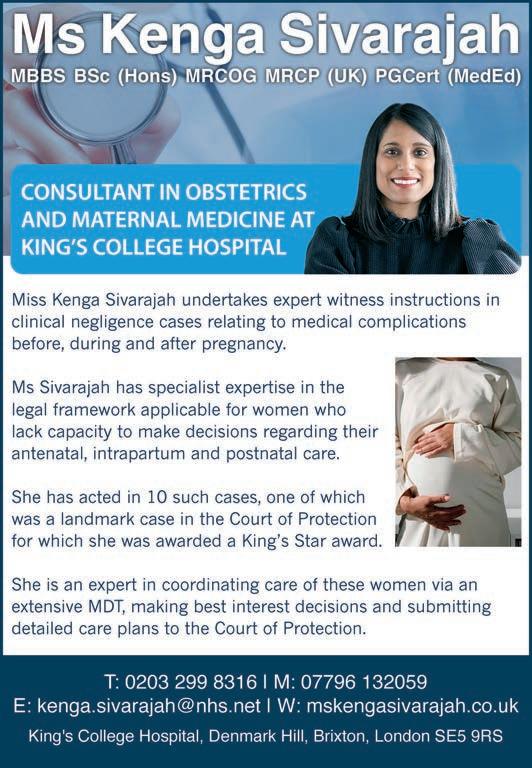
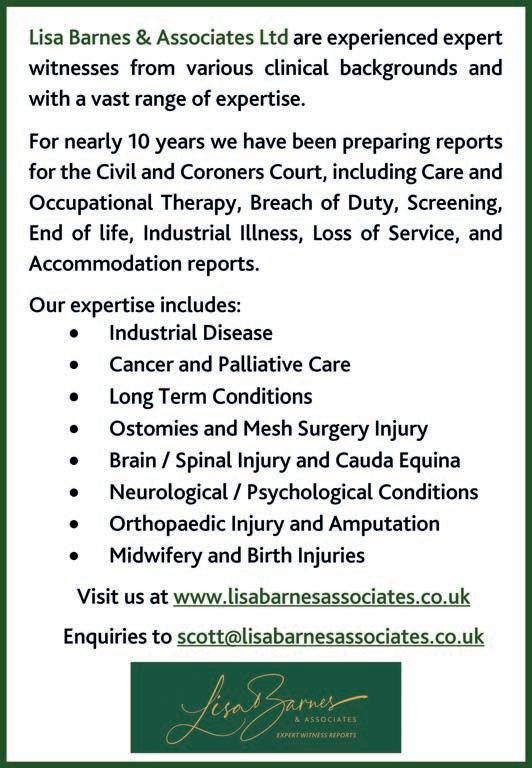

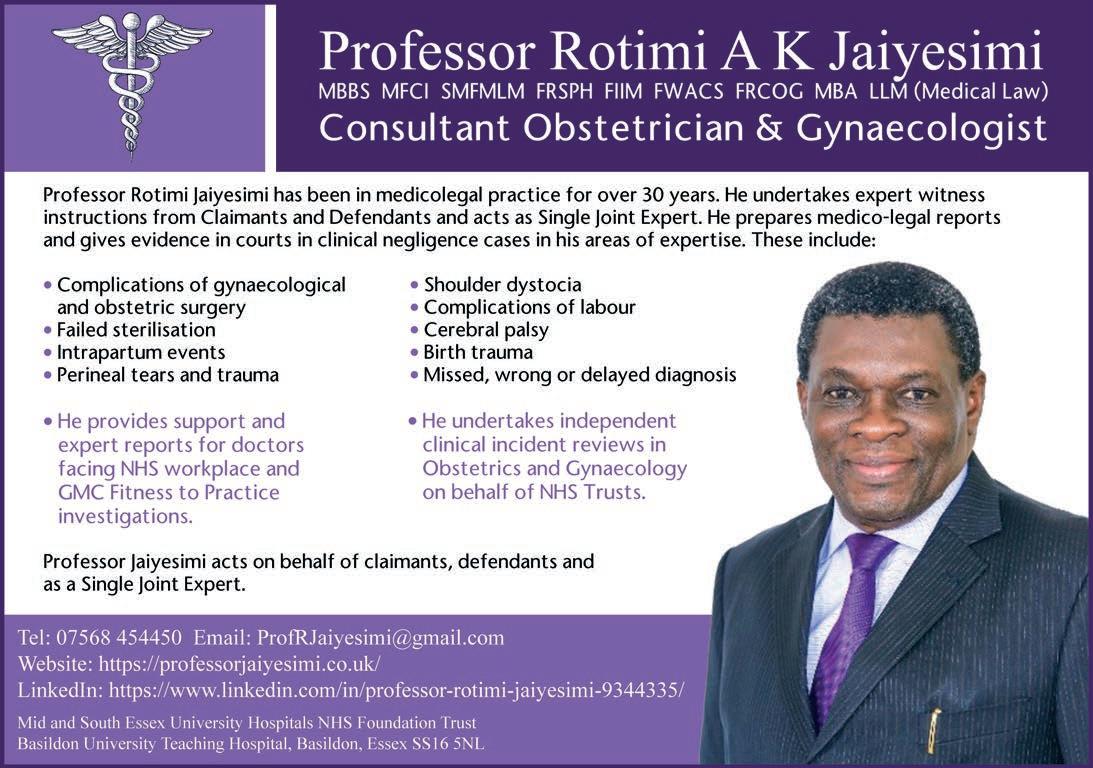
[FOLLOWING THE SUCCESSFUL pilot of the Avoiding Brain Injury in Childbirth (ABC) programme, a national roll-out is planned for September. The programme was delivered by the Royal College of Obstetricians and Gynaecologists, the Royal College of Midwives (RCM) and The Healthcare Improvement Studies Institute at the University of Cambridge.
Avoidable brain injury acquired during labour (intrapartum care) can have devastating consequences for babies and their families, along with significant lifetime costs for health and care services – including clinical negligence costs.
Developed and piloted over three phases spanning 2021-25, the ABC programme is designed to reduce the risks associated with two key contributors to avoidable brain injury: managing impacted foetal head at caesarean birth and recognising and responding to the baby who may be deteriorating during labour.
Organised into two modules to address those two significant contributors, ABC offers clear clinical practice standards with supporting resources, including high-quality training. A cascade model, where clinical champions from maternity units are trained to train their local teams, was successfully used to spread good practice. The programme was co-designed with both service users and maternity professionals to support best care, including communicating effectively and respectfully with the person in labour and their birth partner.
Involving women, birthing people and birth partners has been a defining feature of the ABC programme. For the pilot, a specially established Maternity Patient and Public Involvement panel participated and fed into programme tools, resources and training. Their contributions were invaluable

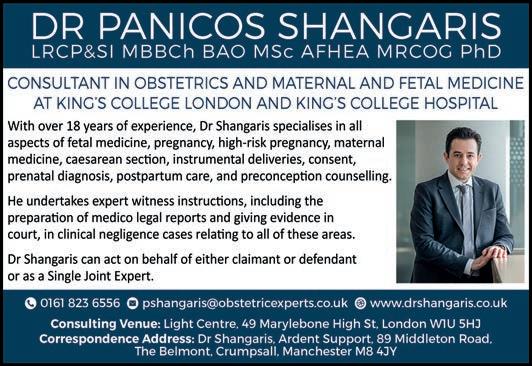
in ensuring the priorities of maternity service users remain paramount.
Commenting, the RCM’s chief executive Gill Walton said: “The ABC programme has the potential to reduce the devastating impact of brain injuries during childbirth and the RCM is proud to have been part of this innovative programme and we hope to see this adopted and implemented across maternity services.”
For the ABC module on impacted foetal head at caesarean birth, six maternity units participated in ‘train-the-trainer’ events. Participants learned about the evidence base for the different techniques and practised them using specially designed manikins, with a strong focus on team working and communicating with women and birth partners. Clinical champions from those units then trained their colleagues locally, meaning that dozens of staff were trained in under three months.
The ABC module on recognising and responding to suspected foetal deterioration operationalises current national guidance to integrate a range of intrapartum risk factors into a single standardised approach, so that decision-making and action are supported more effectively – including a new tool and a strong emphasis on teamwork and communication with those in labour.
Professor Mary Dixon-Woods, director of The Healthcare Improvement Studies Institute, said: “The ABC programme design is based on the principle that evidence-based, co-designed patient-focused standardisation of clinical practice can reduce unwarranted variation and improve care and outcomes. The pilot has shown that it’s possible to train people effectively and efficiently. A national commitment to implement the programme at scale will be important in ensuring that the benefits are seen.” q
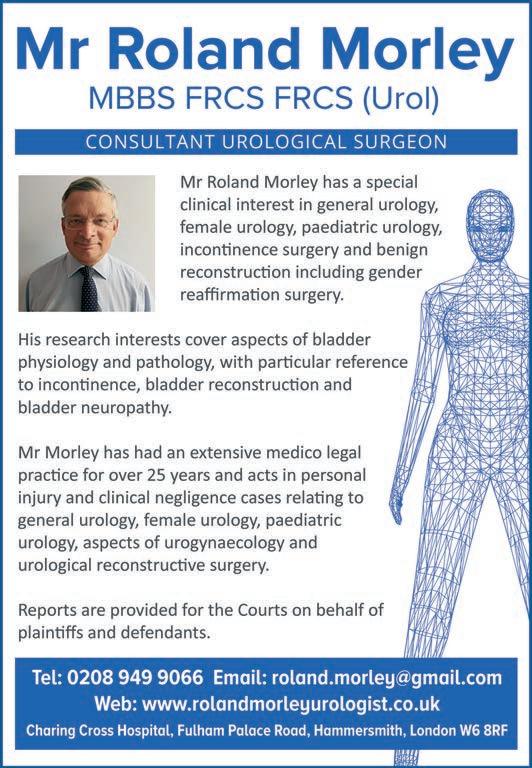
By Philip Coleridge Smith DM MA BCh FRCS, Consultant Vascular Surgeon, Medical Director of the British Vein Institute and Emeritus Reader in Surgery at UCL Medical School
[ THE NERVOUS SYSTEM controls all aspects of function of the body, including conscious movements and perception of sensation, as well as unconscious functions such as maintenance of blood pressure and body temperature. The nervous system has an extensive and diverse blood supply, emphasising the need for this type of tissue to receive an adequate blood flow without interruption
The blood supply is delivered from numerous sources so that, when arteries in one region are diseased or damaged by injury, blood flow continues to flow. However, in some vascular surgical interventions and conditions, blood flow is interrupted and neurological complications arise.
The brain is supplied via the carotid arteries in the neck, as well as from the vertebral arteries, which are branches of the subclavian arteries to the arm. The vertebral arteries pass via the transverse processes of the cervical vertebrae to supply the posterior part of the brain and the brain stem. All the arteries to the brain join a circular arterial system at the base of the brain known as the Circle of Willis. That gives significant redundancy to the arterial supply, which provides alternative routes of blood flow when one or more arteries become blocked though disease or injury.
Problems may arise when a blood clot forms in the arterial system in a diseased or injured vessel. Patients with atheromatous disease of the carotid arteries (eg from smoking) get narrowing of the arteries. Thrombus may form in the narrowed regions and then travel as emboli to the brain, blocking blood flow to a region and giving rise to a stroke. The risks of that can be mitigated by medical treatment, such as blood pressure reduction or antiplatelet drugs, and by arterial surgery in more severe cases.
Patients who suffer direct injury to the neck arteries, for example in road traffic collisions, may be at risk of forming thrombus in the damaged sections of arteries. That can embolise to the brain leading to stroke. The risks of that can be mitigated by treatment with antiplatelet drugs such as aspirin. The risk is greatest in the first week or two after injury. Once the artery heals after several weeks or months, the risk is abolished and aspirin treatment can be discontinued. Failure of physicians managing the problem to appreciate and diminish the risk of stroke could be considered to comprise substandard care should a stroke arise.
The nervous system supplies much of the body via the spinal cord. This structure runs from the brain stem at the base of the brain as far as the upper lumbar vertebrae. It receives a blood supply from the segmental arteries of the thoracic and abdominal aorta, which emerge at each thoracic and lumbar segment. The spinal cord is also equipped with a longitudinal network of arteries which fill at each segment from the aortic branches, thus providing a robust blood supply in the event of injury or disease.

angiogram of an
I have come across cases in which unintended insertion of venous catheters into the carotid and subclavian arteries has caused blocked arteries in the brain. Thrombus may form on catheters accidently placed in arteries, resulting in a blood clot detaching and embolising to the brain, leading to stroke.
However, in modern vascular surgery the need to treat aneurysms of the thoracic and abdominal aorta results in the replacement of the aorta with sections of vascular prosthetic tube. Those do not have branches at each segment and blood flow to the spinal cord is limited in those operations. Usually, the spinal cord vascular system is able to compensate for the loss of flow into the network supplying it, and normal neurological function continues. However, loss of blood flow to the spinal cord giving rise to paraplegia is a recognised adverse event arising from open or endovascular surgery to the thoracic and lumbar aorta. Patients undergoing life-saving surgery to the aorta should be informed that paraplegia is a potential risk of this treatment. In the lumbar region, the spinal cord is replaced by the ‘cauda equina’, a large collection of nerves which have left the spinal cord. These pass into the lumbosacral plexus of nerves. The lumbar plexus lies within muscles of the back of the abdominal wall, with a blood flow derived from the lumbar segmental arteries from the aorta. In the pelvis the sacral part of this plexus forms the sciatic and obturator nerves to the thigh and calf. Blood flow here comes from the internal iliac arteries in the pelvis. In patients with a smoking history the aorta and iliac arteries may become narrowed and blocked (pictured). Patients with a tendency to aneurysm formation may develop aneurysms affecting the abdominal aorta or iliac arteries. Both types of arterial disease may necessitate surgery to the aorta and iliac arteries, which potentially impairs blood flow to the nerves in the lumbar and sacral regions.
That is a recognised adverse event arising from treatment of blocked or dilated arteries of the abdominal aorta and iliac arteries. Patients undergoing surgical intervention for that type of arterial disease should be made aware of the potential for neurological damage leading to paralysis and loss of sensation in the legs.
I have advised in cases where sudden occlusion of the diseased abdominal aorta and iliac arteries has led to diagnostic difficulty. Sudden loss of the blood supply to the nerves of the lumbosacral plexus led to loss of sensation in the lower limbs as well as paralysis of the legs. Usually the loss of blood supply to the legs would lead to the onset of severe pain, but the loss of sensation in the legs prevented
pain being felt. The treating clinicians failed to palpate the pulses of the lower limbs, so failed to detect the absence of blood flow. Instead, they concluded that the problem was confined to the neurological system. Delayed diagnosis led to severe ischaemic damage to the lower limbs, necessitating bilateral amputations in one case once it was appreciated that limb ischaemia was the cause of the limb paralysis.
Paralysis of an ischaemic limb is a classical symptom of limb ischaemia and therefore any clinician managing a patient presenting with loss of function in a limb or both lower limbs should carefully check the pulses in the limbs.
Recovery from neurological ischaemia where it affects the nerves in the limb, those in the plexus which supplies the limb or the spinal cord may be complicated by neuropathic pain which starts during the recovery phase. The nerves become damaged during the period of ischaemia and some recovery is achieved once blood flow is restored. Permanent painful sensations may result.
Successful vascular surgery will restore blood flow to the affected limbs, leading to avoidance of severe ischaemic damage. However, current surgical techniques are unable to restore blood flow to the spinal cord or lumbosacral plexus. As a result, patients suffering ischaemia of those regions may suffer long-lasting neuropathic pain even when ischaemic damage to the lower limbs has been avoided. Claimant’s should avoid overestimating the extent to which neuropathic pain could have been avoided by emergency vascular or endovascular treatment to restore blood flow to the lower limbs.
The maintenance of good blood flow to the nervous system is important to maintenance of its function. Vascular conditions presenting with neurological symptoms should be dealt with expediently in order to limit the extent of neurological injury. Blood supply to the spinal cord and the nerves in the legs is derived from the aorta, which may be affected by aneurysms and occlusive arterial disease. Treatment of those conditions may give rise to unintended but unavoidable ischaemia affecting the spinal cord and nerves to the legs. q


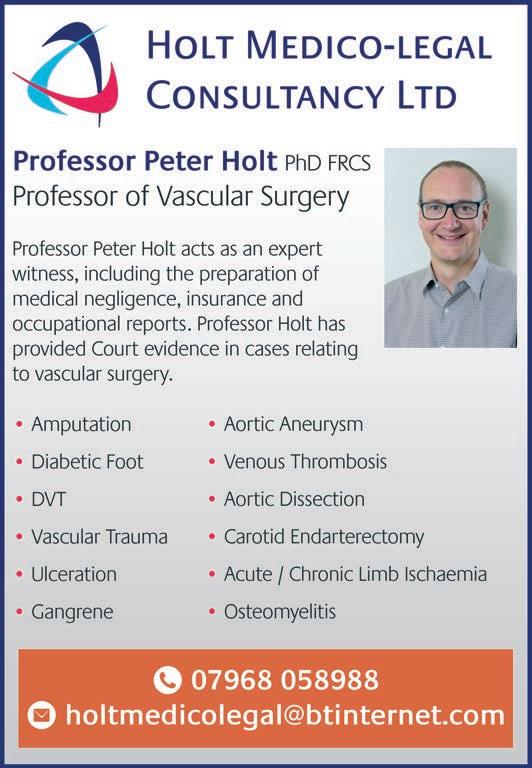
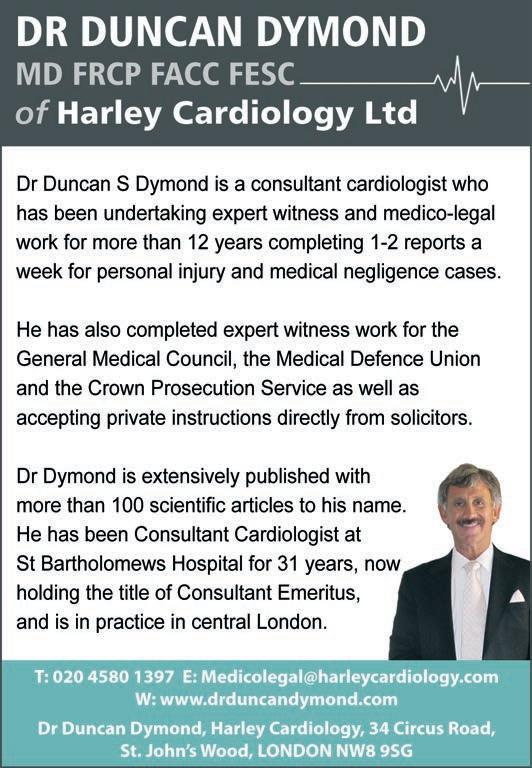
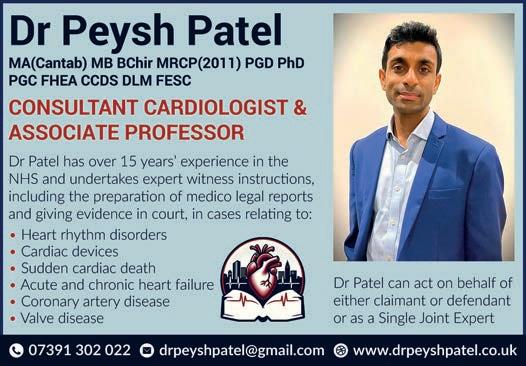
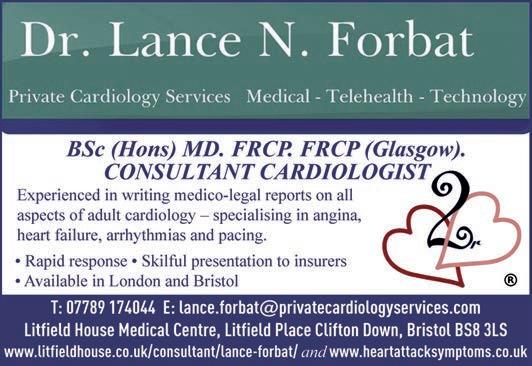
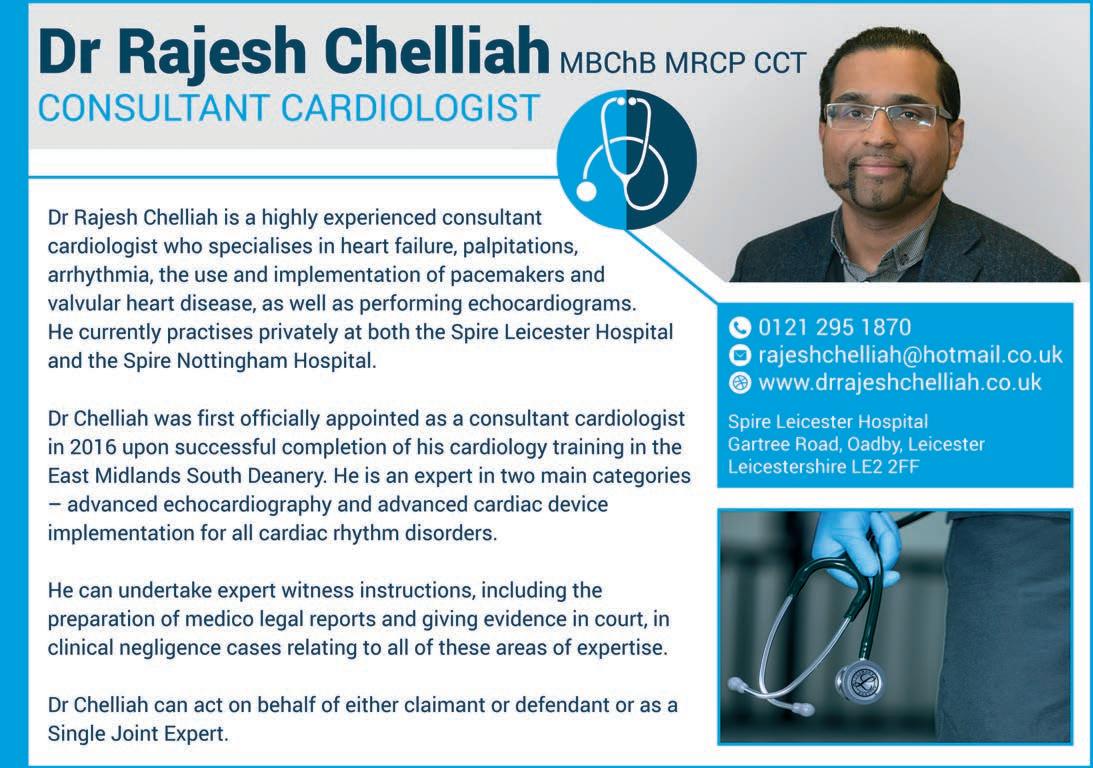
[ A RECENT BBC NEWS REPORT
has brought to light very serious concerns regarding the cardiology services provided at Castle Hill Hospital (CHH) in East Yorkshire. The article reveals that Humberside Police have launched an investigation into the care provided by the hospital’s cardiology department following numerous complaints and allegations of substandard treatment.
The concerns relate to treatment provided to patients during a TAVI – transcatheter aortic valve implant –procedure. TAVI is a procedure to replace a damaged valve in the heart, similar to adding a stent. The procedures are meant to be safer alternatives to open-heart surgery, especially for older patients.
The mortality rate at CHH was three times higher than the national average. Staff at the hospital were so concerned that several formal inquiries into standards were commissioned, but patients were not made aware that these inquiries were happening.
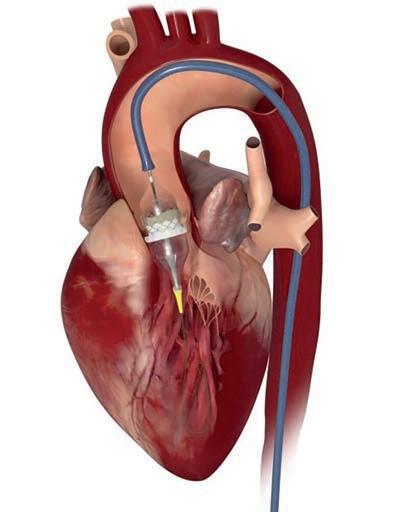
Reporting on the affair, Carolle White, legal director and chartered legal executive at law firm Nelsons, outlined some of the key problems found.
• Avoidable mistakes: some patients suffered serious
• complications that could have been prevented.
• Wrong information on Death Certificates: in several cases the
• official cause of death didn’t mention the failed procedures.
• Families left in the dark: relatives of the patients weren’t told
• what happened during the operations until the BBC contacted
• them. That is extremely concerning given the duty of candour
• that is supposed to promote a culture of openness and
• transparency.
She related a number of real-life cases:
Dorothy Readhead was 87 when she underwent her procedure, which has been graded as poor in one of the inquiries completed into standards. She was due to have the TAVI deployed via an artery in the left leg because the right leg artery was blocked. Instead, the right leg was used, and although the error was realised a decision was made to continue.
Repeated efforts were made to deploy the TAVI through the blocked artery, resulting in a significant tear in Mrs Readhead’s femoral artery. She lost a lot of huge amount of blood and died a week later. Worryingly, the cause of her death was recorded as pneumonia on her Death Certificate. The Royal College of Physicians (RCP) found that the TAVI procedure should have been recorded on the death certificate as it led to Mrs Readhead’s death.
Brian Hunter was 83 when his TAVI was finally performed after the procedure was delayed, increasing the risk of an adverse outcome. When it was performed, it was carried out in a way that was graded as very poor by the RCP. Technical errors were made along with failures in the deployment of the device, which allowed blood to leak back into the heart. His family were told that Mr Hunter had died of a heart attack, and they only learned the truth years later.
When Dr Thanjavur Bragadeesh raised concerns about the TAVI procedure in 2020, he was asked to step down from his role
as clinical director of CHH’s cardiology department. Other senior doctors have raised concerns over many years.
Ms White commented: “The investigation reportedly centres around potentially avoidable patient deaths and harm linked to cardiac procedures and care. While details remain limited due to the on-going nature of the inquiry, the fact that law enforcement is involved underscores the gravity of the concerns raised.
“This development is deeply concerning; not only for the families already affected, but also for any patients who may have undergone cardiac procedures at Castle Hill Hospital and are now questioning the quality of their care.”
Nelsons is urging anyone who has, or knows someone who has, received cardiology treatment at Castle Hill Hospital and experienced complications, unexpected outcomes or concerns about the care provided to seek advice. They may not be alone and their experience could be part of a broader pattern now under investigation. q
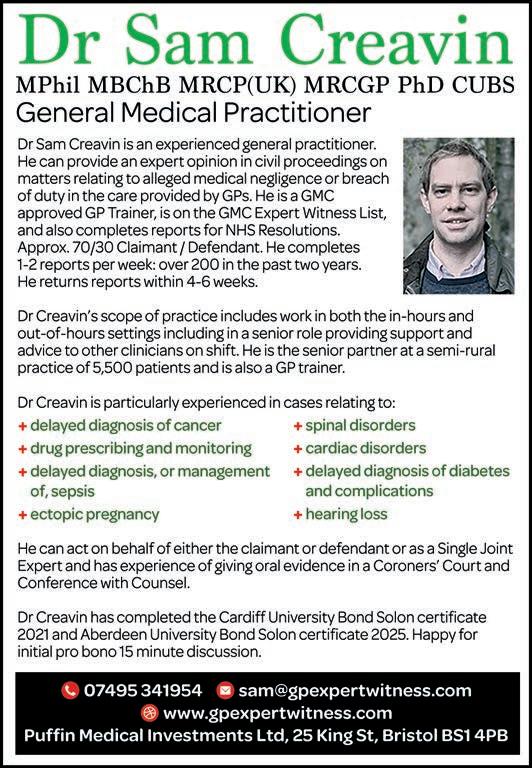
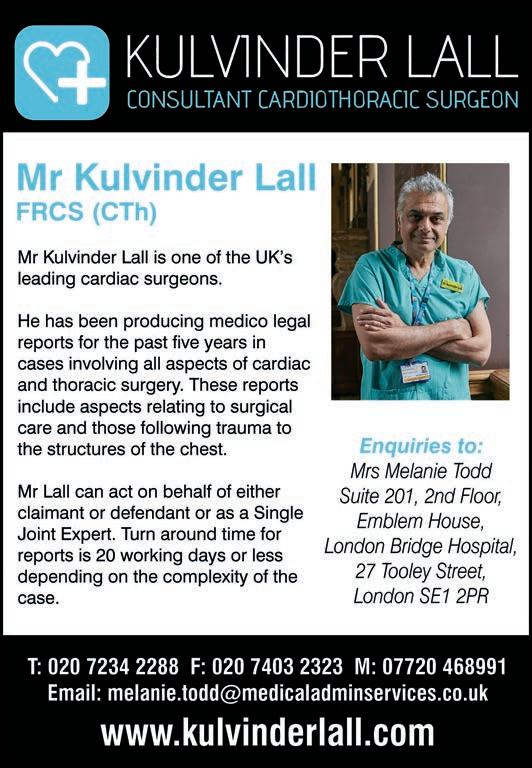
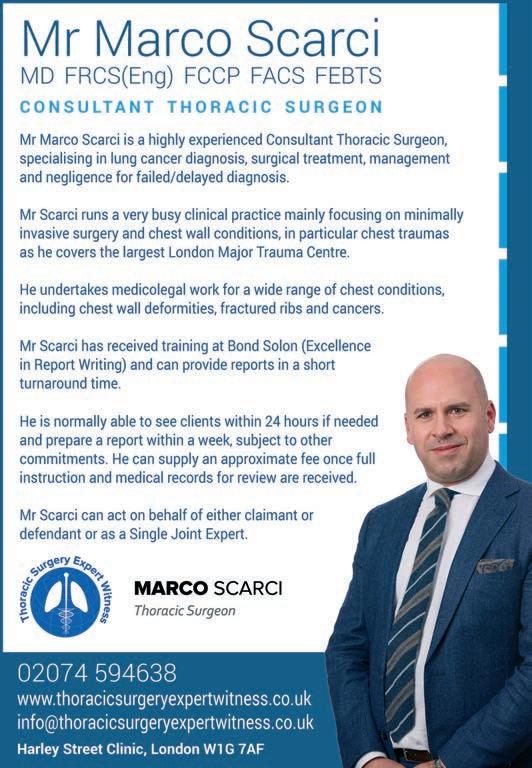

[A CORONER has concluded that doctors missed opportunities to identify the rare heart condition which caused the death of one-year-old Archie Squire from Dover, Kent.
Archie was born on 20 November 2022 and died on 23 November 2023 at Queen Elizabeth the Queen Mother (QEQM) Hospital in Margate – just days after his first birthday. Recording a narrative conclusion, Kent North East Area Coroner Sarah Clarke said Archie died from heart failure and congenitally corrected transposition of the great arteries (ccTGA). ccTGA, is a rare heart defect in which the heart's ventricles and great arteries are reversed.
Records show that Archie was seen by frontline medical staff no fewer than 16 times across his life, including nine trips to the QEQM accident and emergency department. He was never given an echocardiogram, an ultrasound scan which can diagnose ccTGA.
The coroner concluded that earlier recognition and diagnosis of Archie's heart condition would almost certainly have meant he would not have died when he did. She is now considering whether to issue a Prevention of Future Deaths report and gave East Kent Hospitals University NHS Foundation Trust two weeks to provide documents, including new standard operating procedures regarding on-going referrals and triaging.
Between written and oral evidence, Archie’s inquest considered evidence from 27 witnesses across eight days. It began on 19 May and concluded on 30 May.
Following the conclusion, Archie’s parents Jake Squire and Lauren Parish read a statement on behalf of the family. Mr Squire said: “It has been incredibly difficult to sit and listen to the evidence over the last couple of weeks. Archie was a happy baby, but he was not a well baby and me and Lauren did all that we could during his short life to seek help for him. We trusted the doctors and nurses who cared for him to take our concerns seriously and to find out what was wrong.
“To learn after his death that he had such a serious problem with his heart that had not been diagnosed, despite the number of times we took him to hospital, was heartbreaking.
“As well as the traumatic events of the night Archie died, and the unimaginable grief of losing our baby boy, we now also have to live with a devastating reality: the doctors we trusted to care for Archie missed opportunities to diagnose the heart condition that took him from us just days after his first birthday. Had the scan needed of his heart been carried out, and his condition diagnosed, Archie almost certainly would not have died when he did.
“After listening to the evidence, we do not feel reassured that a baby going through heart failure, in the same way Archie had for months, would be correctly diagnosed.
“We are very concerned that medical staff will continue to diagnose babies like Archie with chest infections or bronchiolitis simply because they are more common than heart failure. We are left feeling that we cannot put our trust in clinicians and would urge all parents of young babies to trust their instincts and to speak up for those children who do not have a voice for themselves.”
Lily Hedgman, a solicitor from the medical negligence team at Leigh Day said: "Lauren, Jake and the rest of Archie’s family have shown incredible courage as they have navigated this difficult process. I remain entirely in awe of the strength and resilience they have shown in the face of the harrowing evidence we have listened to over the last couple of weeks.
"The coroner’s findings of fact were very clear: Archie died of a rare heart condition and had been in heart failure for months before his death. In those months, he had been seen on many occasions by various clinicians, while exhibiting signs and symptoms of heart failure; and yet this was never diagnosed. Had it been diagnosed by an echocardiogram, he almost certainly would not have died when he did.
“Despite their unimaginable grief, Archie’s family have been motivated through this process by a selfless goal of trying to prevent another family having to endure what they have been through. Lessons must be learned from Archie’s all-too-short life.
"We hope that going forward clinicians will take all the necessary steps to exclude a cardiac cause when babies repeatedly present with the same symptoms as Archie.” q
[THE HEART CARE WAITING LIST rose in March 2025, latest figures from NHS England show. The figures, reported by the British Heart Foundation (BHF), show there were 425,372 people waiting for ‘routine’ cardiac care in England: up from 421,683 in February. The list has nearly doubled since March 2021, when it stood at 216,978.
There was a slight fall in the number of people waiting 18 weeks or more: from 166,381 in February to 165,558 in March. The proportion of people on the list who have been waiting that long for what is time-sensitive cardiac care remains at 39%. There was also a slight fall in the number of people waiting over a year for cardiac care: to 8,028 in March, down from 8,342 in February. In February 2020, there were just 28 people waiting that long. The longer people wait for treatment, the higher their risk of becoming disabled from heart failure or dying prematurely.

category 2 calls – which includes suspected heart attacks and strokes – was an average of 18 minutes. However, the target was relaxed due to growing pressure on the NHS, not a change in clinical urgency.
Dr Sonya Babu-Narayan, clinical director of the BHF and a consultant cardiologist, said: “Despite progress to reduce waiting lists for other NHS treatment and care, the tide is not turning when it comes to cardiovascular disease.
“Nearly four out of 10 people are waiting more than 18 weeks which is too long when it comes to heart conditions, where timely care is critical. Long delays at this scale put people at risk of living in ill health or being unable to work due to avoidable heart failure or having their lives cut short.
Average ambulance response time for heart attacks and strokes was 28 minutes in April 2025: down from 29 minutes in March, the data reveals. The current NHS England average response target for category 2 calls is 30 minutes for 2025/26. Before the pandemic, the response target for
“But it does not have to be this way. Something can be done. Heart patients need to see a National Cardiovascular Disease Plan to make emergency treatment and planned heart care fit for the future, and stop more people from getting heart disease in the first place. More funding of science and technology will enable scientific breakthroughs to better diagnose, treat or prevent cardiovascular disease.” q
[THE FACULTY OF PAIN MEDICINE, together with the Safe Anaesthesia Liaison Group, the Centre for Perioperative Care and the Royal College of Anaesthetists (RCoA) have expressed themselves keen to ensure that anaesthetists and pain medicine specialists are aware that prolonged release opioids are no longer licensed for the treatment of post operative pain. That reflects the Association of Anaesthetists’ guidelines on management of perioperative pain, issued in September 2024, and a drug safety alert issued by the Medicines and Healthcare products Regulatory Agency (MHRA) in March 2025.
The use of those medications is associated with an increased risk of persistent post-operative opioid use (PPOU) and opioid induced ventilatory impairment (OIVI). The four bodies sent a letter in August 2023 signed by internationally respected experts in the field to Dr Alison Cave, chief safety officer at the MHRA.
In the letter, they requested that the MHRA strengthen warnings around the use of modified-release opioids following strong international evidence against their use in managing acute pain.
In May this year they stated: “We therefore welcome the development of the drug safety alert and the accompanying public assessment report, published in March 2025 on this topic.”
In part the drug safety update reads: “Pain following surgery is usually short-lived, lasting between 5-7 days and therefore should only require short-term pain management best treated with immediate release opioids. However, many patients are discharged from hospitals with excessive amounts of opioids to meet their needs for acute postoperative pain management. This excess supply of opioids increases the risk of developing PPOU, dependence, addiction, or could lead to opioid diversion, and an increased risk of OIVI with unmanaged use.
“Therefore, patients should only be provided with a prescription for a sufficient amount of instant release opioids to manage their acute
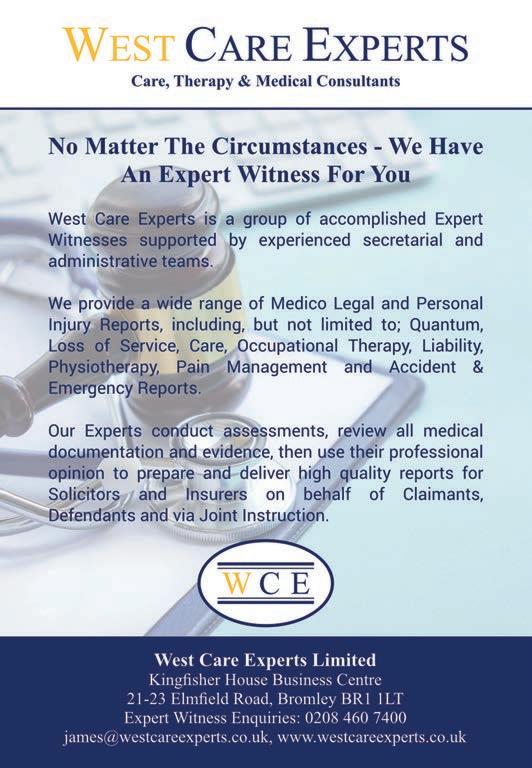
post-operative pain on discharge from hospital.
“Following the conclusion of a safety review undertaken by the MHRA, and advice from the Commission on Human Medicines, the indication for the treatment of post-operative pain will be removed from the licences of prolonged release morphine and prolonged release oxycodone.
“The remaining prolonged release opioids are not recommended for acute post-operative pain relief and may already not be indicated for acute use or are contraindicated in acute pain relief.”
In the case of those at increased risk: “Patients and healthcare professionals are encouraged to discuss treatment regimens and agree a post-operative pain management plan prior to the proposed surgical procedure.” q
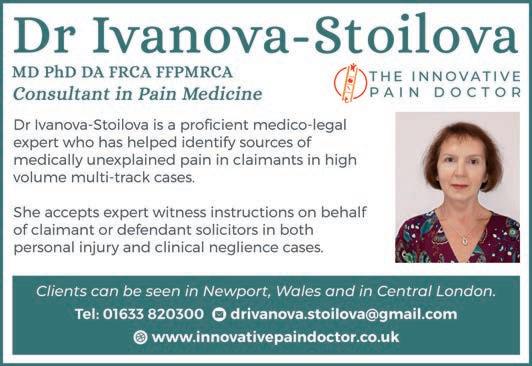
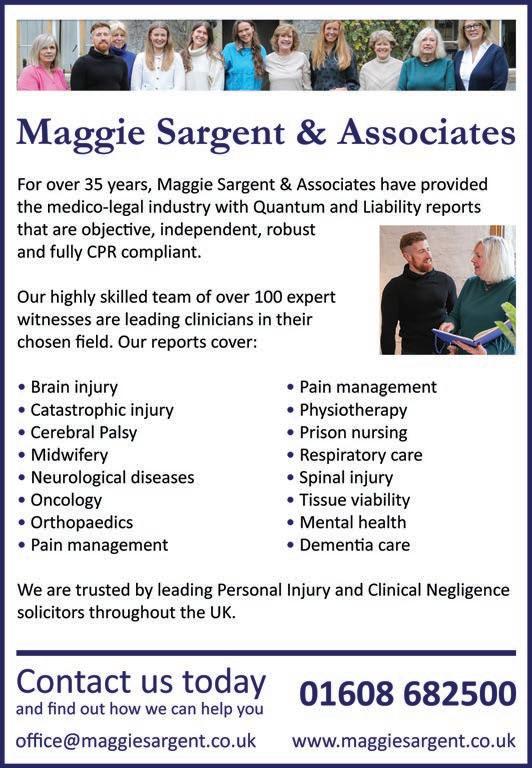
ACCIDENT & EMERGENCY MEDICINE
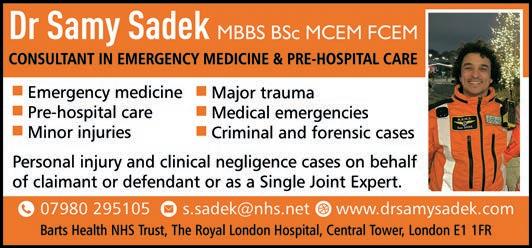
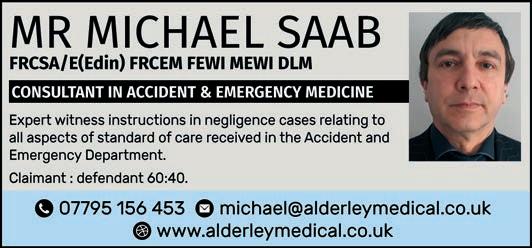

CARDIOLOGISTS & CARDIOTHORACIC SURGEONS
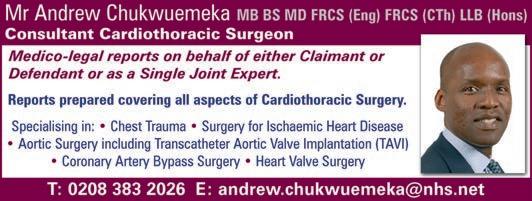
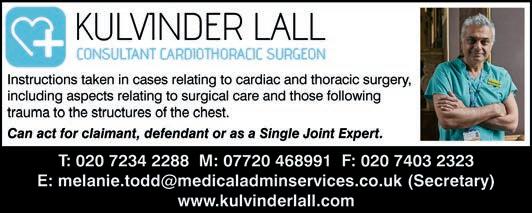

DENTAL & ORTHODONTIC EXPERTS
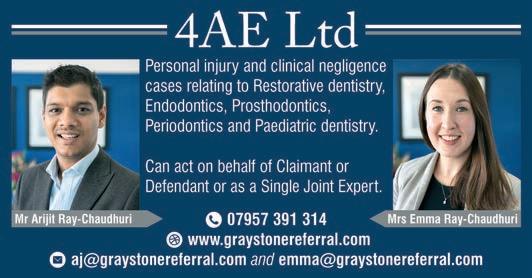
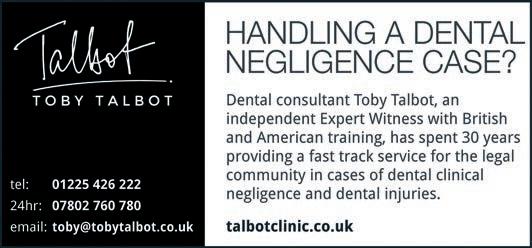

ENDOCRINOLOGY

ENT CONSULTANTS
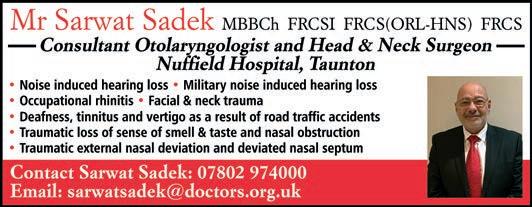

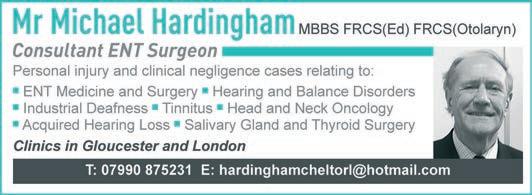
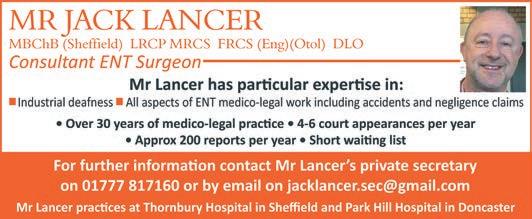

GASTROINTESTINAL & COLORECTAL SURGEONS
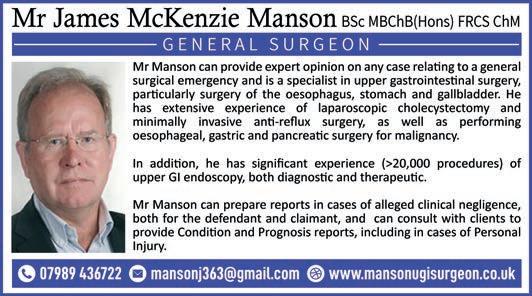
GENERAL SURGEONS



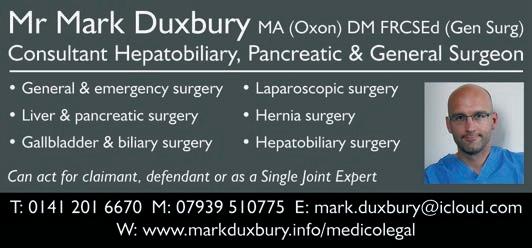
HAEMATOLOGY
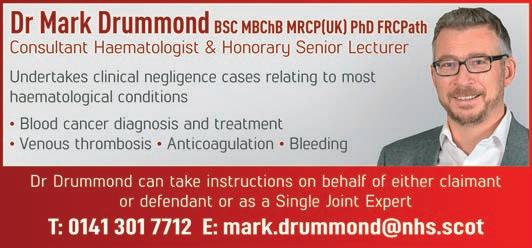
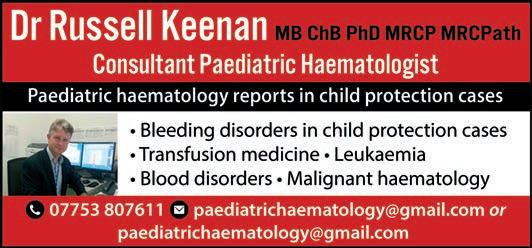
MEDICAL NEGLIGENCE
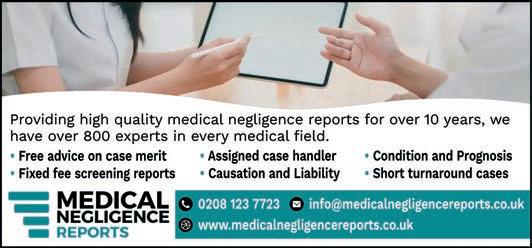

NEONATAL MEDICINE
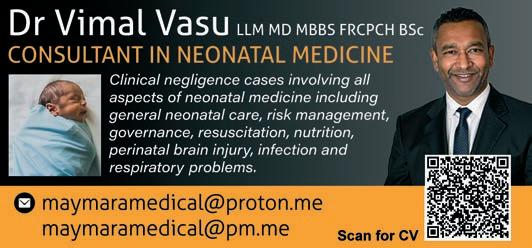
NEUROLOGY
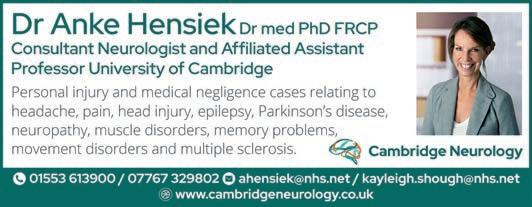
NEUROSURGEONS



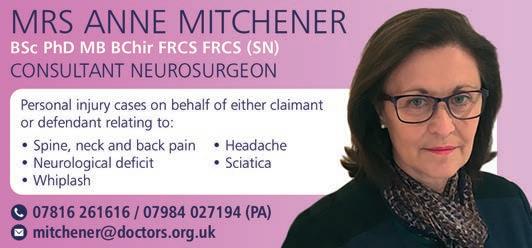


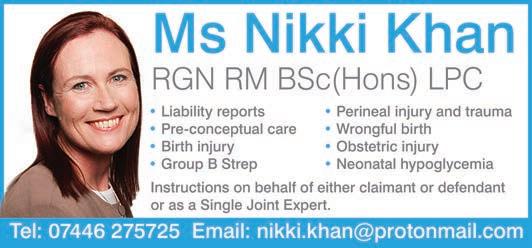
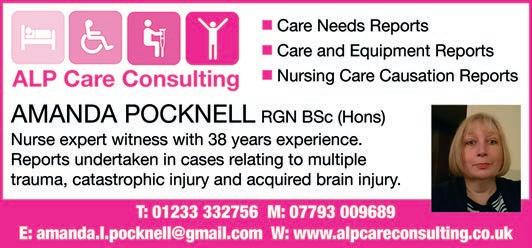


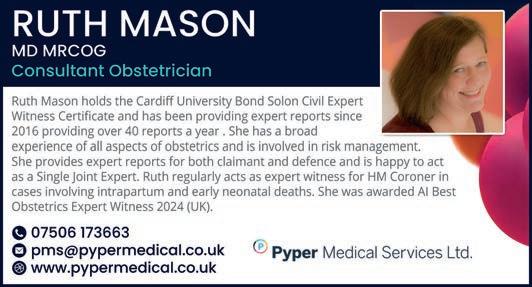




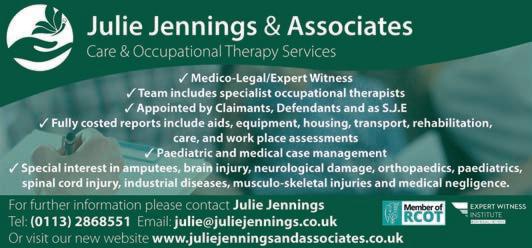
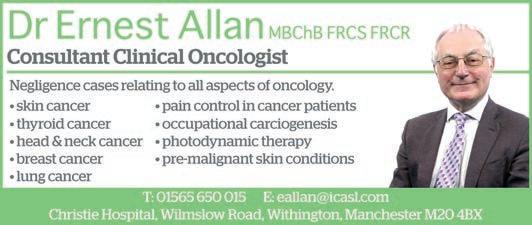
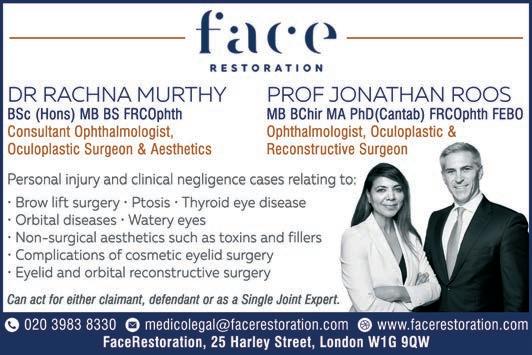

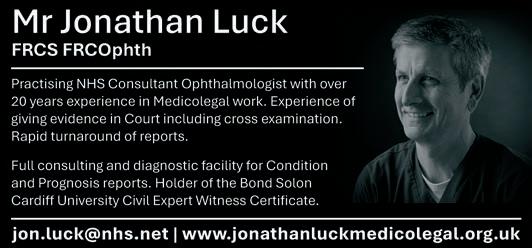



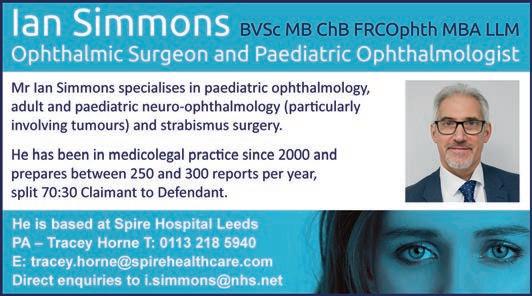

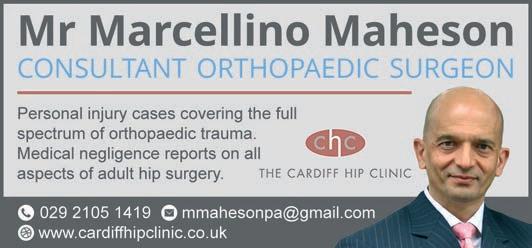


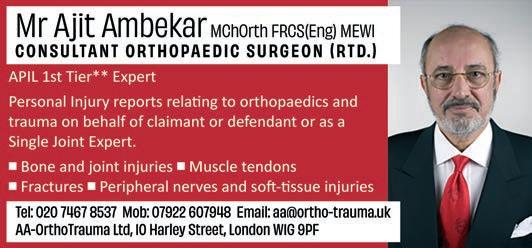
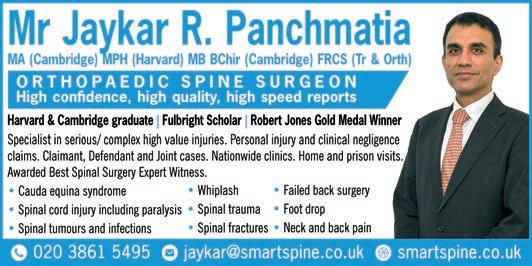
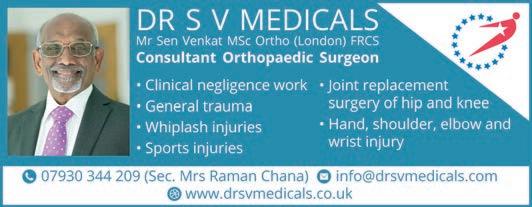








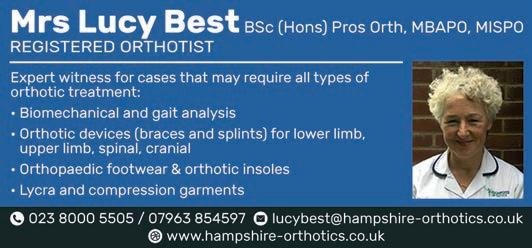
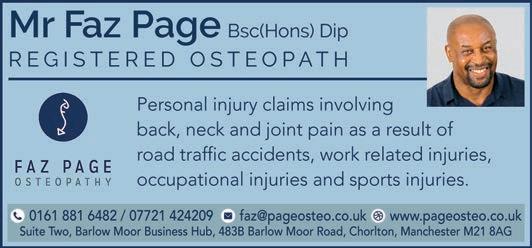


PHYSICIANS

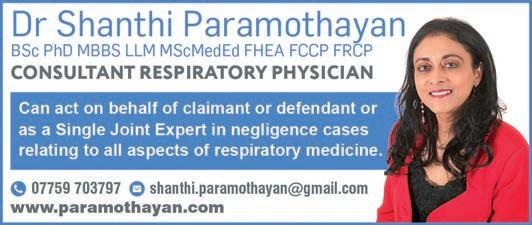




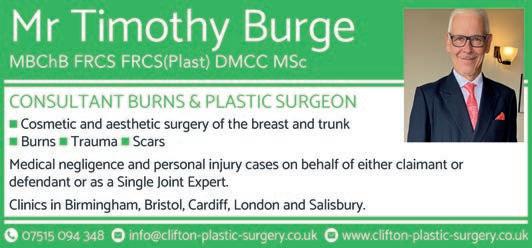
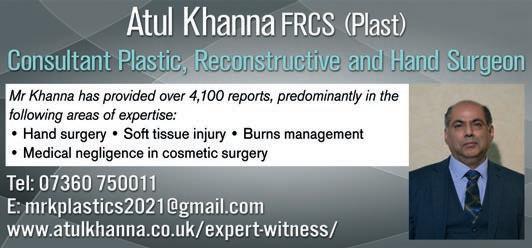





PSYCHOLOGISTS
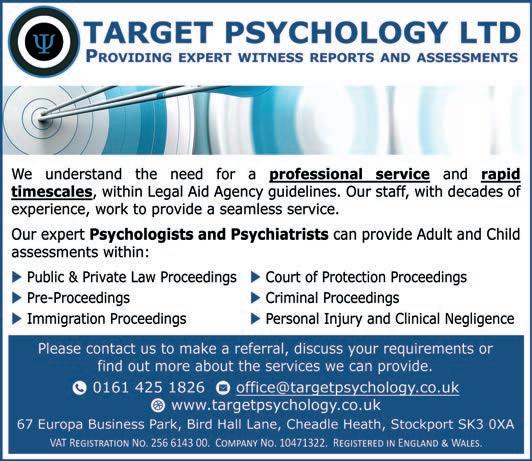
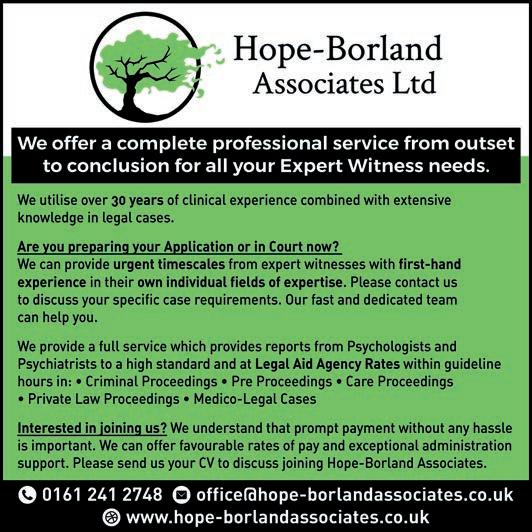


RADIOLOGISTS
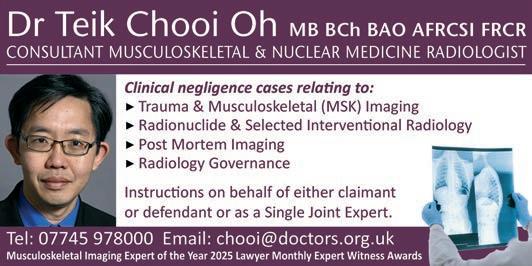

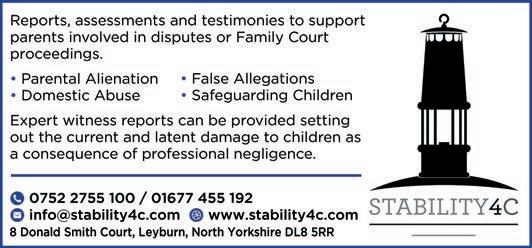
SKIN CAMOUFLAGE CONSULTANTS

SPEECH & LANGUAGE THERAPY
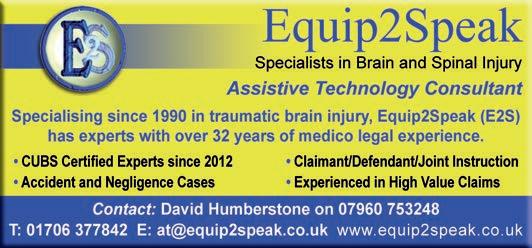


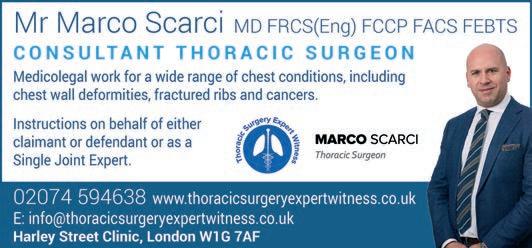

TRICHOLOGISTS
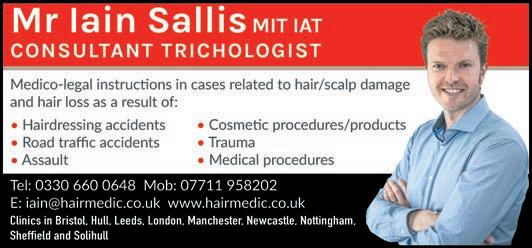
TOXICOLOGY

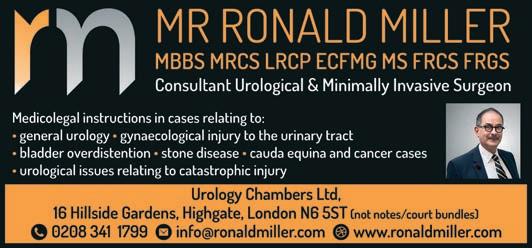

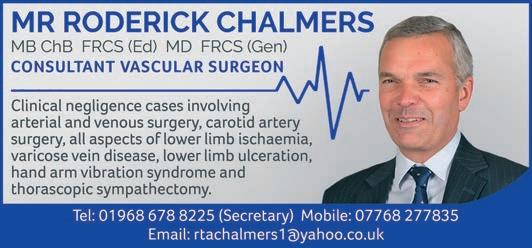
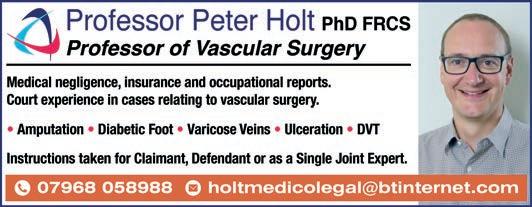



EXPERTS FOR MEDIA is a regular section in Your Expert Witness for experts who wish to offer their views and the benefit of their experience to the vast range of print and broadcast media.
Ever wondered how news teams find the experts they consult to explain the ramifications of breaking news stories, seemingly at the drop of a hat? Or how the producers of TV drama series ensure their stories are accurate and reflect the realities of the professions they portray?
The fact is that researchers consult registers of experts and expert periodicals just as lawyers do. In fact, Your Expert Witness is receiving an increasing number of enquiries from media researchers and public relations agencies looking to locate appropriate experts to inform their clients.
Experts for Media is therefore an ideal space to attract their attention. For prices and to book your space, contact Ian on 0161 710 3880 or via ian@dmmonline.co.uk
Mr Francis Michael Brooks BSc MBBS MD FRCS Consultant Orthopaedic Spinal Surgeon
Mr Brooks is experienced in the treatment of all degenerative adult spinal conditions as well as trauma and tumour. He undertakes instructions relating to personal injury claims in general orthopaedic, spinal and trauma injuries on behalf of either claimant or defendant.
T: 07732 989991 E: brooks.francis@gmail.com / spinalreports@gmail.com

Joanne Caffrey Expert Witness & Trainer
Ms Joanne Caffrey undertakes expert witness instructions in cases relating to the following police topics:
• Use of force
• Custody procedures
• Drink/drug driving
• Ligature deaths
T: 07528 800 720 E: joanne_caffrey@sky.com

Professor Paul J Ciclitira
MB PhD FRCP MRCS FRCP AGAF Professor of Gastroenterology
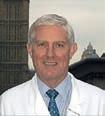
Professor Ciclitira has a particular interest in food allergy, including Coeliac disease, peptic ulcer, inflammatory bowel disorder, hepatology and general internal medicine. He undertakes expert witness instructions in cases relating to all of these conditions, acting on behalf of either claimant or defendant or as a Single Joint Expert.
T: 0207 603 3594 E: gastropjc@gmail.com W: www.profpaulciclitira.co.uk
Mr Jeremy Crew
MA MD BChir(Cantab) FRCS(Urol) Consultant Urological Surgeon

Mr Jeremy Crew has offered a medicolegal service for over sixteen years. He provides expert medical opinion, medico-legal reports and court attendance on all aspects of urology including clinical negligence, personal injury and criminal matters.
T: 01865 307433 or 07508 617949 E: jeremycrew@urologyoxford.com W: www.oxfordurology.co.uk
Dr Dan Jones
PhD MSc BSc MA MEWI Cert Ecological Consultant - Japanese Knotweed
Dr Dan Jones undertakes expert witness instructions, including the preparation of expert reports and giving evidence in court, in civil claims relating to the growth and spread of all invasive plants. He can act on behalf of either claimant or defendant or as a Single Joint Expert.
T: 07967 408844 E: daniel@advancedinvasives.com W: www.advancedinvasives.com
Laird Assessors Automotive Expert


Mr Robert Marston BSc(Hons) MBBS FRCS(Eng) FRCS(Edin) FRCS(ORTHO) Consultant Orthopaedic and Trauma Surgeon

Mr Marston has 25 years experience as an expert witness. His special interest is lower limb orthopaedics and trauma, particularly hip and knee arthroplasty, joint injuries and fractures. His main medico legal work is with alleged clinical negligence. He also takes on selected personal injury cases.
T: 07464 425 444 E: marstonmedicolegal@gmail.com W: www.marstonmedicalpractice.co.uk
Mr Luke Meleagros BSc MBBS MD FRCS Consultant Surgeon
Mr Meleagros completes around 6-10 expert reports per month, the majority in medical negligence cases and a smaller number of personal injury cases. He has reported extensively on cases involving abdominal laparoscopy surgery and hernia surgery.
T: 0208 527 0977 E: L.Meleagros@btinternet.com Sec: jawdobson@gmail.com

RSK
Materials and Structures
RSK offers impartial specialist materials and structures expertise in support of legal matters. Our team of consultants can act as expert witnesses on behalf of either claimant or defendant or as a Single Joint Expert in a range of construction disputes.

T: 01442 437500 E: info2@rsk.co.uk W: www.rskgroup.com

Laird Assessors are the UK’s leading independent automotive expert witness firm supporting claimant, defendant and criminal solicitors – from instruction to court. Laird provide intelligence to the automotive world predominantly relating to crashed vehicles.
T: 0151 342 9961 E: enquiries@laird-assessors.com
W: www.laird-assessors.com
Chris Makin FCA FCMI FAE QDR MCIArb
Chartered Accountant • Accredited Civil Mediator • Accredited Expert Determiner
Chris Makin was one of the first chartered accountants to become an Accredited Forensic Accountant and Expert Witness. He is also an accredited civil and commercial mediator and an accredited expert determiner. Over the last 30 years he has given expert evidence at least 100 times and worked on a vast range of cases.
T: 01924 495888 or 07887 660072 E: chris@chrismakin.co.uk W: www.chrismakin.co.uk

Target Psychology Ltd
Providing Expert Witness Reports and Assessments
Target Psychology provide exceptional reports and their highly trained team of expert psychologists and psychiatrists regularly take instructions from solicitors and local authorities, providing assessments for families and individuals involved in legal proceedings.
T: 0161 425 1826 E: office@targetpsychology.co.uk W: www.targetpsychology.co.uk



